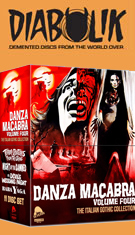
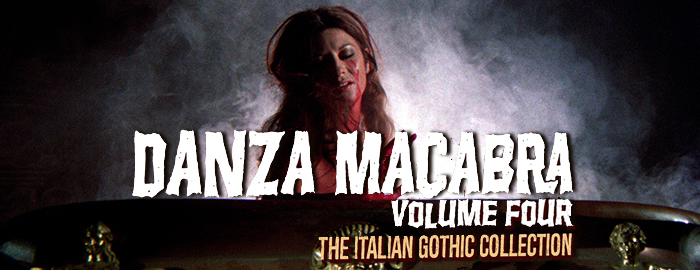
TERROR-CREATURES FROM THE GRAVE
B&W, 1965, 90 mins. 16 secs. / 83 mins. 56 secs.
Directed by Massimo Pupillo
Starring Barbara Steele,
Walter Brandi, Mirella Maravidi, Alfredo Rizzo, Luciano Pigozzi, Riccardo Garrone
Severin Films (UHD & Blu-ray) (US R0 4K/HD), Mafarka (Blu-ray) (Italy RB HD), Artus (DVD) (France R2 PAL) / WS (1.85:1) (16:9)
NIGHT OF THE DAMNED
Color, 1971, 100 mins. 16 secs.
Directed by Filippo Walter Ratti
Starring Pierre Brice, Patrizia Viotti, Angela De Leo, Antonio Pavan
Severin Films (UHD & Blu-ray) (US R0 4K/HD) / WS (1.85:1) (16:9)
THE DEVIL'S WEDDING NIGHT
Color, 1973, 84 mins. 2 secs.
Directed by Luigi Batzella
Starring Mark Damon, Rosalba Neri, Esmeralda Barros, Xiro Papas, Gengher Gatti
Severin Films (UHD & Blu-ray) (US R0 4K/HD), Code Red (Blu-ray) (US R0 HD) / WS (1.78:1) (16:9), Artus (France R2 PAL) / WS (1.85:1) (16:9), Shout Factory (US R1 NTSC) / WS (1.85:1)
BABA YAGA
Color, 1973, 82 mins. 25 secs.
Directed by Corrado Farina
Starring Carroll Baker, Isabelle de Fun s, George Eastman, Ely Galleani
Severin Films (UHD & Blu-ray) (US R0 4K/HD), Blue Underground
(Blu-ray & DVD) (US
R0 HD/NTSC), Shameless (UK R0 PAL), Surf (Italy R2 PAL) / WS (1.85:1) (16:9), Diamond, St. Clair (US R0 NTSC)
After stopping off in 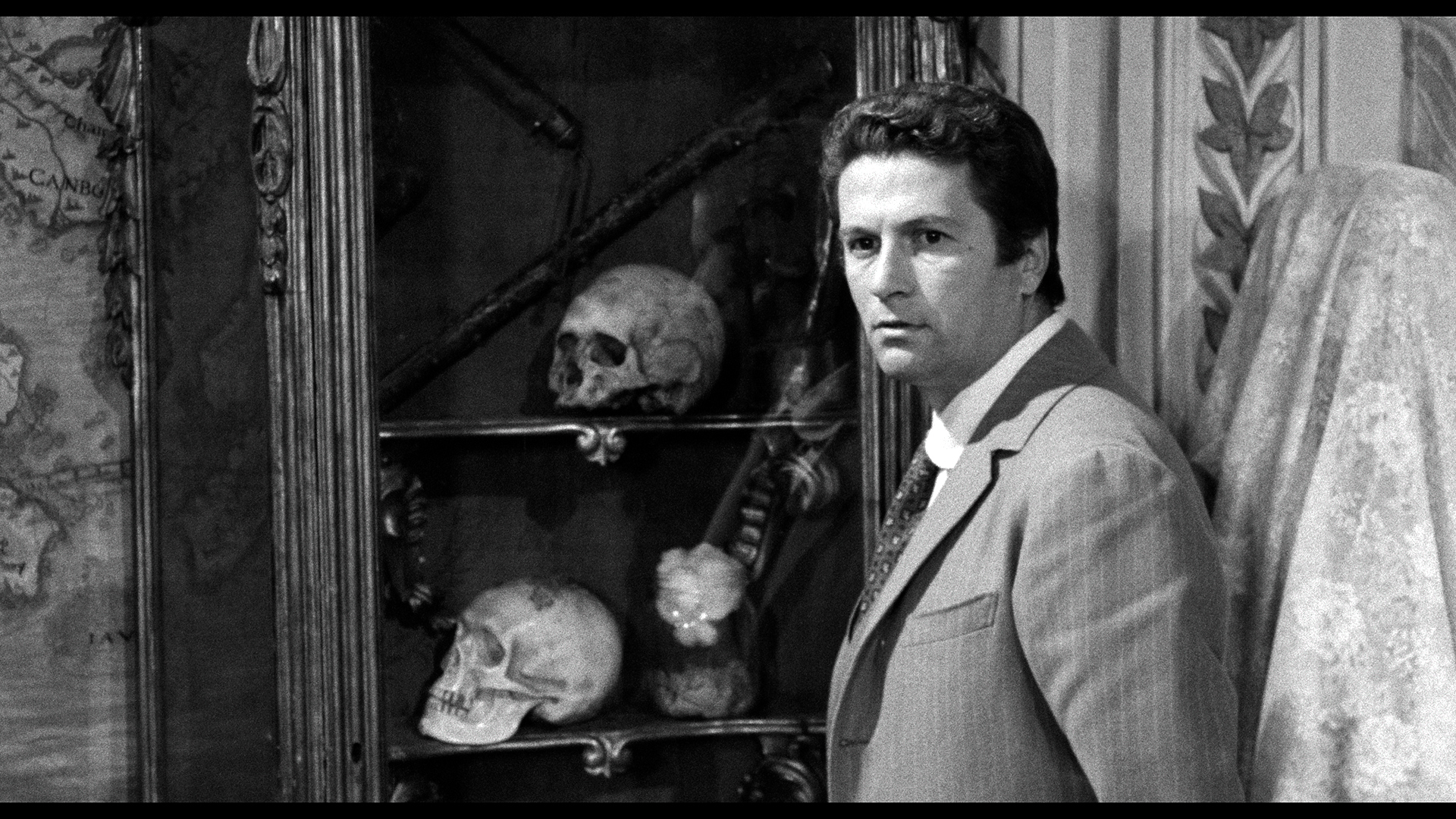 Spain for its third entry, Severin Films' essential Danza Macabra series of Euro-Gothic tastiness
Spain for its third entry, Severin Films' essential Danza Macabra series of Euro-Gothic tastiness 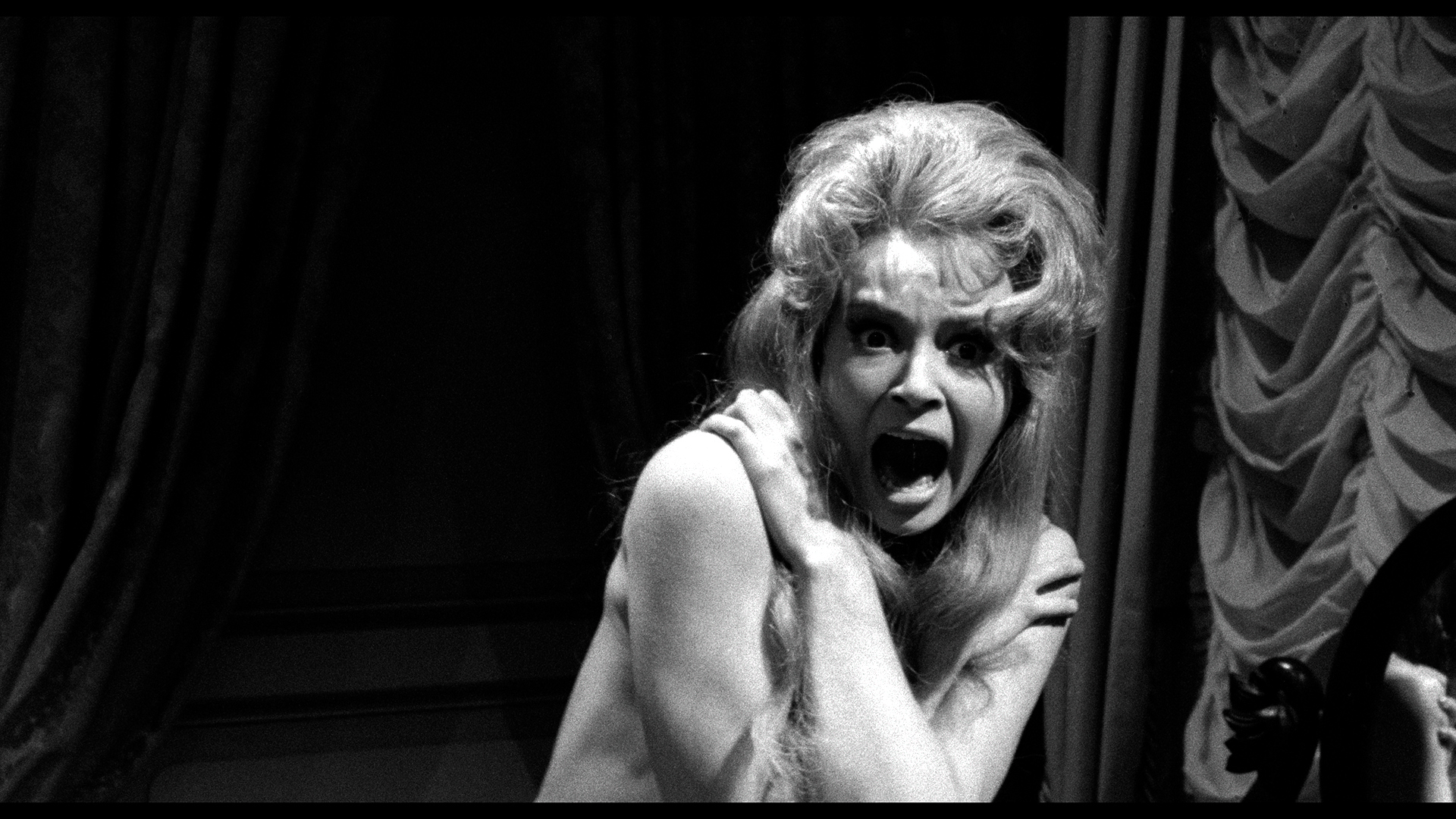 returns to Italy with the fourth volume featuring three familiar but significantly upgraded titles and one rarity finally salvaged from gray market purgatory The set also serves as a nice tour of where Italian horror style evolved from the mid-'60s into the more debauched '70s, with the switch to color resulting in flamboyant spectacles whose reputations continue to escalate.
returns to Italy with the fourth volume featuring three familiar but significantly upgraded titles and one rarity finally salvaged from gray market purgatory The set also serves as a nice tour of where Italian horror style evolved from the mid-'60s into the more debauched '70s, with the switch to color resulting in flamboyant spectacles whose reputations continue to escalate.
First up is a title that's floated around on the public domain scene for ages, at least in its U.S. 1967 theatrical version which was modified significantly from its original Italian cut two years earlier. Terror-Creatures from the Grave, originally shot as Cinque tombe per un medium (or Five Graves for a Medium), is another sterling showcase for Barbara Steele the same year as her beloved dual roles in Nightmare Castle. Her scream queen days in Italy were winding down by this point (followed only by The She-Beast and An Angel for Satan in '66), but you'd hardly guess it here. Something is amiss at the sprawling Hauff estate, which is connected to recent mysterious deaths in the wake of its patriarch's well-concealed passing a year ago. His bubble bath-loving widow, Cleo (Steele), and daughter Corinne (Maravidi) still reside there with the servants-- including the always shifty Luciano Pigozzi as butler Kurt, so you know things must be bad. Among the late master's decorations in the house is a rack of severed hands belonging to plague victims and supposedly imbued with occult powers, and it's 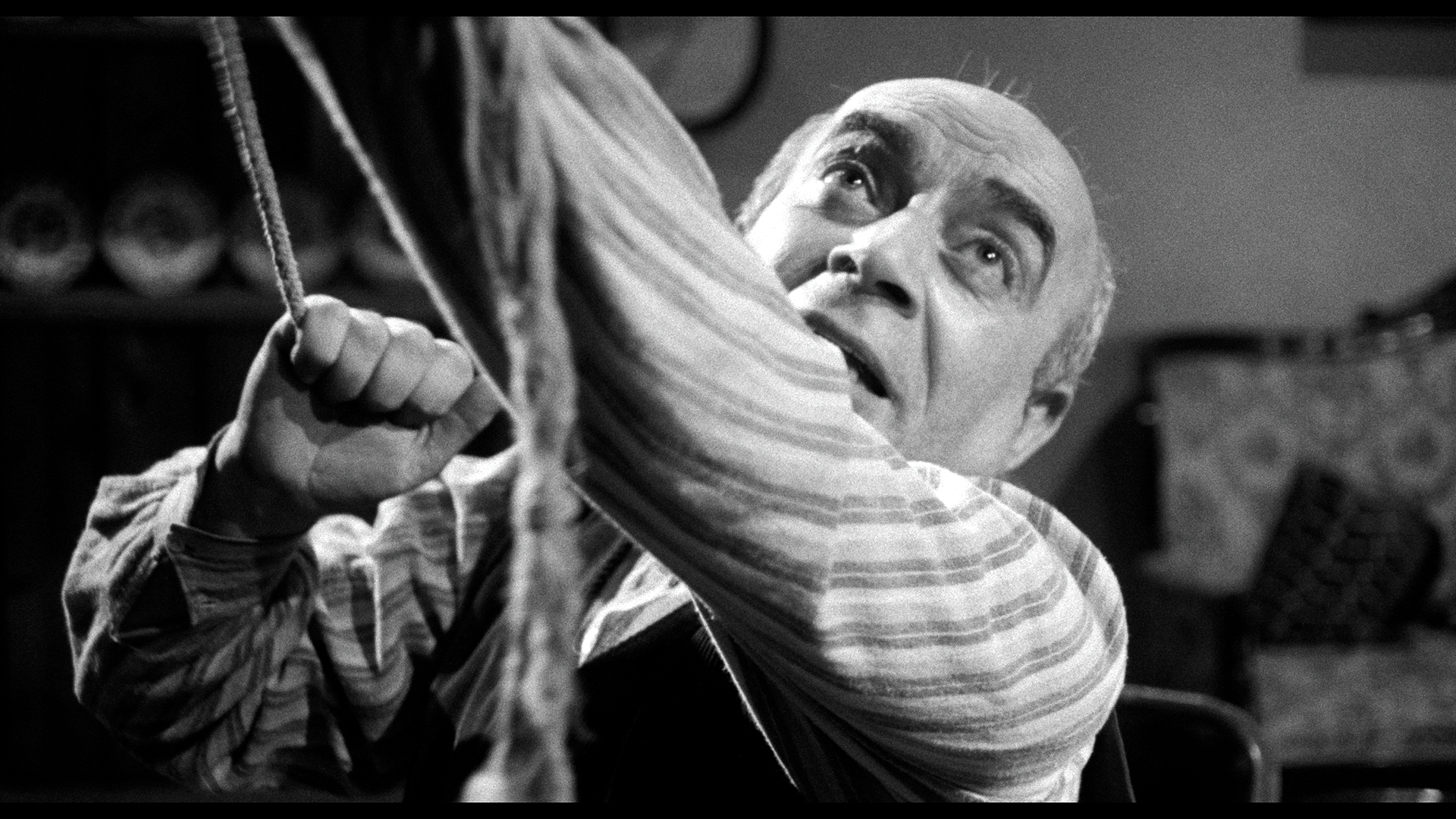 up to newly arrived attorney
up to newly arrived attorney 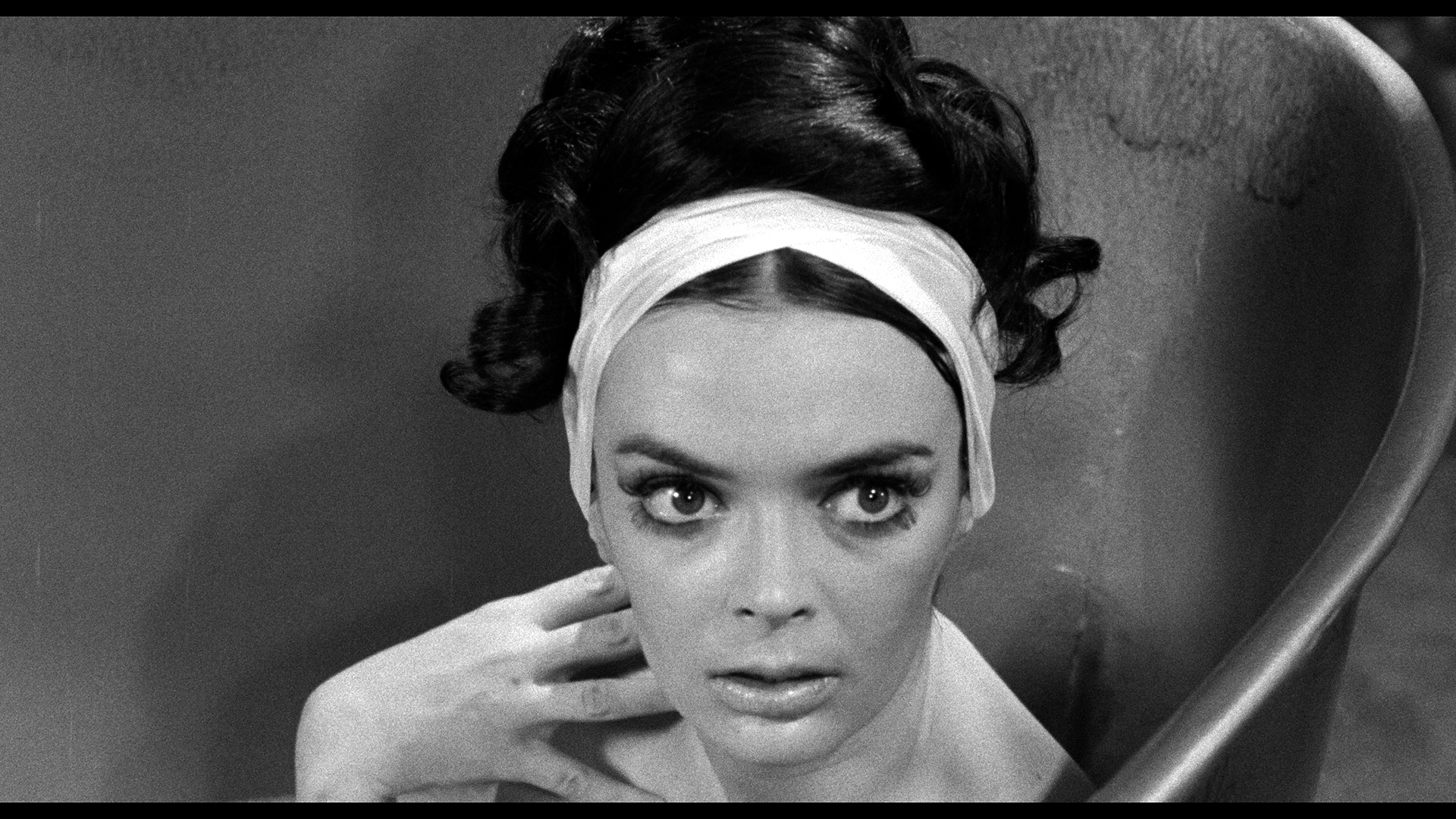 Albert (The Vampire and the Ballerina's Brandi) to sort through all the perplexing clues and fatalities.
Albert (The Vampire and the Ballerina's Brandi) to sort through all the perplexing clues and fatalities.
If you love black-and-white Gothics and/or Barbara Steele, this one will be right up your alley as it wallows in spooky atmosphere and sparing but gruesome shocks that lead to a lively final ten minutes. Exactly how gruesome it is depends on which version you see, since the U.S. version credited to American producer Ralph Zucker spiced things up by adding a bloody facial horse trampling before the credits and shooting a new demise for a suicide hanging in the original cut. The Italian version directed by Massimo Pupillo (Bloody Pit of Horror, Lady Morgan's Vengeance) is much more gradual getting to the horrific stuff, and its performances fare better since almost everyone besides Steele was speaking Italian. The English dub is a lot clunkier but fun in a drive-in sort of way, and both versions are worth checking out to see how differently the film played on different sides of the pond (including the actual nature of the "terror-creatures" themselves). That U.S. cut has been a public domain mainstay for decades from companies like Sinister Cinema, Something Weird, Alpha Video, and so on, with an HD scan of it first turning up as a bonus feature on Severin's Nightmare Castle Blu-ray. The Italian version was released on DVD in France from Artus, which wasn't English friendly but got outfitted with custom subtitles and as much of the English dub as possible on the gray market. A very limited Italian Blu-ray of mysterious origins appeared in 2020 from Mafarka, taken from a damaged but decent film print in Italian only.
For years this title 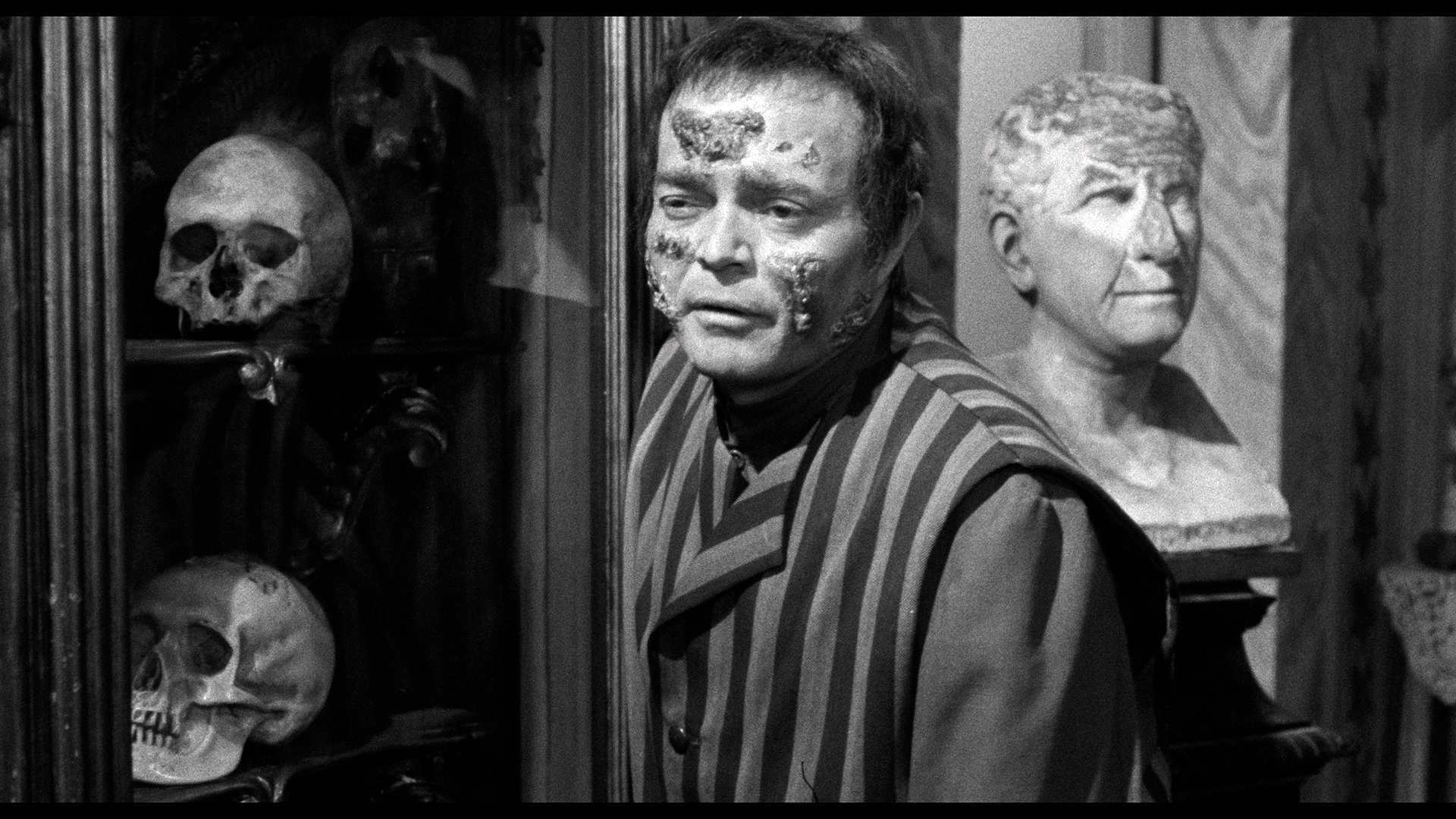 was said to be in the works for a U.S. release by Severin, which finally came to pass in 2025 as part of this four-film set either
was said to be in the works for a U.S. release by Severin, which finally came to pass in 2025 as part of this four-film set either 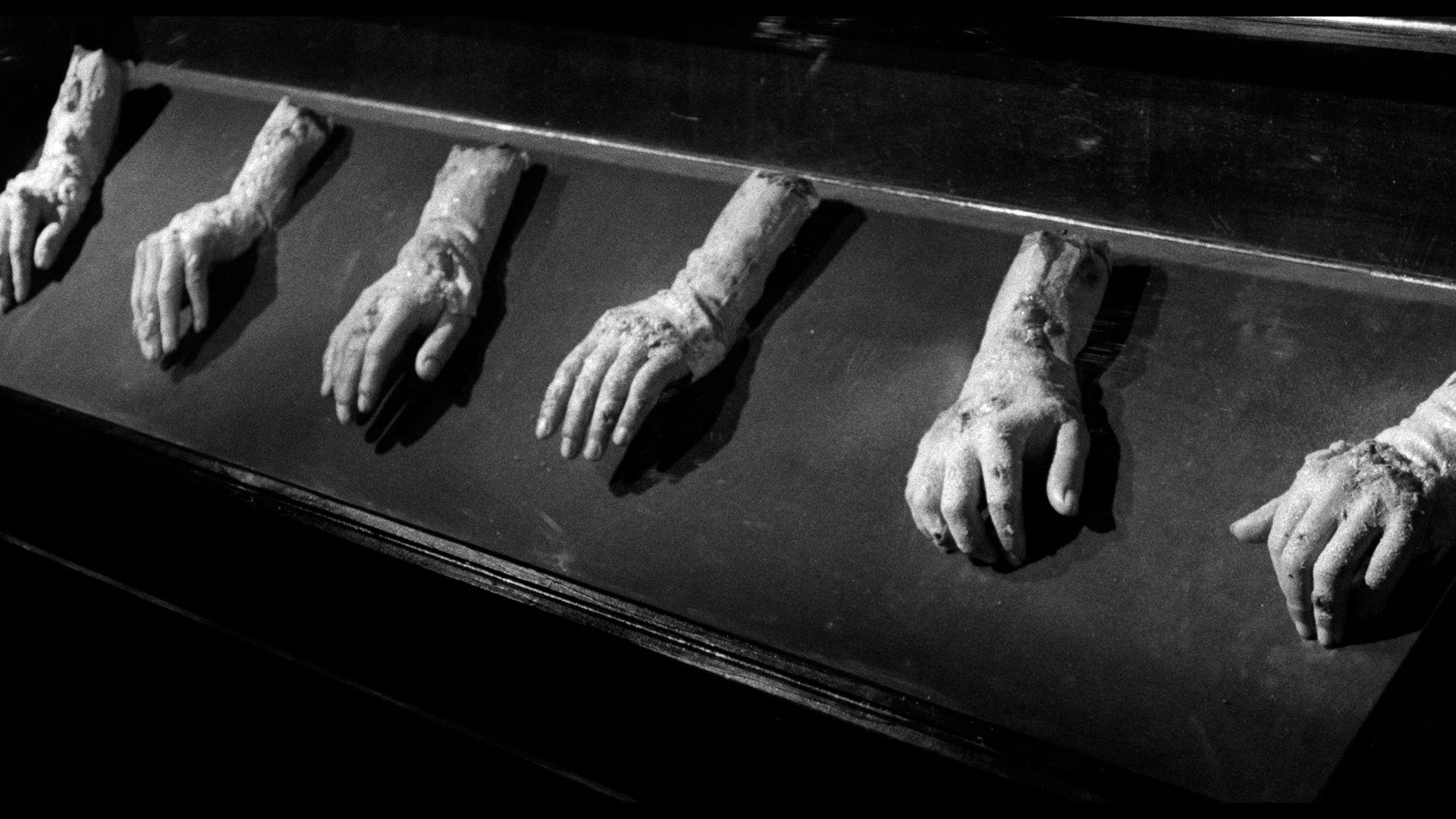 as a UHD and Blu-ray option or just Blu-ray. The UHD for Terror-Creatures and the first Blu-ray are devoted both cuts of the film in 4K scans from the negative, boasting far more detail and richer contrast than anything out there before. The Italian version can be played either completely in Italian with translated English subtitles or in English with subtitles appearing for the footage that exists only in Italian; that includes the opening couple of minutes, so don't be surprised. For some reason the UHD menu had issues loading up on an Oppo player for this review but no other similar reports seem to be out there, so it may be a one-off glitch. The Italian cut also comes with a new audio commentary with Rod Barnett and Adrian Smith who do a strong job of covering all the essentials of the film including Steele and the director, the skills of dubbing artist and actor Carolyn De Fonseca, connected Italian Gothics of the period, and more. The video extras are all on the second Blu-ray starting with "Grave Secrets" (26m15s) featuring actor Riccardo Garrone (who's hilariously candid and disparaging about the film) and film historian Fabio Melelli, plus audio interview extracts with Pupillo, which cover the production, the whole "Zucker" story, and takes on the film that can induce whiplash in their dramatic differences. Then you get a selected scene commentary with Steele and Russ Lanier (26m23s); as usual she opens up by saying she remembers very little about the film but chats in general about her time in Italy and France around that time. She does have tidbits about a few of the personnel though, naming a few favorites and chatting about the locale and Pupillo as a director. In "Grave Influence" (14m38s), The Vatican Versus Horror Movies author Matt Rogerson examines the links between this and other plague narratives like The Masque of the Red Death, the use of classic thriller elements like the dead but controlling patriarch, and other literary and cinematic antecedents. Finally in "The Original Boutique Video Label" (9m28s), Alan Jones looks back at the early pre-cert U.K. video label who brought numerous U.K. and Italian genre films to the public including this one and films by Peter Walker, Mario Bava,
as a UHD and Blu-ray option or just Blu-ray. The UHD for Terror-Creatures and the first Blu-ray are devoted both cuts of the film in 4K scans from the negative, boasting far more detail and richer contrast than anything out there before. The Italian version can be played either completely in Italian with translated English subtitles or in English with subtitles appearing for the footage that exists only in Italian; that includes the opening couple of minutes, so don't be surprised. For some reason the UHD menu had issues loading up on an Oppo player for this review but no other similar reports seem to be out there, so it may be a one-off glitch. The Italian cut also comes with a new audio commentary with Rod Barnett and Adrian Smith who do a strong job of covering all the essentials of the film including Steele and the director, the skills of dubbing artist and actor Carolyn De Fonseca, connected Italian Gothics of the period, and more. The video extras are all on the second Blu-ray starting with "Grave Secrets" (26m15s) featuring actor Riccardo Garrone (who's hilariously candid and disparaging about the film) and film historian Fabio Melelli, plus audio interview extracts with Pupillo, which cover the production, the whole "Zucker" story, and takes on the film that can induce whiplash in their dramatic differences. Then you get a selected scene commentary with Steele and Russ Lanier (26m23s); as usual she opens up by saying she remembers very little about the film but chats in general about her time in Italy and France around that time. She does have tidbits about a few of the personnel though, naming a few favorites and chatting about the locale and Pupillo as a director. In "Grave Influence" (14m38s), The Vatican Versus Horror Movies author Matt Rogerson examines the links between this and other plague narratives like The Masque of the Red Death, the use of classic thriller elements like the dead but controlling patriarch, and other literary and cinematic antecedents. Finally in "The Original Boutique Video Label" (9m28s), Alan Jones looks back at the early pre-cert U.K. video label who brought numerous U.K. and Italian genre films to the public including this one and films by Peter Walker, Mario Bava, 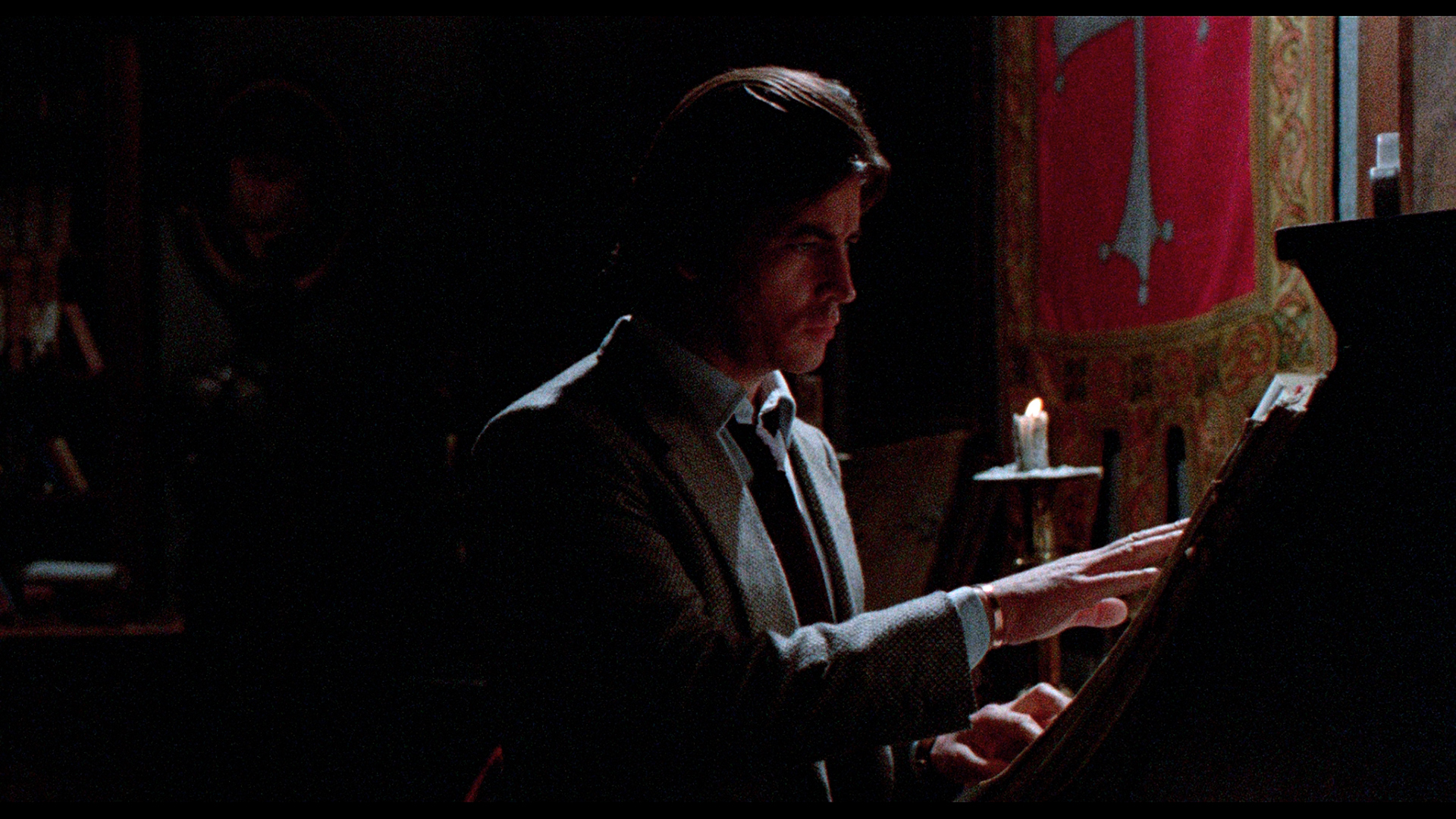 Lucio Fulci, Dario Argento, and
Lucio Fulci, Dario Argento, and 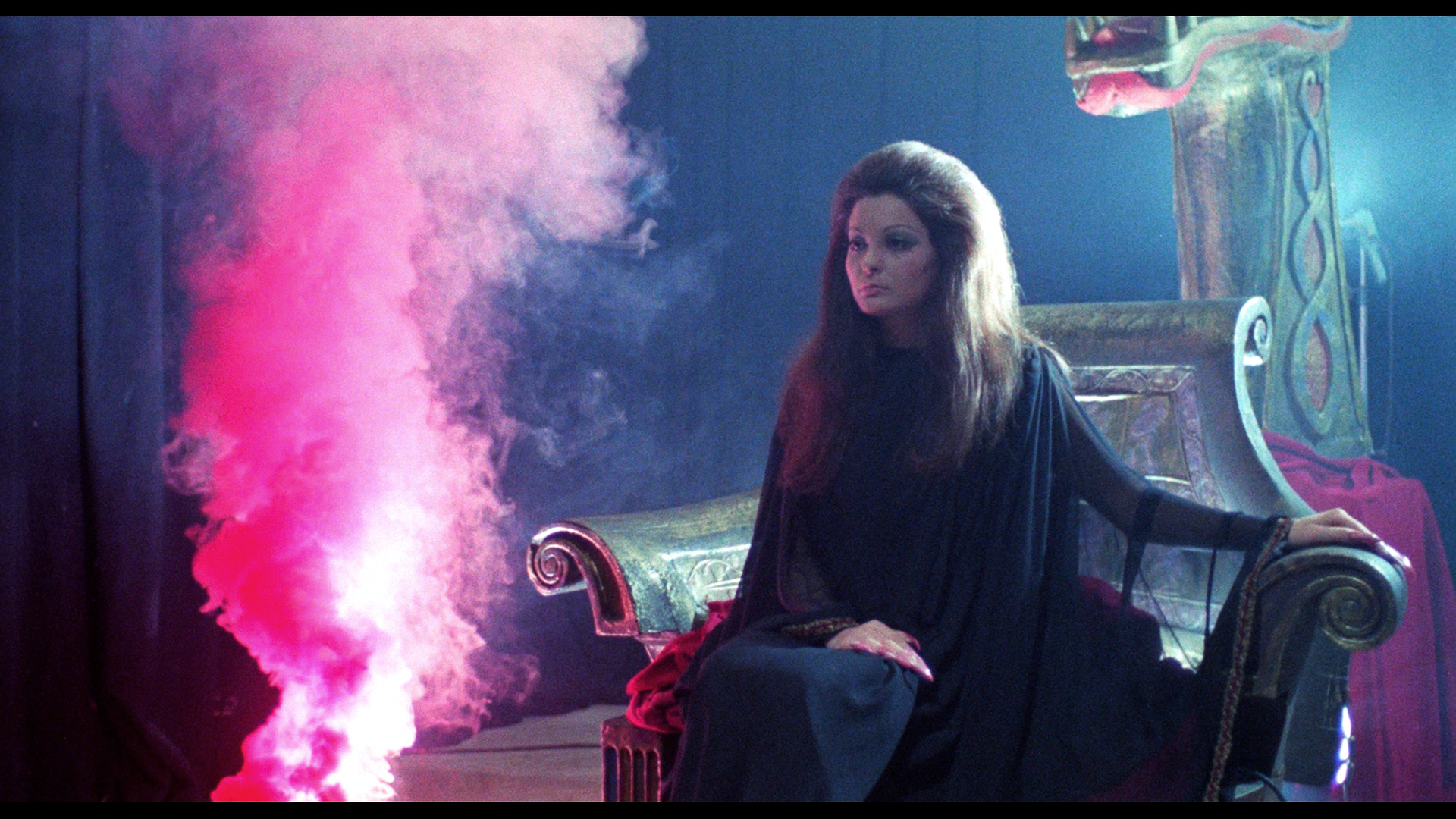 more. The U.S. and European trailers are also included in nice HD scans, the latter as Tombs of Horror and both trying their best to pass this off as an Edgar Allan Poe adaptation.
more. The U.S. and European trailers are also included in nice HD scans, the latter as Tombs of Horror and both trying their best to pass this off as an Edgar Allan Poe adaptation.
Easily one of the least-seen Euro horror films to hit UHD, 1971's The Night of the Damned (La notte dei dannati) is a very wild sex and horror stew diving into the trendy Satanic orgy imagery of the time coupled with a colorful, pulp visual approach that makes it a treat to watch. Jazzed up with Carlo Savina's score from Malenka, it's the story of reporter Jean (Brice, Winnetou himself) and his wife Danielle (Death Falls Lightly's Viotti) who get an enigmatic letter from one of old friends, a now-reclusive prince. They decide to go pay a visit and encounter a strange home run by Rita (De Leo), the prince's wife, who seems to be connected to the occult. Inexplicable deaths begin, Danielle is plagued by nightmares involving execution by fire, and an ancient family secret soon comes to light.
Though you'll probably see all the plot twists coming far away, The Night of the Damned is far more interested in sheer carnal and visual excess with its very lengthy and intense scenes of 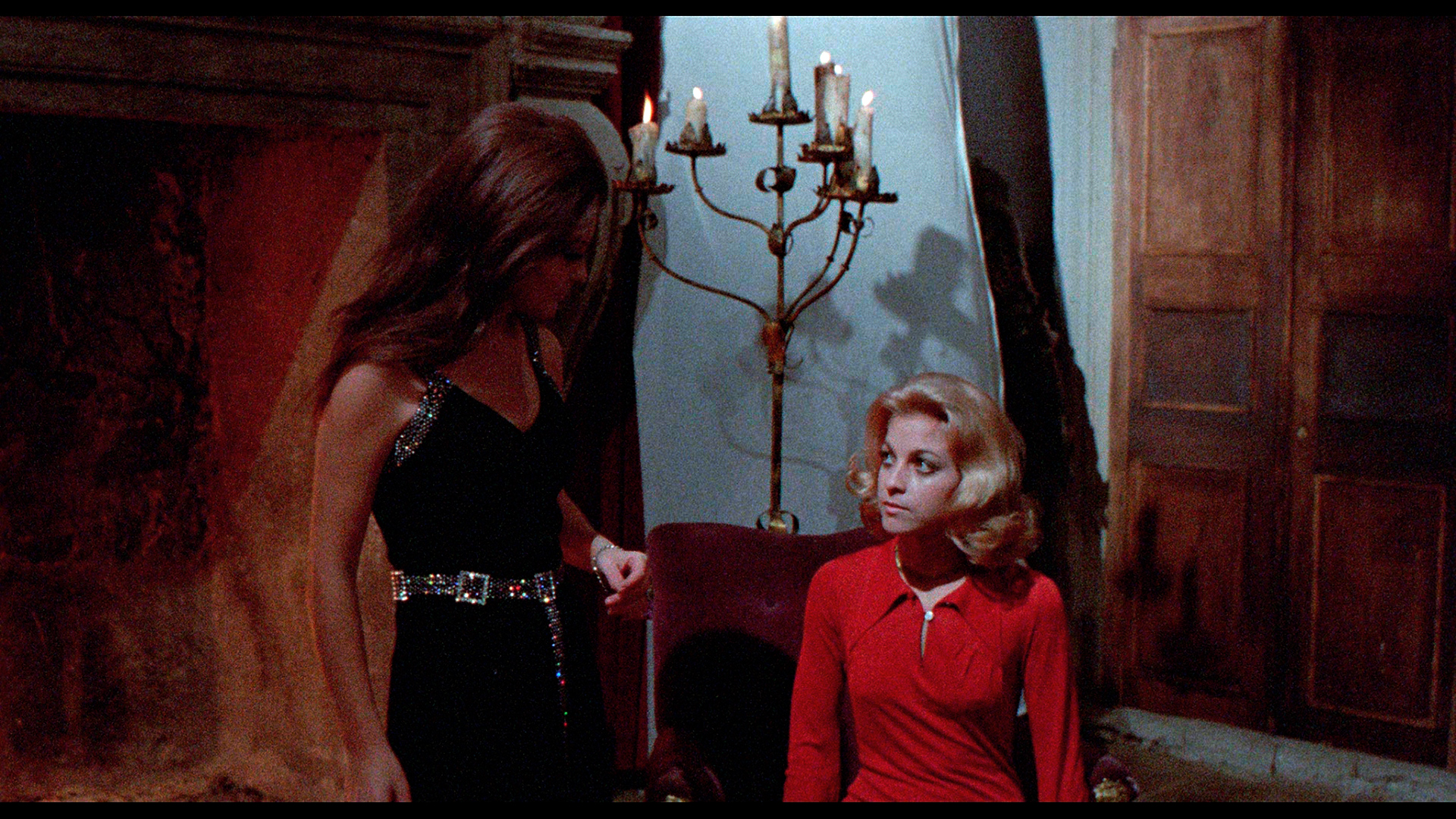 mostly all-female coupling causing censorship issues at home when it was finished. The bootleg versions of this film came in just shy of 90 minutes, but the restored version here from the original negative is considerably longer and more explicit with
mostly all-female coupling causing censorship issues at home when it was finished. The bootleg versions of this film came in just shy of 90 minutes, but the restored version here from the original negative is considerably longer and more explicit with 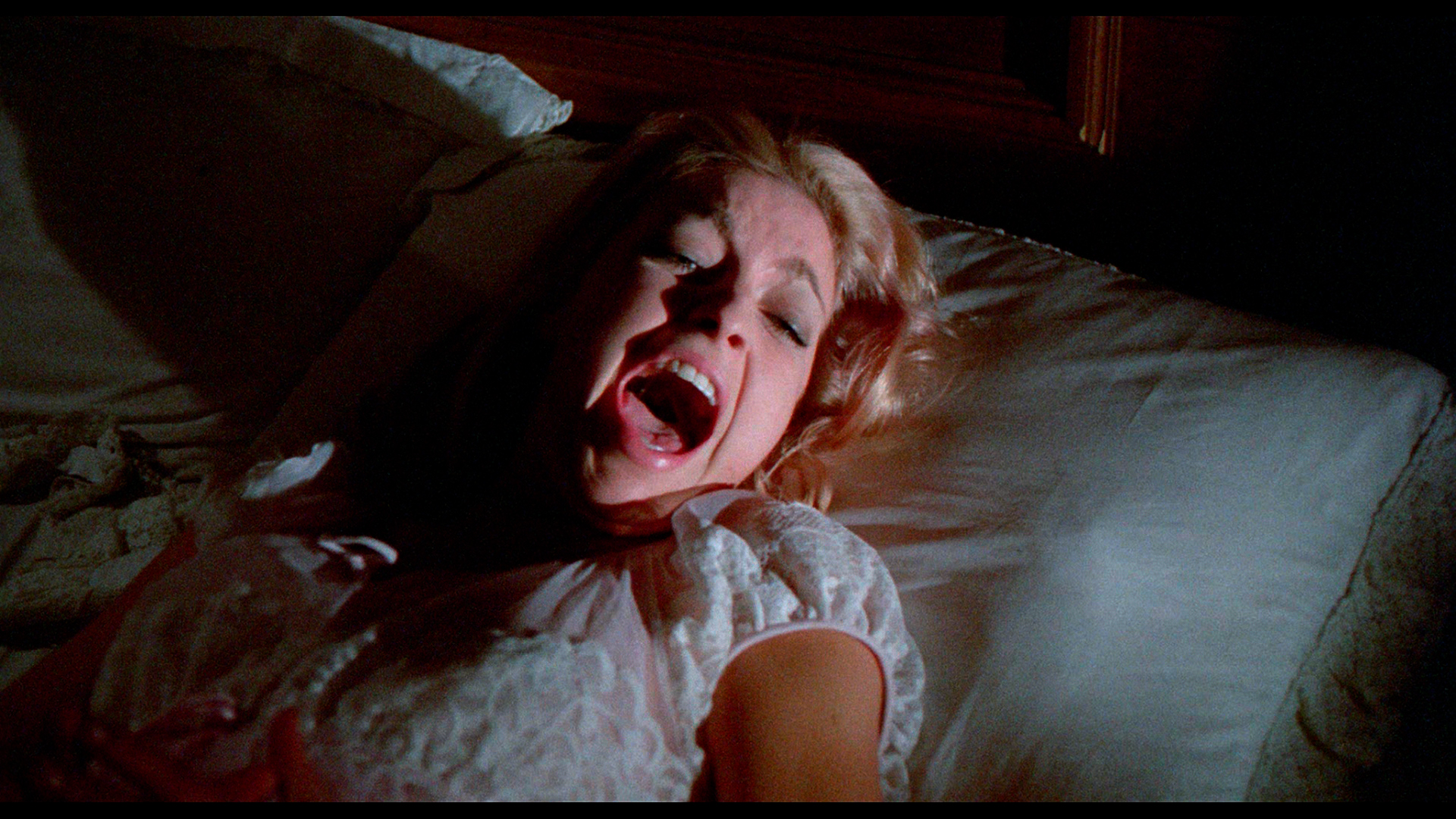 several moments that push the definition of softcore very far for a '71 film. Incredibly, this release (the film's first legit commercial appearance, it would seem, not counting a sketchy Italian VHS) also throws in an even more graphic 14m18s reel of silent orgy outtakes... strictly for historical value, of course. It's very weird seeing a mainstream European star like Brice wandering around dark corridors and sleuthing in libraries while all this is going on, but that's also part of the fun.
several moments that push the definition of softcore very far for a '71 film. Incredibly, this release (the film's first legit commercial appearance, it would seem, not counting a sketchy Italian VHS) also throws in an even more graphic 14m18s reel of silent orgy outtakes... strictly for historical value, of course. It's very weird seeing a mainstream European star like Brice wandering around dark corridors and sleuthing in libraries while all this is going on, but that's also part of the fun.
The UHD and Blu-ray feature a stunning presentation of the film from the original negative, and to say this feels like a whole different experience here is putting it mildly. As with the other films in the set, the HDR10 grading on the UHD really puts it over the top with a depth and intensity to the colors (especially the sparing but wild gel lighting). Both English and Italian audio options are included (DTS-HD MA 2.0 mono) 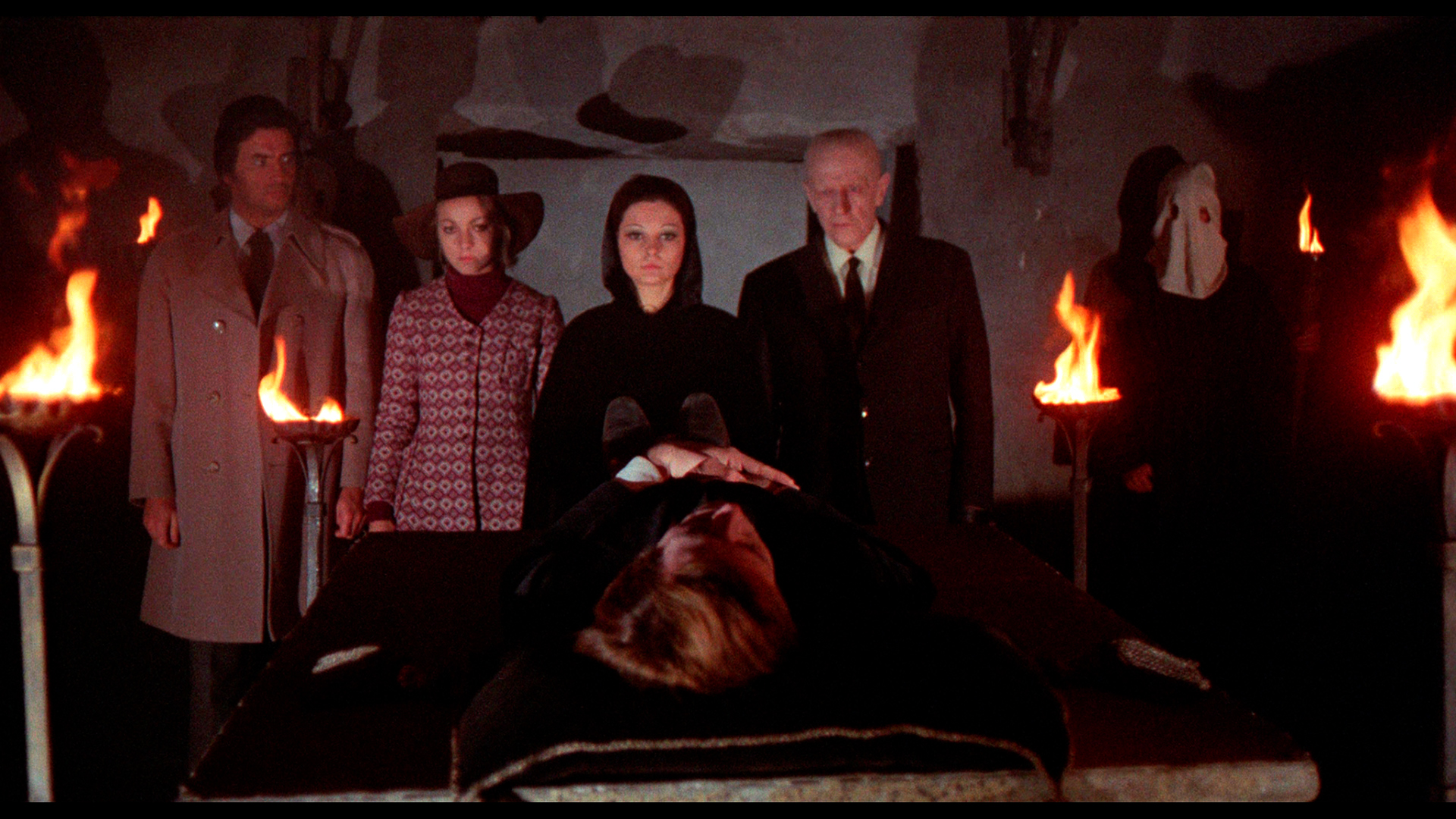 and sound good; the film was dubbed either way with the Italian version sounding more natural and classy. (Whether that's a selling point is up to your personal taste). Barnett and Troy Guinn do the commentary honors here, covering the film's low-budget creation, the evolution of its title and marginal release, the Eurocult credentials of the small cast and crew, and genre
and sound good; the film was dubbed either way with the Italian version sounding more natural and classy. (Whether that's a selling point is up to your personal taste). Barnett and Troy Guinn do the commentary honors here, covering the film's low-budget creation, the evolution of its title and marginal release, the Eurocult credentials of the small cast and crew, and genre 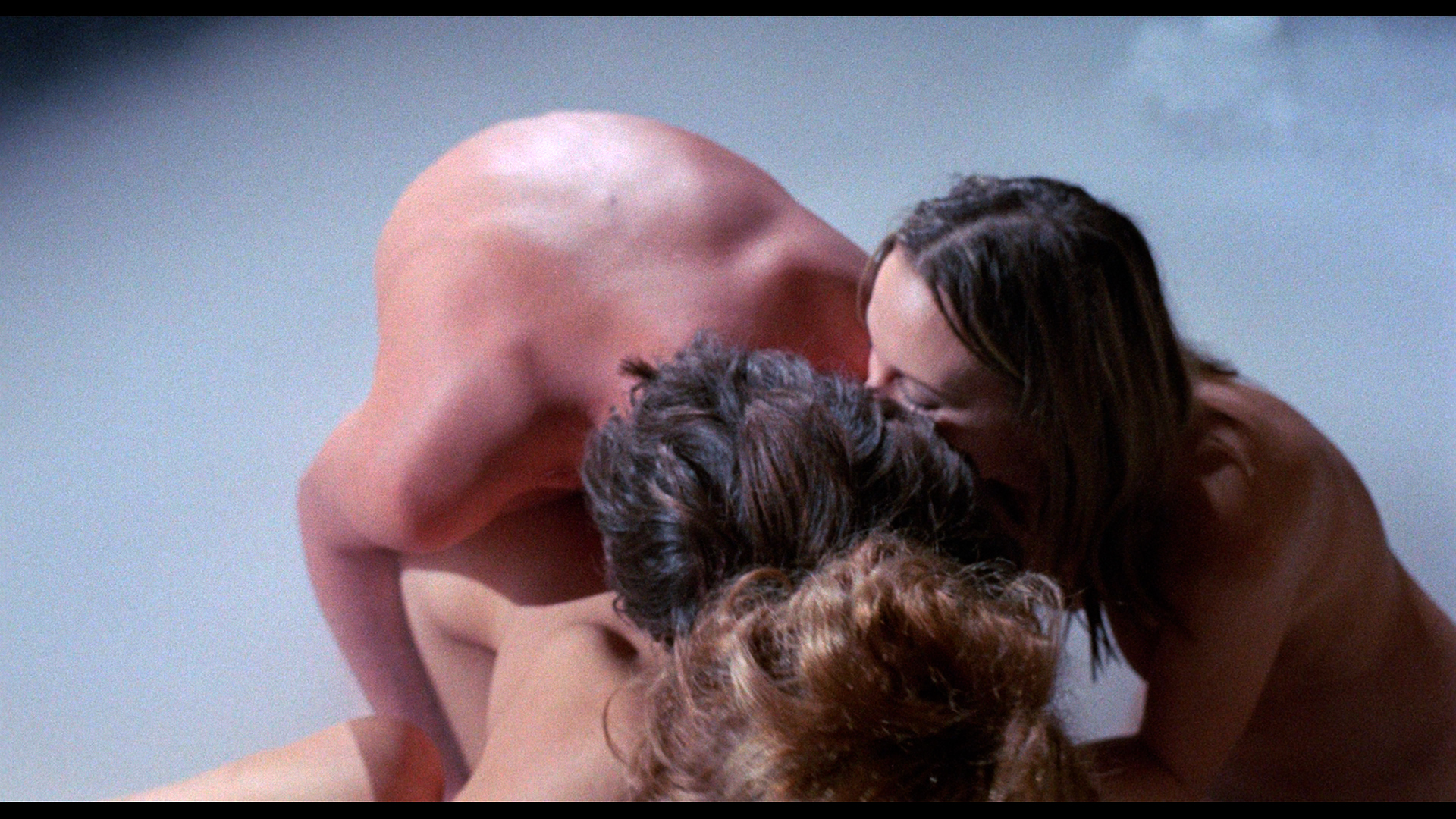 milestones that likely inspired it. "In the Castle of Saint Lambert (16m54s) features Fabio Melelli chatting about the film's creation at the height of the giallo craze, the background of the screenwriters, director Filippo Ratti, the nods to earlier literature, and intellectual credentials here that might surprise you and explain the role of Beaudelaire in the plot. In "The Desired and the Damned" (18m40s), Rogerson returns to examine the role of the witch in Italian genre films (Suspiria, Black Sunday, etc.) and this film's place in that distinctive lineage. An English-language trailer is also included.
milestones that likely inspired it. "In the Castle of Saint Lambert (16m54s) features Fabio Melelli chatting about the film's creation at the height of the giallo craze, the background of the screenwriters, director Filippo Ratti, the nods to earlier literature, and intellectual credentials here that might surprise you and explain the role of Beaudelaire in the plot. In "The Desired and the Damned" (18m40s), Rogerson returns to examine the role of the witch in Italian genre films (Suspiria, Black Sunday, etc.) and this film's place in that distinctive lineage. An English-language trailer is also included.
Few Italian horror films of the '70s have had the peculiar staying power of our next film, The Devil's Wedding Night, a gaudy throwback to the spooky castle horrors of the previous decade spiced up here with tons of nudity and lesbian titillation along with a few dollops of blood. Director Luigi Batzella was mainly known for westerns when he tackled this film, whose success led to even more outrageous subsequent shockers like Nude for Satan and the particularly foul The Beast in Heat. Even the casting is a sort of melding of the two waves of Italian horror as Mark Damon, the star of The Fall of the House of Usher who trotted 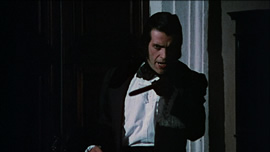 over to Italy to star in Black Sabbath and a slew of spaghetti westerns, is paired up with stunning giallo queen Rosalba Neri (billed here as "Sara Bay"). Familiar from such outings as Amuck, Slaughter Hotel,
over to Italy to star in Black Sabbath and a slew of spaghetti westerns, is paired up with stunning giallo queen Rosalba Neri (billed here as "Sara Bay"). Familiar from such outings as Amuck, Slaughter Hotel, 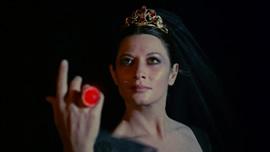 and Lady Frankenstein, she's a force to be reckoned with here as a sort of Elizabeth Bathory figure who holds unholy ceremonies every five decades on the Night of the Virgin Moon (the source of the film's Italian title, Il plenilunio delle vergini), when a quintet of local, undefiled maidens convene for a demonic ritual.
and Lady Frankenstein, she's a force to be reckoned with here as a sort of Elizabeth Bathory figure who holds unholy ceremonies every five decades on the Night of the Virgin Moon (the source of the film's Italian title, Il plenilunio delle vergini), when a quintet of local, undefiled maidens convene for a demonic ritual.
Of course, that night is about to fall again when a scholar named Karl (Damon) arrives in Transylvania in search of the mythical Ring of the Nibelungen, only to cross paths with his more debauched twin brother, Franz (also Damon). While Karl commiserates with the pretty daughter (Barros) of the innkeeper, he and Franz are also lured by the wicked countess (Neri) who has a habit of slipping a creepy, glowing red ring on her partners' hands after bedding them at night. As it turns out, she wields the supernatural ring of Dracula, which bestows great satanic power as long as the appropriate sacrifices are kept in check.
The threadbare plot here is mainly an excuse to deliver lots of thunder, lightning, and bare flesh, with Neri stealing the show halfway through with an astonishing scene in which she rises from a stone tomb clad only in billowing fog and the virgin blood her servant has 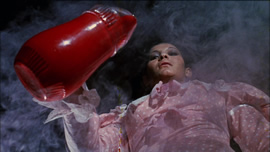 poured all over her. Damon doesn't get to show
poured all over her. Damon doesn't get to show 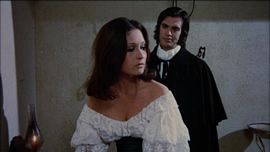 much range in either role, but it hardly matters as the film ladles on the exploitation like gravy complete with an aggressive music score by Vasili Kojucharov (Byleth), workmanlike but sometimes moody cinematography by the one and only Joe D'Amato, and a bizarre turn by Frankenstein's Castle of Freaks' Xiro Papas as a sort of vampire zombie monstery thingy.
much range in either role, but it hardly matters as the film ladles on the exploitation like gravy complete with an aggressive music score by Vasili Kojucharov (Byleth), workmanlike but sometimes moody cinematography by the one and only Joe D'Amato, and a bizarre turn by Frankenstein's Castle of Freaks' Xiro Papas as a sort of vampire zombie monstery thingy.
Apparently all these elements were enough to ensure exploitation immortality for this film, which played for what seemed like an eternity on drive-in double bills and, thanks to presumed public domain status for a while, became both a home video and TV staple. Elvira, Mistress of the Dark gave it a go on her Movie Macabre show (with the nudity trimmed, obviously), and companies like Sinister Cinema and Wizard kept it circulating on VHS for years. A letterboxed Japanese VHS also became a favorite on the fan circuit well into the '90s, too, complete with a fleeting extra shot of errant, limb-chopping gore. On DVD, Shout Factory included it as part of their Elvira line in both its hosted and theatrical forms, while Alpha churned out a rotten bargain bin release best avoided entirely. In 2014, a French-language release with no English options surfaced on French DVD, followed by a 2015 Blu-ray from Code Red. The new HD transfer from a U.S. print looks 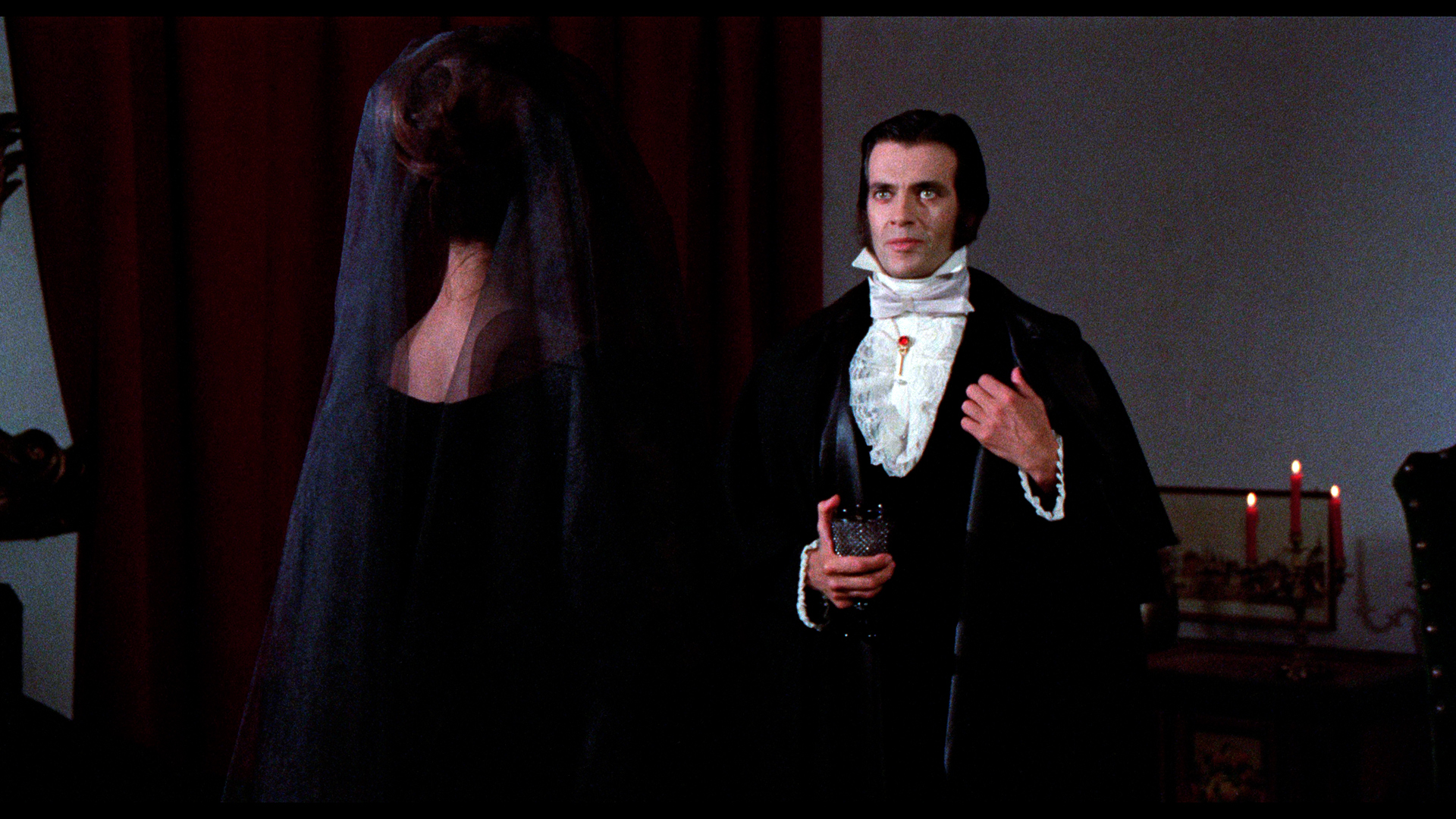 nice overall with a '70s grittiness to the textures, while black levels are nice and deep as they should be with those eye-popping
nice overall with a '70s grittiness to the textures, while black levels are nice and deep as they should be with those eye-popping 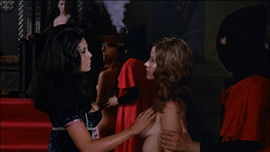 shades of ruby red looking particularly nice. Two reels display a thin line of orange-colored damage popping in and out a few times, most egregiously around the 36-minute mark. The English track, which works pretty well since that's what almost everyone spoke even if they were looped later, is presented in DTS-HD MA 2.0 mono and sounds okay as well. The film can be played in a "Katarina's Bucket List" mode with hostess Katarina Leigh Waters as both herself and her twin (of course), trying to find directions through the woods and taking possession of a really big ring before supplying the usual rundown of the major players in front of and behind the camera. She also has to deal with diabolical foodstuff, and that errant Japanese footage turns up tucked away at the end as well.
shades of ruby red looking particularly nice. Two reels display a thin line of orange-colored damage popping in and out a few times, most egregiously around the 36-minute mark. The English track, which works pretty well since that's what almost everyone spoke even if they were looped later, is presented in DTS-HD MA 2.0 mono and sounds okay as well. The film can be played in a "Katarina's Bucket List" mode with hostess Katarina Leigh Waters as both herself and her twin (of course), trying to find directions through the woods and taking possession of a really big ring before supplying the usual rundown of the major players in front of and behind the camera. She also has to deal with diabolical foodstuff, and that errant Japanese footage turns up tucked away at the end as well.
The Severin UHD and Blu-ray are transferred from the original negative for the first time, and you can rest easy despite the opening disclaimer about some unavoidable damage to the element; any flaws here are fleeting and very minor. There's more image info in the frame, detail gets upped quite a bit, and the color is more natural yet vivid throughout. Both the DTS-HD MA 2.0 mono English and Italian tracks sound fine and free of distortion, with optional English SDH or translated subtitles. A new commentary by Kat Ellinger and Martyn Conterio is a packed tour through the film's "bonkers" use of Gothic elements, the 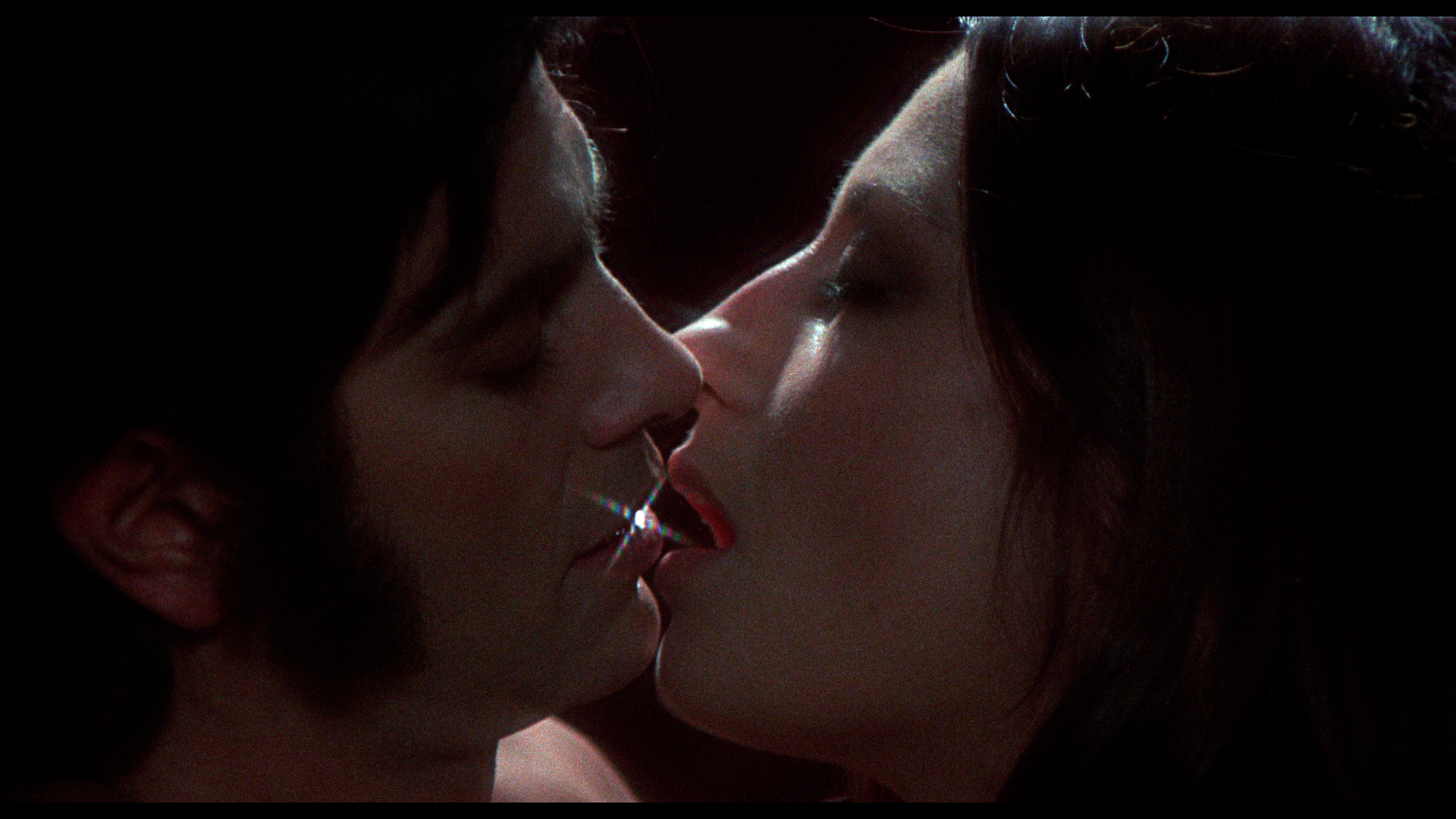
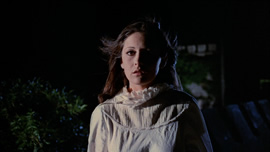 dedication Damon brought to his performance(s), Neri's busy career at the time, the odd vampire elements here indebted to Stoker onward, and of course, the Italian horror milestones that paved the way for this, and more. In "Countess Rosalba" (12m58s), Neri briefly covers her path to acting including her school and TV commercial work before talking about being a sailor around the time she made this film (and for which she would ultimately turn to instead of acting), the ideas she brought on the set like illuminating her magic ring with a light, and memories of her collaborators including her multiple productions with D'Amato (a.k.a. Aristide Massachessi). In fact, that's who pops up next in "The Wedding Guest" (4m7s) to talk about his early work as a cinematographer, his move into directing with portions of The Arena (also with Neri), his collaboration with Batzella (credited as "Paolo Solvay"), and his assessment of Neri as a "poor man's Barbara Steele," which is... highly debatable! Then producer Franco Gaudenzi appears in "The Wedding Tale" (12m53s) to cover this film in context with the more daunting The Arena, Damon's heavy involvement in getting this film off the ground ("basically a Dracula movie"), and being insistent on keeping D'Amato on board to shoot it. Alexandra Heller-Nicholas delivers "An Open Letter to Rosalba Neri's Tits" (11m15s), followed by the English-language European and U.S. trailers.
dedication Damon brought to his performance(s), Neri's busy career at the time, the odd vampire elements here indebted to Stoker onward, and of course, the Italian horror milestones that paved the way for this, and more. In "Countess Rosalba" (12m58s), Neri briefly covers her path to acting including her school and TV commercial work before talking about being a sailor around the time she made this film (and for which she would ultimately turn to instead of acting), the ideas she brought on the set like illuminating her magic ring with a light, and memories of her collaborators including her multiple productions with D'Amato (a.k.a. Aristide Massachessi). In fact, that's who pops up next in "The Wedding Guest" (4m7s) to talk about his early work as a cinematographer, his move into directing with portions of The Arena (also with Neri), his collaboration with Batzella (credited as "Paolo Solvay"), and his assessment of Neri as a "poor man's Barbara Steele," which is... highly debatable! Then producer Franco Gaudenzi appears in "The Wedding Tale" (12m53s) to cover this film in context with the more daunting The Arena, Damon's heavy involvement in getting this film off the ground ("basically a Dracula movie"), and being insistent on keeping D'Amato on board to shoot it. Alexandra Heller-Nicholas delivers "An Open Letter to Rosalba Neri's Tits" (11m15s), followed by the English-language European and U.S. trailers.
Finally in Baba Yaga, sexy, bob-haired 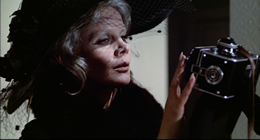 fashion photographer Valentina (de Funès, niece of French comedy film legend Louis de Funès) indulges in a swinging lifestyle of excess and delight with her latest colleague and sex
fashion photographer Valentina (de Funès, niece of French comedy film legend Louis de Funès) indulges in a swinging lifestyle of excess and delight with her latest colleague and sex 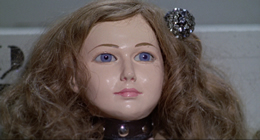 partner, Arno (Eastman, the Anthropophagus monster himself). One night she happens upon a wounded dog in the street and is approached by the chic and mysterious Baba Yaga (Baker), a blonde society woman in a limo. Later Baba shows up at Valentina's apartment during an erotic photo shoot and puts a strange curse on her camera. Faster than you can say Eyes of Laura Mars, Valentina is plagued by strange visions involving a leather-strapped doll that turns into a dominatrix succubus (Five Dolls for an August Moon's Galleani) and finds herself drawn to the house of this bewitching woman, who harbors more than a few kinky supernatural secrets of her own.
partner, Arno (Eastman, the Anthropophagus monster himself). One night she happens upon a wounded dog in the street and is approached by the chic and mysterious Baba Yaga (Baker), a blonde society woman in a limo. Later Baba shows up at Valentina's apartment during an erotic photo shoot and puts a strange curse on her camera. Faster than you can say Eyes of Laura Mars, Valentina is plagued by strange visions involving a leather-strapped doll that turns into a dominatrix succubus (Five Dolls for an August Moon's Galleani) and finds herself drawn to the house of this bewitching woman, who harbors more than a few kinky supernatural secrets of her own.
An especially odd entry in the line of Eurocult comic book adaptations (also including the likes of Danger: Diabolik and Satanik), the sex/horror madness of Baba Yaga (retitled Kiss Me, Kill Me for initial home video releases) must have been a tricky sell in the '70s. Still at the height of her continental exploitation career, actress and Hollywood expatriate Carroll Baker (who was busy in various gialli after Hollywood potboilers like Baby Doll and The Carpetbaggers) serves as the nominal marquee name for what amounts to an extended groovy mood piece, mixing together gothic horror and glossy S&M for an experience unlike any other.
This wild international production doesn't offer its actors much of opportunity to be more than moving mannequins in a string of shots modeled after the original fumetto (Italian comic) by 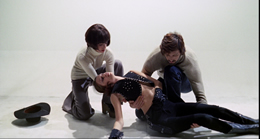 Guido Crepax. That said, Baker - sometimes made up to look older
Guido Crepax. That said, Baker - sometimes made up to look older 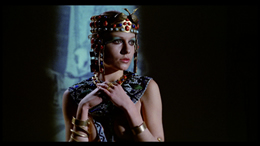 than she really was at the time in a role originally intended for Anne Heywood, who bailed three days before filming - is a compelling presence as always and even dubs in her own voice.
than she really was at the time in a role originally intended for Anne Heywood, who bailed three days before filming - is a compelling presence as always and even dubs in her own voice.
Also effective are the film's pop art editing techniques; the credits themselves are interspersed between jagged shots of a swinging party and comic book frames, while Valentina's visions are related by graphic art interpretations of images from the film. The ultimately loose nature of the storyline is eventually consumed by the film's style, where the visual alignments of the actors' bodies and faces become more important than any kind of rational plotting. Another film based on the same character, the more traditional softcore outing Valentina, was later adapted in 1988 for Italian television and briefly appeared on U.S. home video in a condensed feature as well.
The first DVD on the market back in the late '90s was a bootleg from defunct outfit Diamond which oddly promoted this as an Umberto Lenzi production, perhaps confusing this with Paranoia or A Quiet Place to Kill (which teamed him up with Baker). For some reason Jean-Louis Trintignant's name also appears on the box. In any case, the disc is a wholesale rip of the long discontinued American VHS release from Paragon, right down to the tape dropouts and the sloppy computer generated title card.
A far superior official version came in 2003 with Blue Underground's widescreen presentation, which finally made sense of those frenetic compositions and dark night scenes. That DVD also contains an excellent 21m42s video interview with the film's director, Corrado Farina, whose only other feature remains the astonishing vampire social satire, They Have Changed Their Face. He discusses his disappointment with previous comic adaptations (especially Barbarella), his original casting choices for the film including Elsa Martinelli and Stefania Casini, and his frustration when his approved final cut was chopped up behind his back, a situation which sent him protesting to the newspapers. Eventually the film was handed back to him but with a cut negative, so he had to assemble the third, final release cut in the form we now know it as today. Those unused scraps are presented in drastically inferior quality, in Italian with optional English subtitles. Some of the highlights include a truly mad opening sequence in a graveyard with a guy in a General Custer getup confronting a bare-breasted Indian woman (Marco 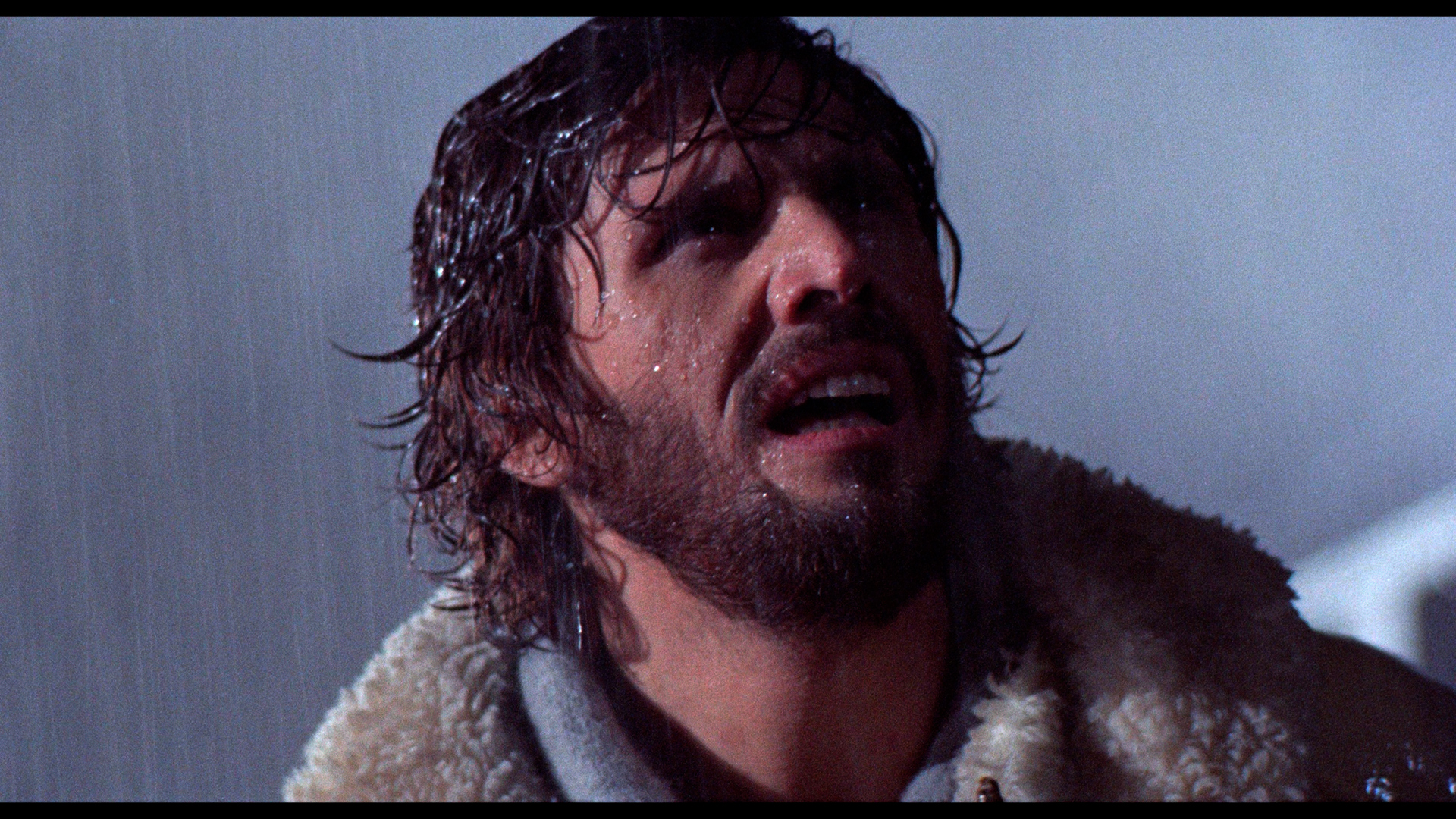 Ferreri would've been proud) and some surprising deleted frontal nudity from both of the leading ladies. You also get a
Ferreri would've been proud) and some surprising deleted frontal nudity from both of the leading ladies. You also get a 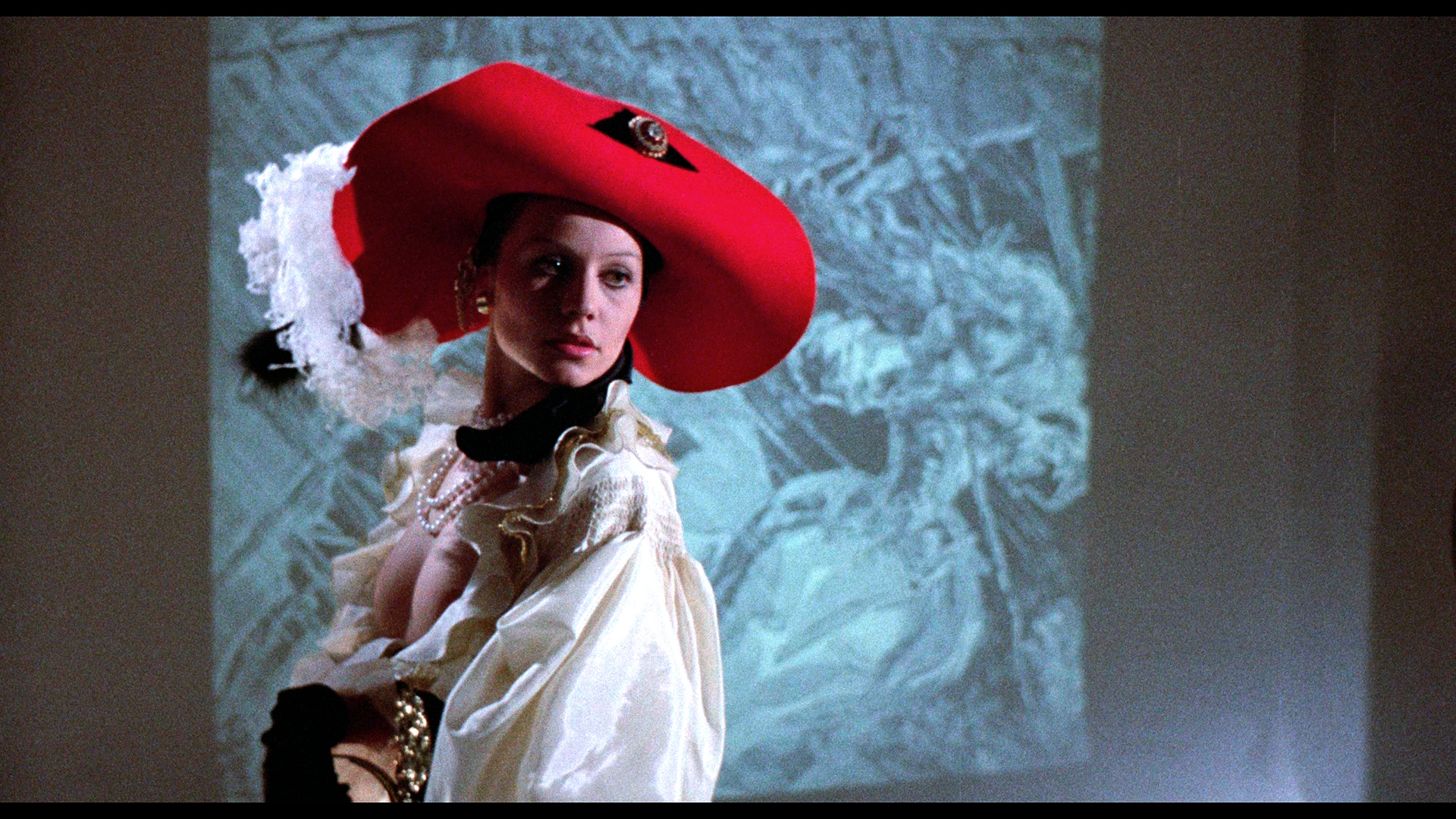 12-minute short film about Crepax called "Freud in Color," the European trailer, a poster and still gallery, and a DVD-Rom comic-to-film comparison.
12-minute short film about Crepax called "Freud in Color," the European trailer, a poster and still gallery, and a DVD-Rom comic-to-film comparison.
Interestingly, that wasn't even close to the end of the road for this weird little puppy. In 2009, the UK label Shameless unleashed Baba Yaga: The Final Cut, with Farina participating in new extras and integrating the cut footage back into the main feature. It's a pretty jagged experience as the picture quality shifts back and forth between the BU transfer and what essentially looks like a VHS workprint, but it's fascinating to see how it all might have played in its original form. This version runs 85 minutes in PAL, which would put it substantially longer if converted for NTSC. More significantly, the disc also offered the first chance to watch the film in either English or Italian with optional English subtitles; it's a toss up which is preferable, as you get Baker's actual voice in the former but far better vocal performances for everyone else in the latter. Either way, Piero Umiliani's Hammond Organ-laced score (pulled from his library album work including the catchy "Open Space" from To-day's Sound as its main theme) sounds great and really, really needs a full soundtrack release someday. Farina pops up for a completely different interview here (and a quick video intro), covering some of the same ground but talking in more detail about the film's distribution history and censorship problems. Also included are a pair of brief Farina-helmed video histories of fumetti, the trailer, a different gallery, and a text commentary track in subtitle form that starts off with very little actual information (mainly commenting on the action and comparing camera angles to TV's Batman), but it improves as it goes along and gets into a nice groove.
In 2012 we reached the Blu-ray era with Blue Underground picking this one for the hi-def treatment way before finishing the Argento or Fulci catalogs. It was a welcome surprise at the time to be sure, and the transfer is a striking example of how much better the same negative can look when transferred twice at opposite ends of a nearly decade-long period. Colors are far more intense, flesh tones look healthier, and black levels are deeper. It's never been the sharpest-looking film in the Italian cult drawer (and 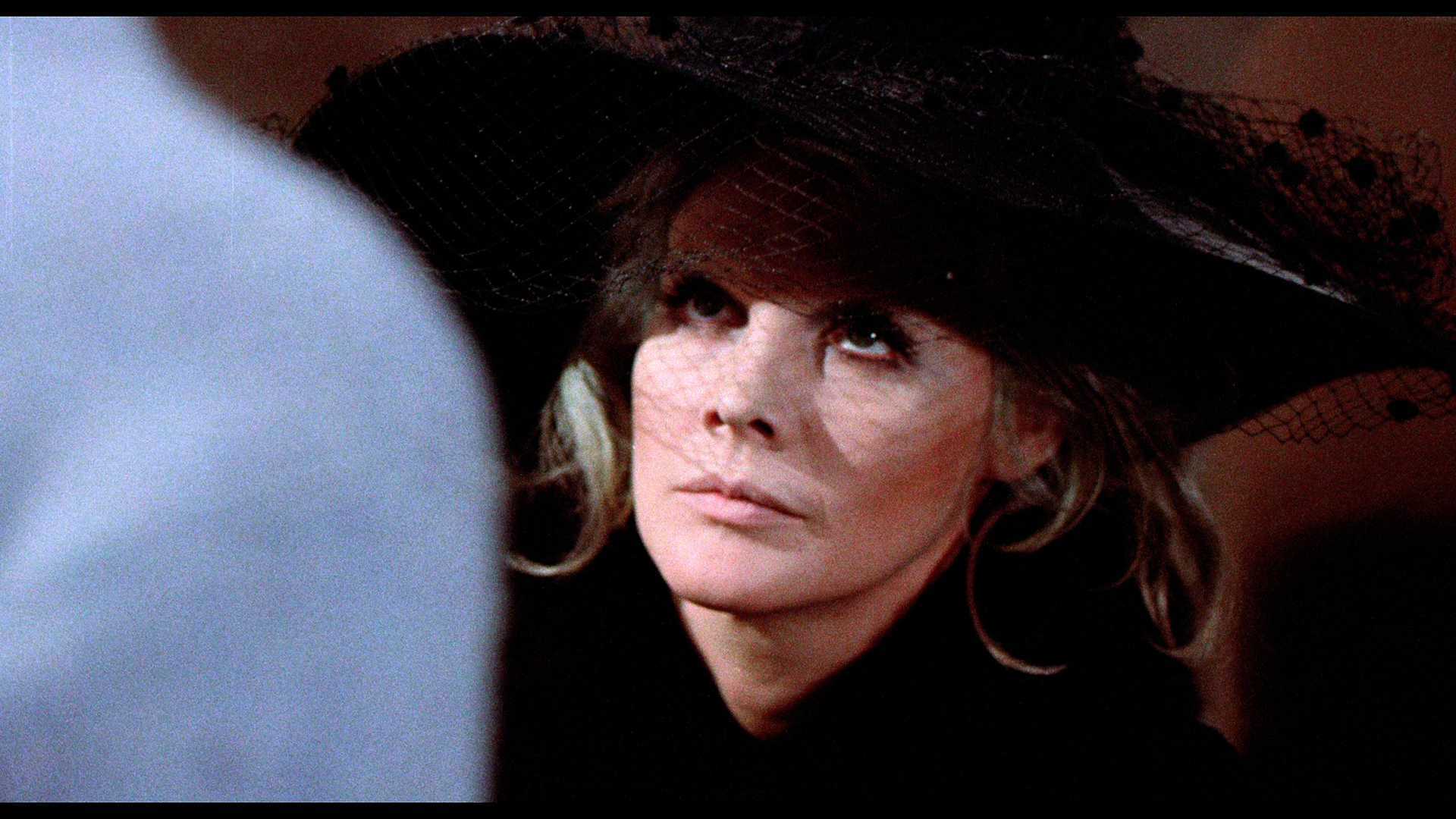 some of those scenes in Baba Yaga's lair have always been on the murky side), but it's nice to see it bumped up a few notches in quality. For the most part film grain looks fine throughout (and way more natural than the DVD), though a handful of shots look a little slicked down, like when Valentina first crouches down over the dog in the road. It's definitely on the better side of Italian-sourced HD transfers of late though and marks a substantial upgrade across the board. Interestingly, there's also a sliver more information on the left side of the frame and an equally minuscule amount missing on the right, for whatever reason. The audio options are also substantially beefed up here, with both the English and (for the first time in America) the Italian track provided in DTS-HD mono. Two optional English subtitles are provided, one for the English track and another, very different one translating the Italian dialogue; try
some of those scenes in Baba Yaga's lair have always been on the murky side), but it's nice to see it bumped up a few notches in quality. For the most part film grain looks fine throughout (and way more natural than the DVD), though a handful of shots look a little slicked down, like when Valentina first crouches down over the dog in the road. It's definitely on the better side of Italian-sourced HD transfers of late though and marks a substantial upgrade across the board. Interestingly, there's also a sliver more information on the left side of the frame and an equally minuscule amount missing on the right, for whatever reason. The audio options are also substantially beefed up here, with both the English and (for the first time in America) the Italian track provided in DTS-HD mono. Two optional English subtitles are provided, one for the English track and another, very different one translating the Italian dialogue; try 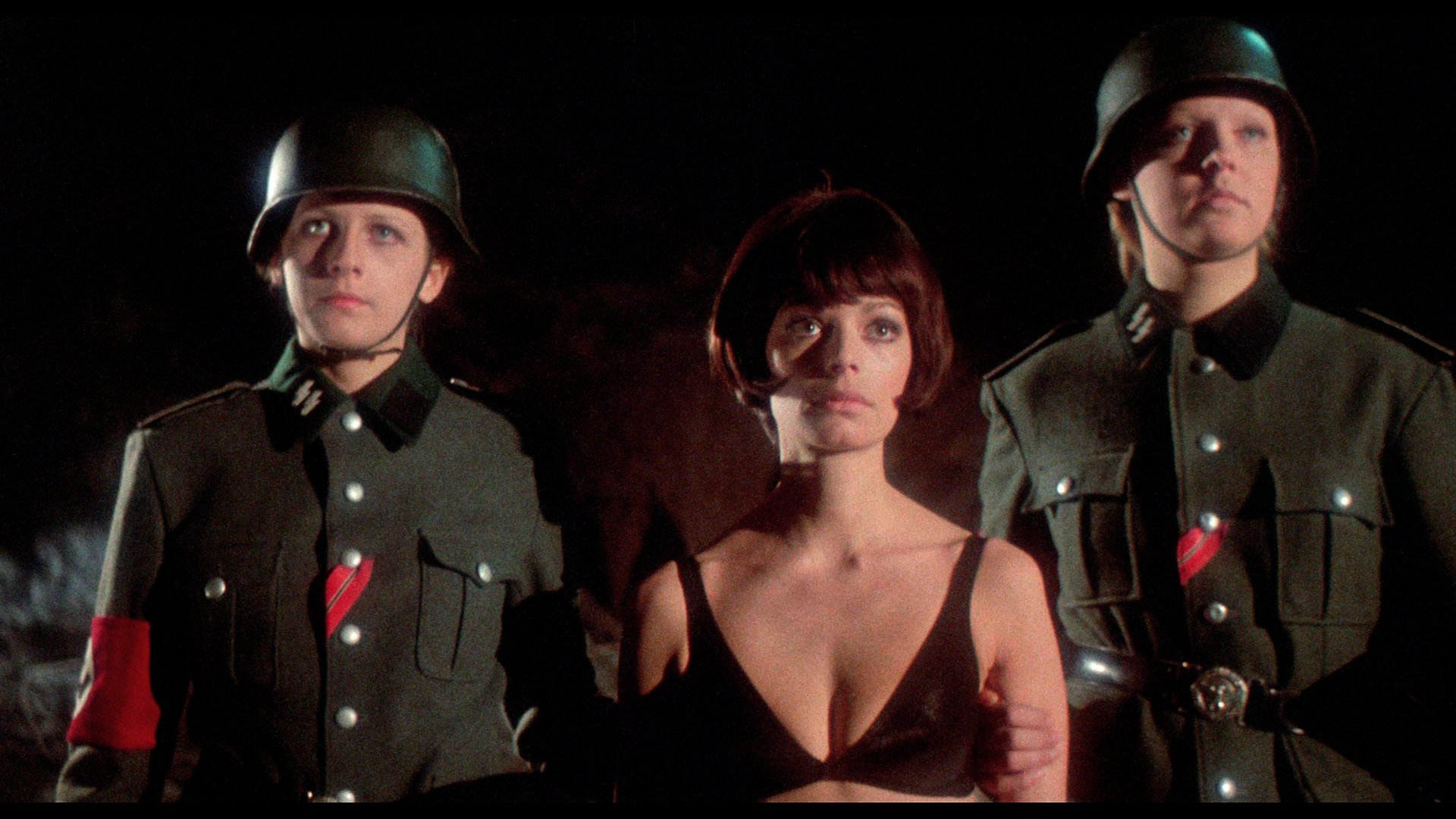 flipping back and forth between the two for some interesting comparisons. Again, it's really a draw which one you listen to first, as they both have their merits. Additional subtitles are also provided in French and Spanish. Extras are identical to the prior DVD (and standard def), except the comic-to-film comparison is now its own step-through feature instead of a DVD-Rom bonus.
flipping back and forth between the two for some interesting comparisons. Again, it's really a draw which one you listen to first, as they both have their merits. Additional subtitles are also provided in French and Spanish. Extras are identical to the prior DVD (and standard def), except the comic-to-film comparison is now its own step-through feature instead of a DVD-Rom bonus.
The Severin release in this set is dedicated to a whopping four(!) discs, with the UHD and first Blu-ray containing the film in its usual theatrical cut here scanned from the negative with a punchy, very healthy presentation from the original negative with significant extra image info. The color grading here looks gorgeous and really brings out the comic-style aesthetic even more, and the English and Italian DTS-HD MA 2.0 mono tracks sound solid with optional English SDH or translated subtitles. A new commentary by Emma Westwood and Sally Christie is an entertaining kick as they cover Crepax, Nazisploitation (see the film to see why), fashion, fetishism, and plenty more. "Farina and Valentina" is the director interview ported over from the earlier Blue Underground edition, while "Valentina, Baba Yaga, and Dad" (44m54s) is an in-depth and affectionate look at the late filmmaker courtesy of his son, film critic Alberto Farina, who delivers a wealth of personal and professional details about his dad's love of comics, his discovery of Crepax, and his love of genre cinema that spilled over into his short and feature-length work. In "The Milan Witch Project" (10m43s), Eastman (a.k.a. Luigi Montefiori) talks about his immediate positive reaction to the project, his love of Crepax, the shooting in Milan (where he'd never been before), the Veneto accent he couldn't quite pull off, and the magical nature of the project even if he couldn't tell what it was about. In "A Filmmaking Friendship" (23m47s), editor and co-screenwriter Giulio Berruti chats about his memories of the director, his work on this versus Corrado's previous film, his work on the script with editing in mind, the casting process, and his thoughts on the roles of different kinds of filmmakers. The usual trailer is included here in a new scan.
The second Blu-ray features the remaining video extras starting with "The Gaze Bewitched" (13m50s) with Heller-Nicholas talks about The Golem, the Nazi imagery, student activism, and the role of the gaze in witchcraft. A Short Village Magazine interview with Corrado and Alberto Farina (31m26s) features the duo chatting about a wide range of film-related topics including getting a short film prize at Cannes, his move to making features, and numerous other artistic pursuits. Up next are the usual reel of deleted footage (9m50s), a 4m17s gallery, a comic-to-film comparison gallery, and a trio of Corrado short films: the previously released "Freud in Color" (12m12s) from 1970, the same year's "Science Fiction Is Us" (13m28s) paying tribute to notable sci-fi writers, comics, and films, and 1963's "It Was Called Earth" (17m18s). The fourth disc is a 20-track soundtrack CD featuring the two key library tracks from this film and highlights from Umiliani's work for Jerry Land Cacciatore di Spie, Operazione Poker, and Marchio del Kriminal.
TERROR-CREATURES FROM THE GRAVE: Severin (UHD)
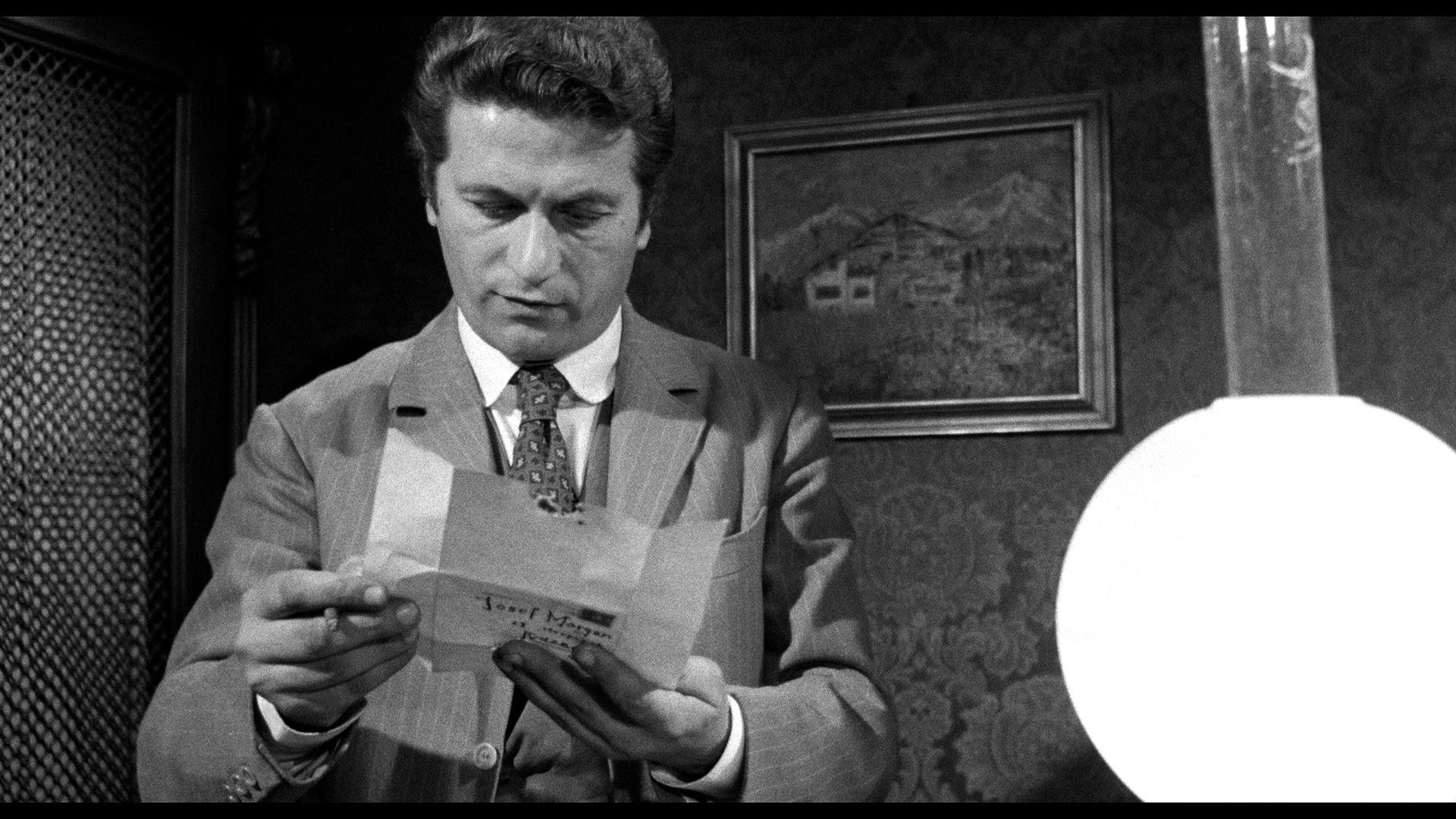
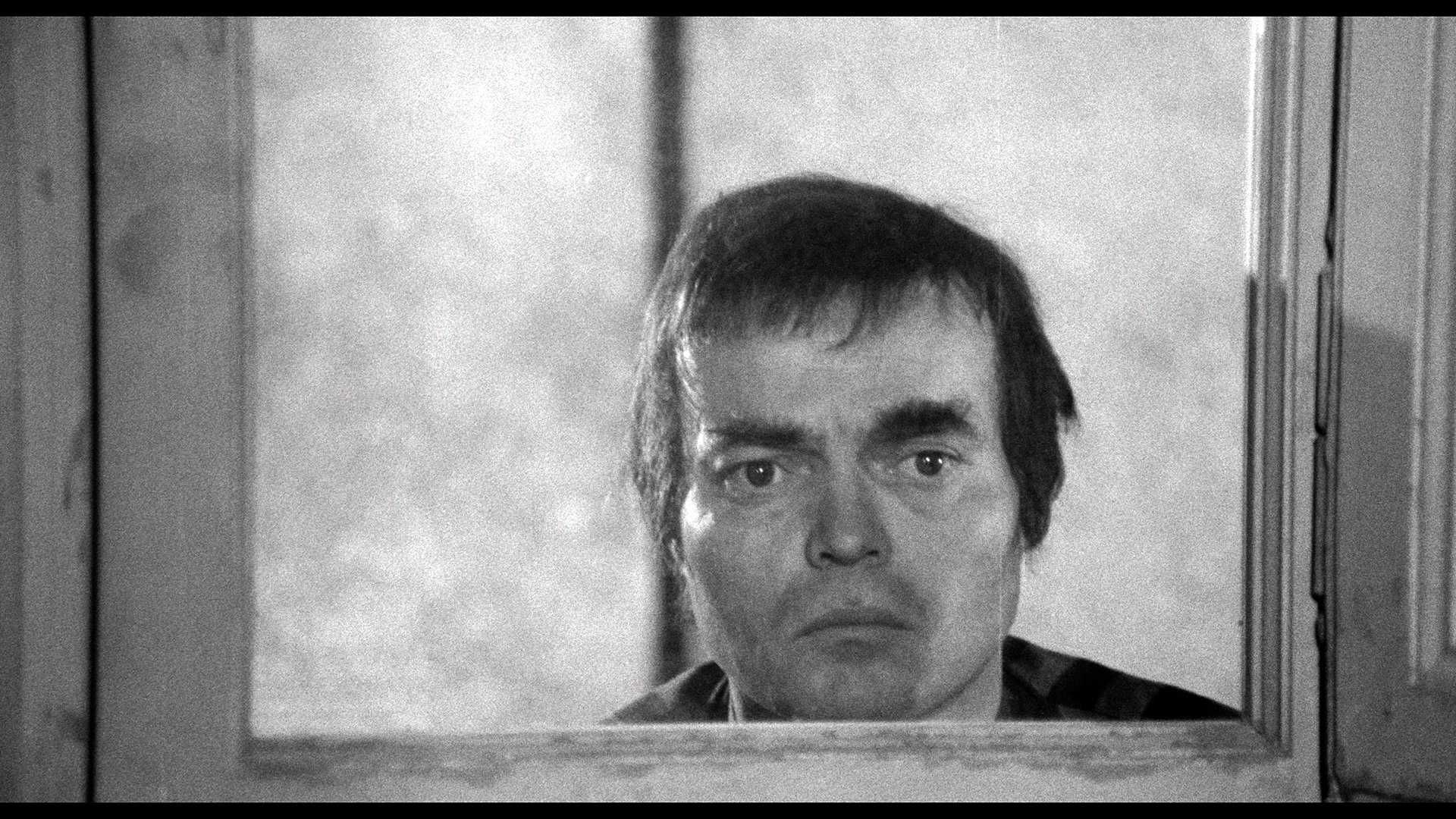
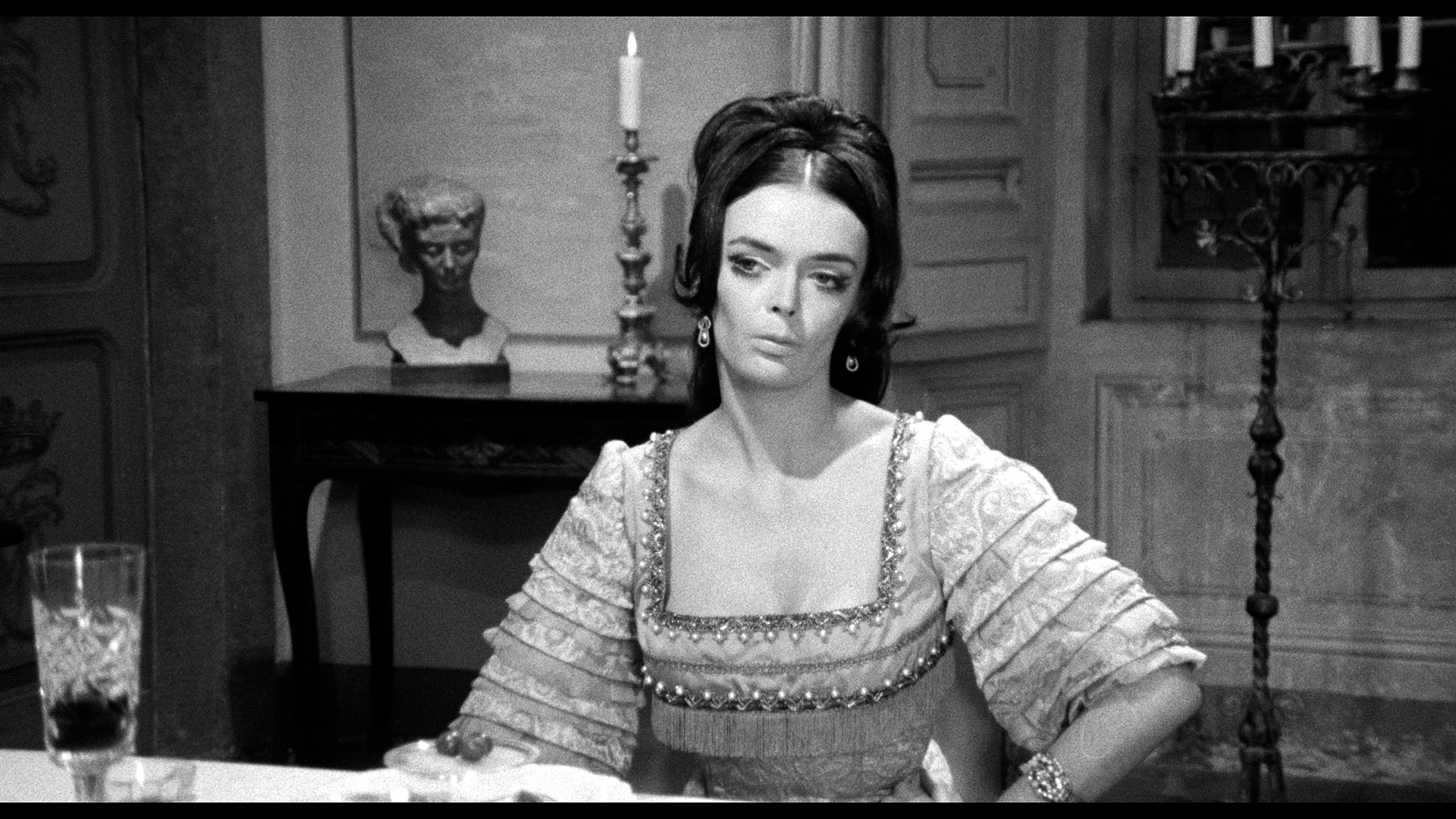
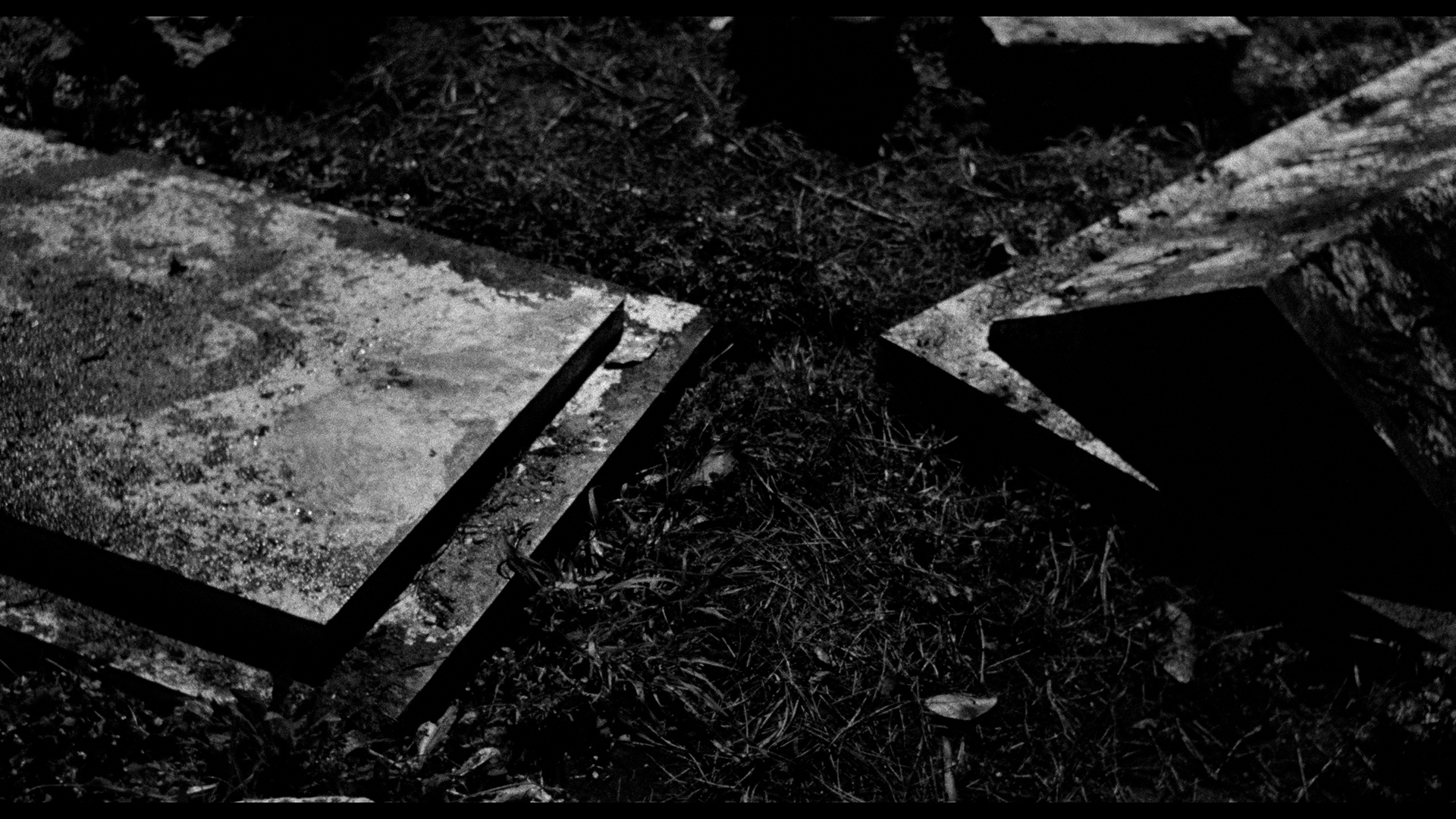
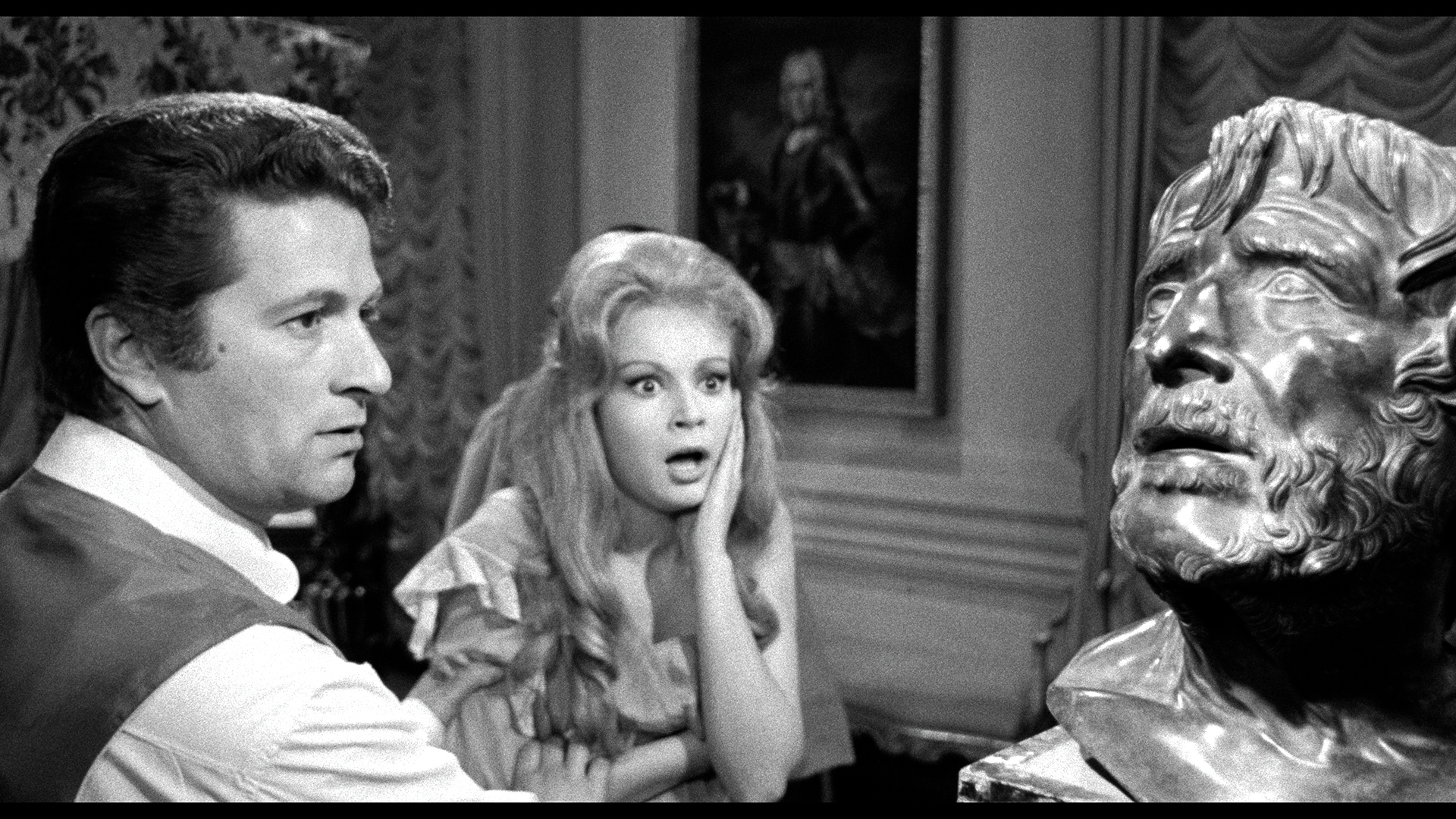
TERROR-CREATURES FROM THE GRAVE: Artus (DVD)
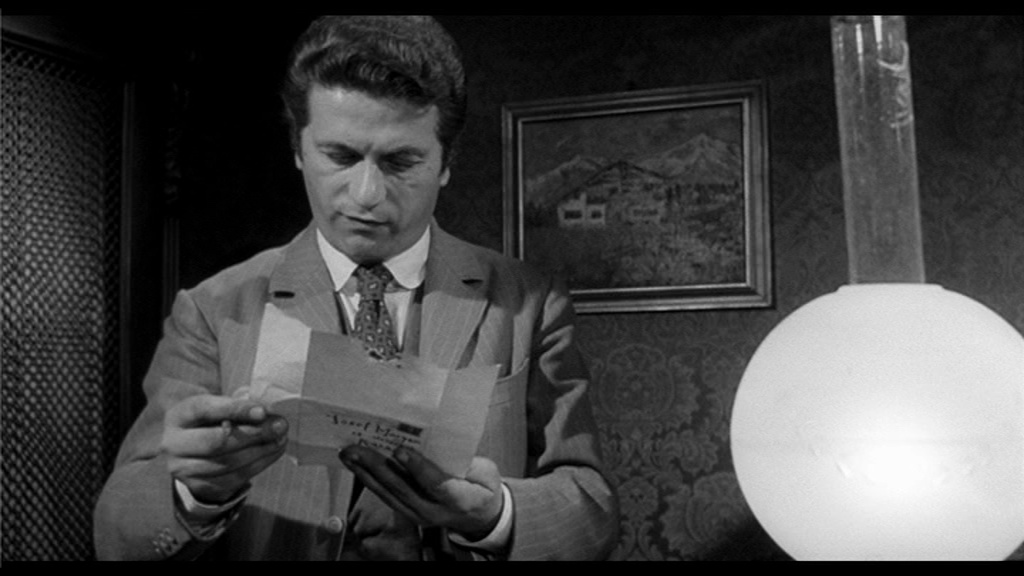
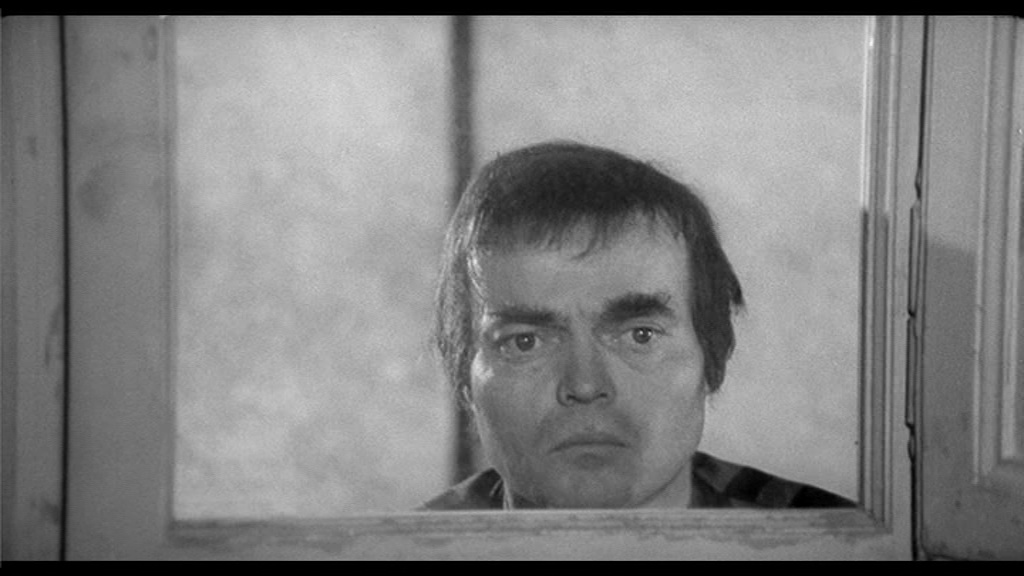
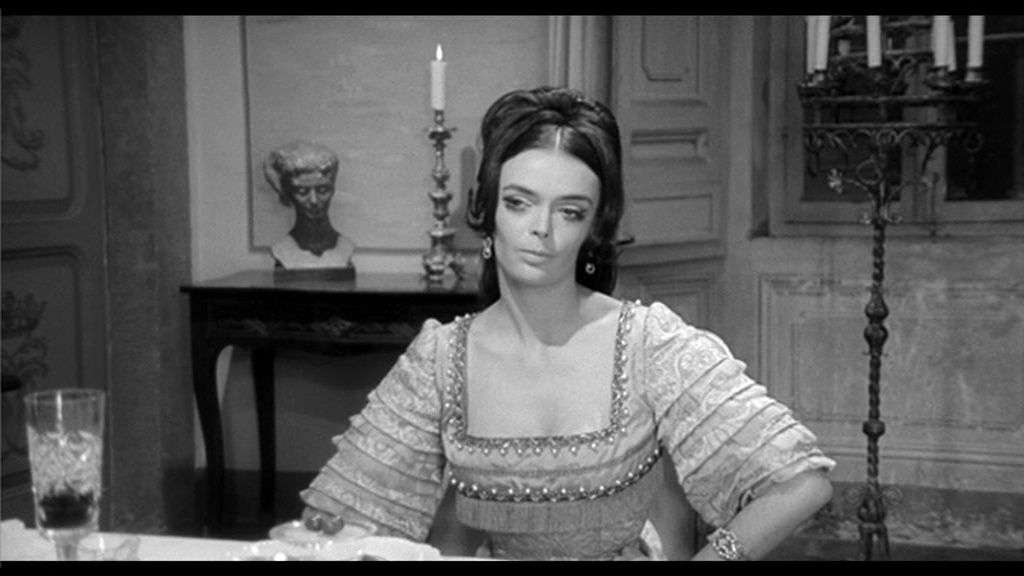
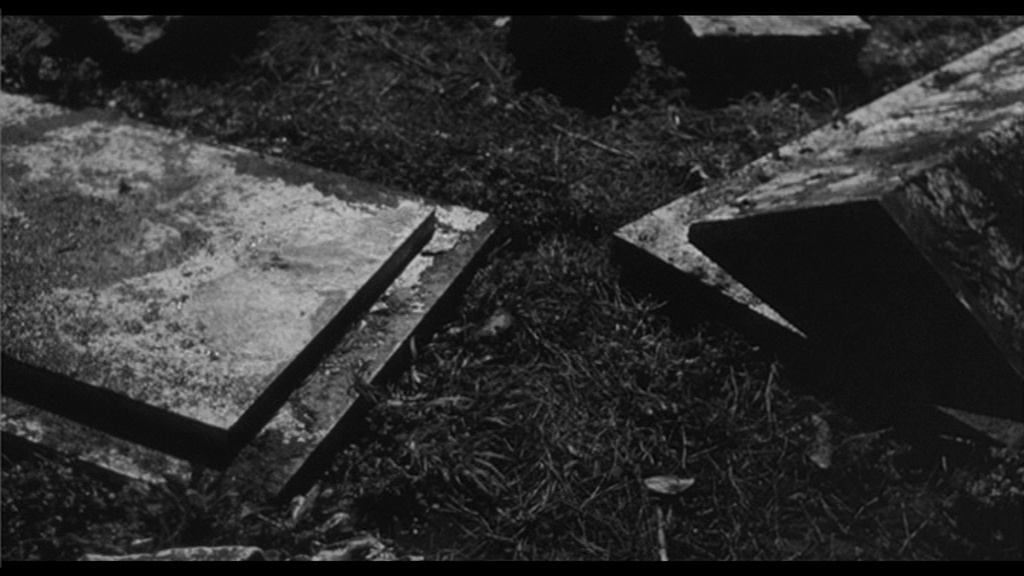
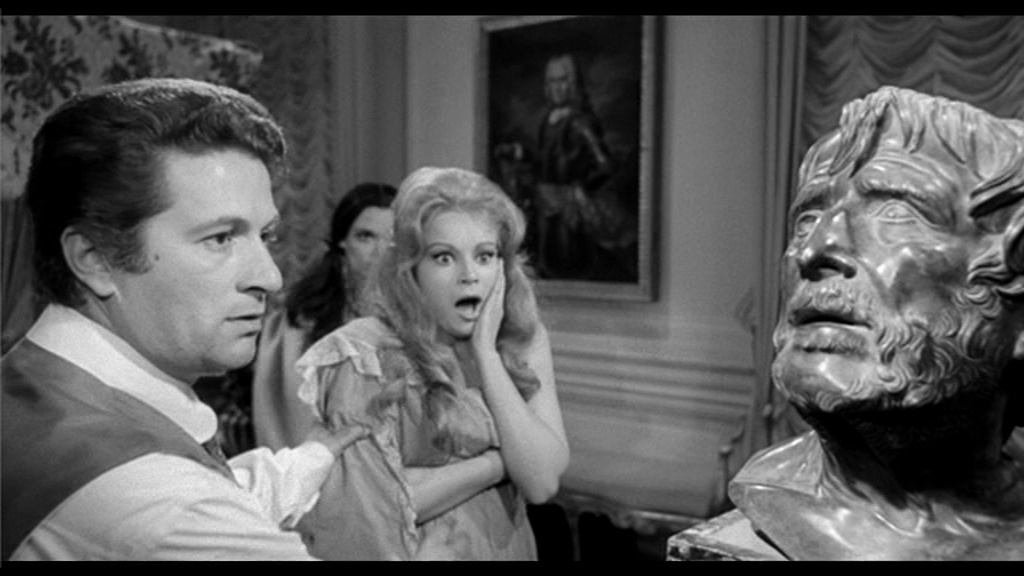
THE DEVIL'S WEDDING NIGHT: Severin (UHD)
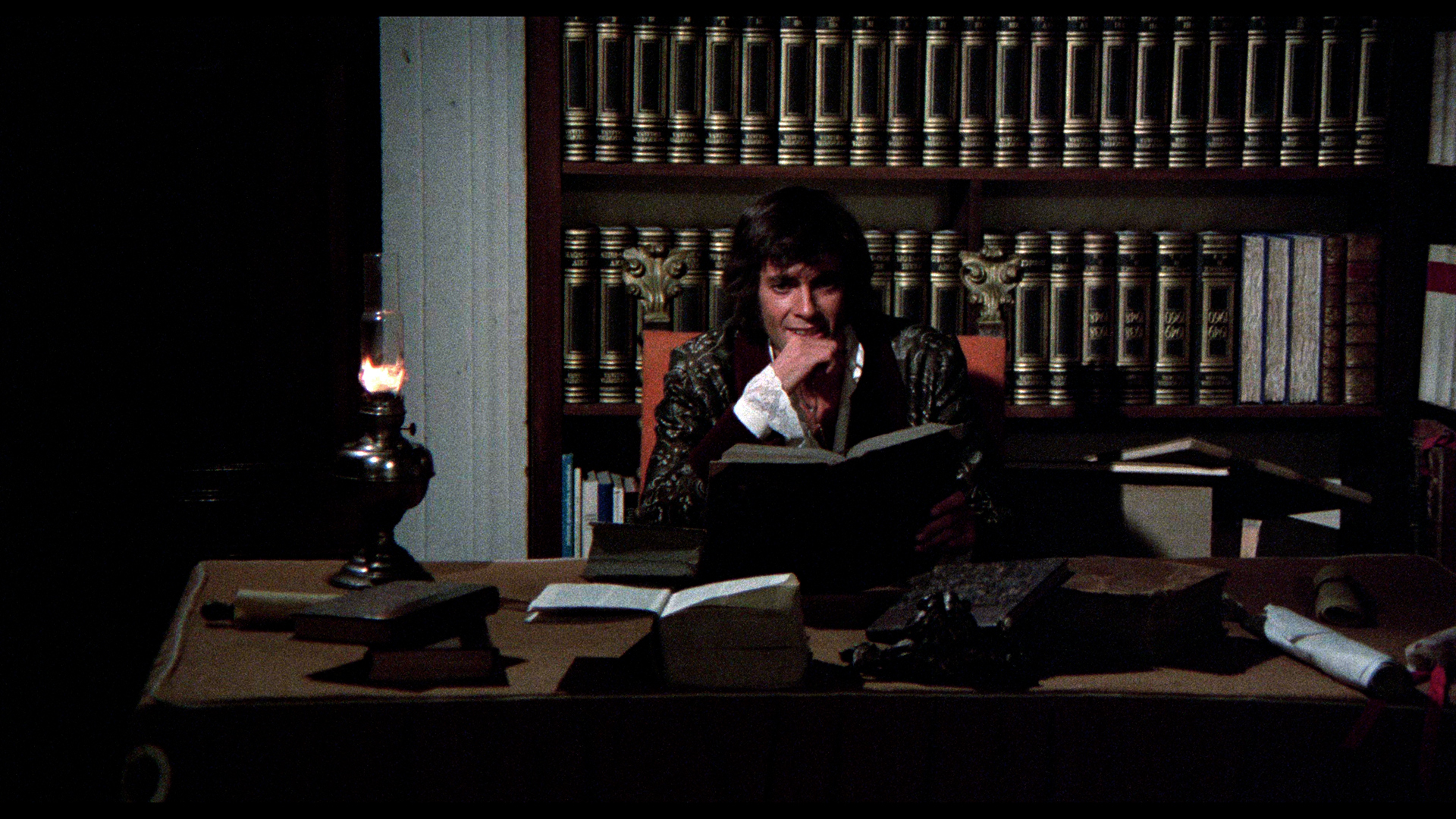
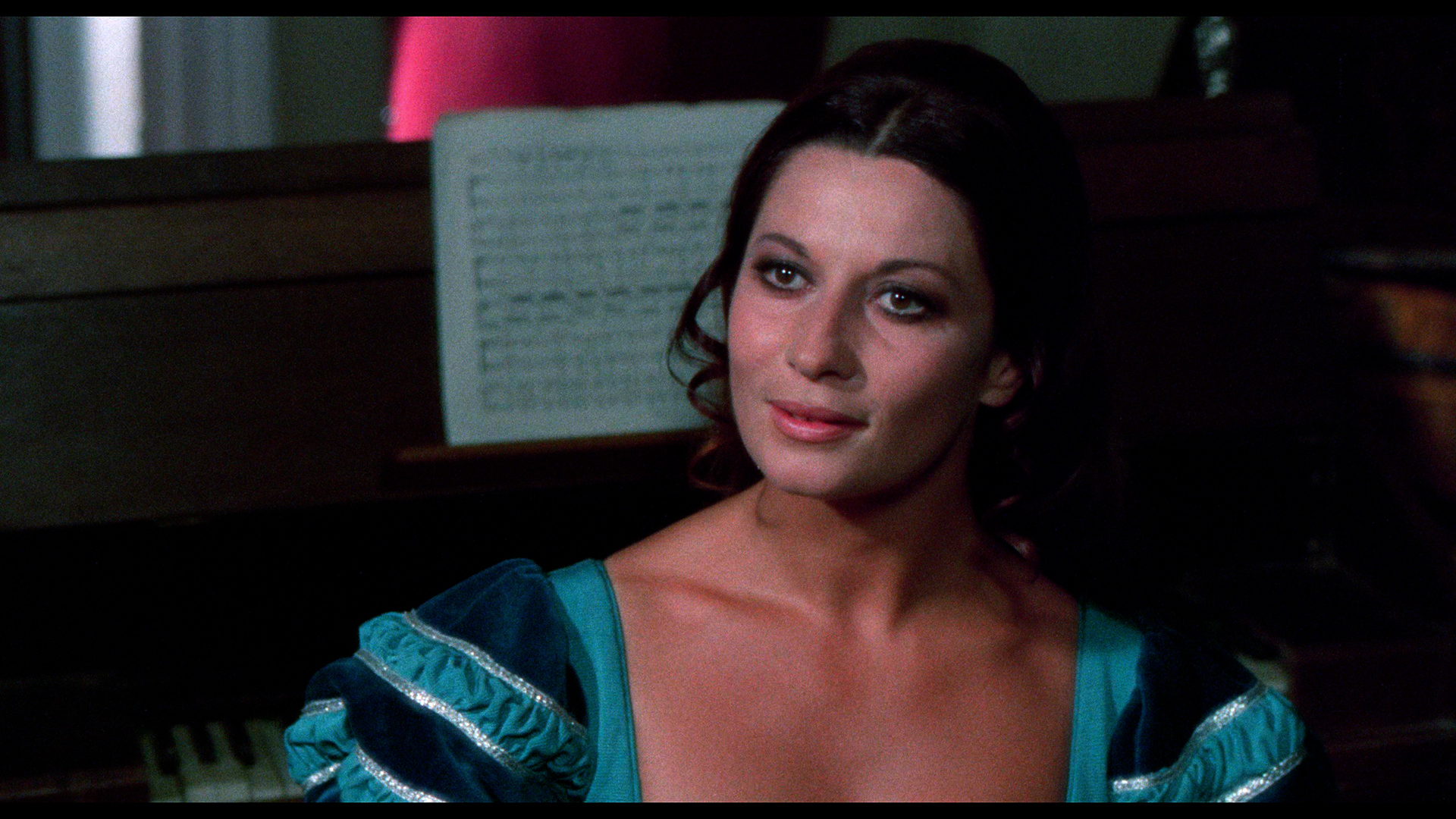
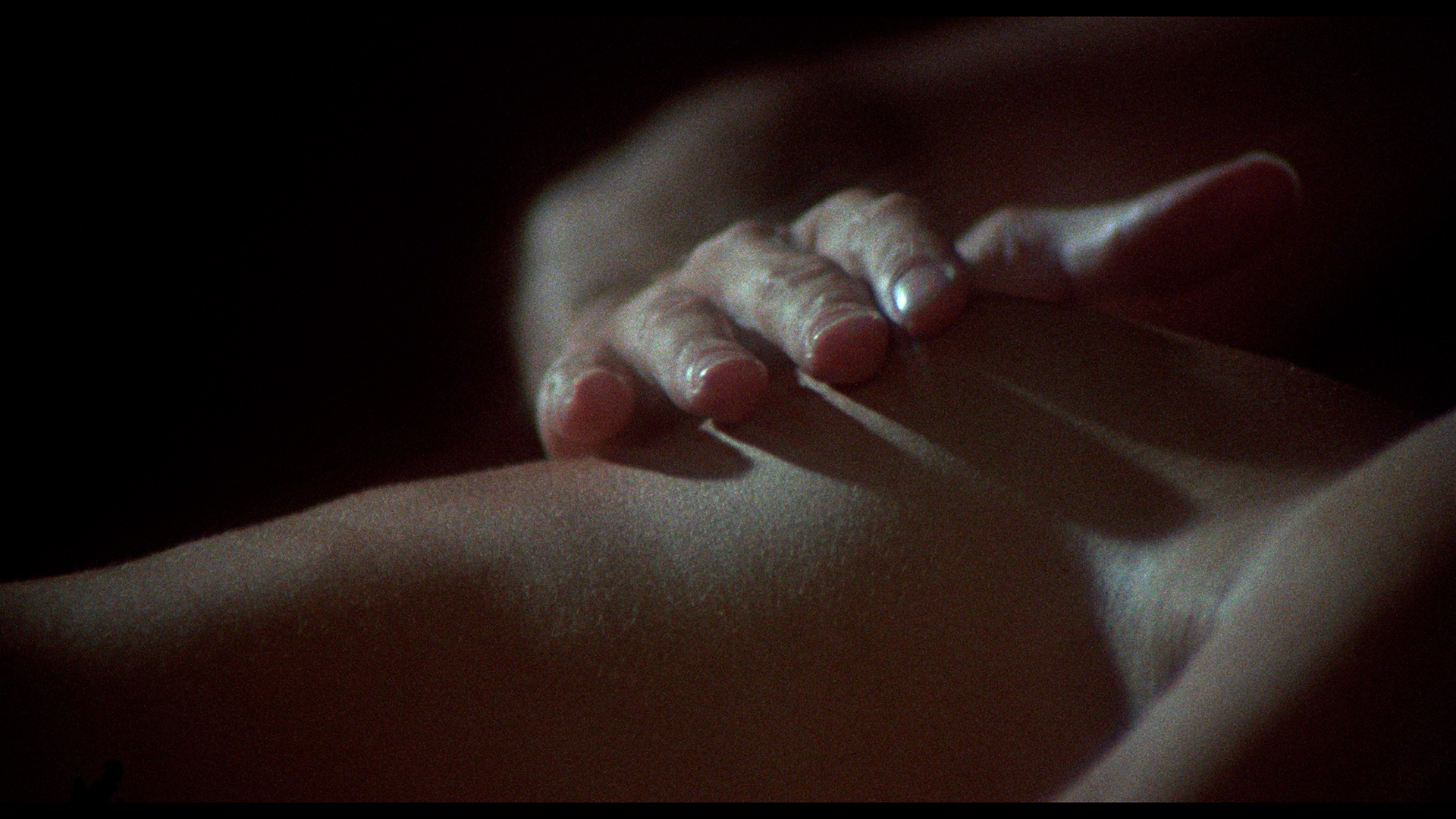
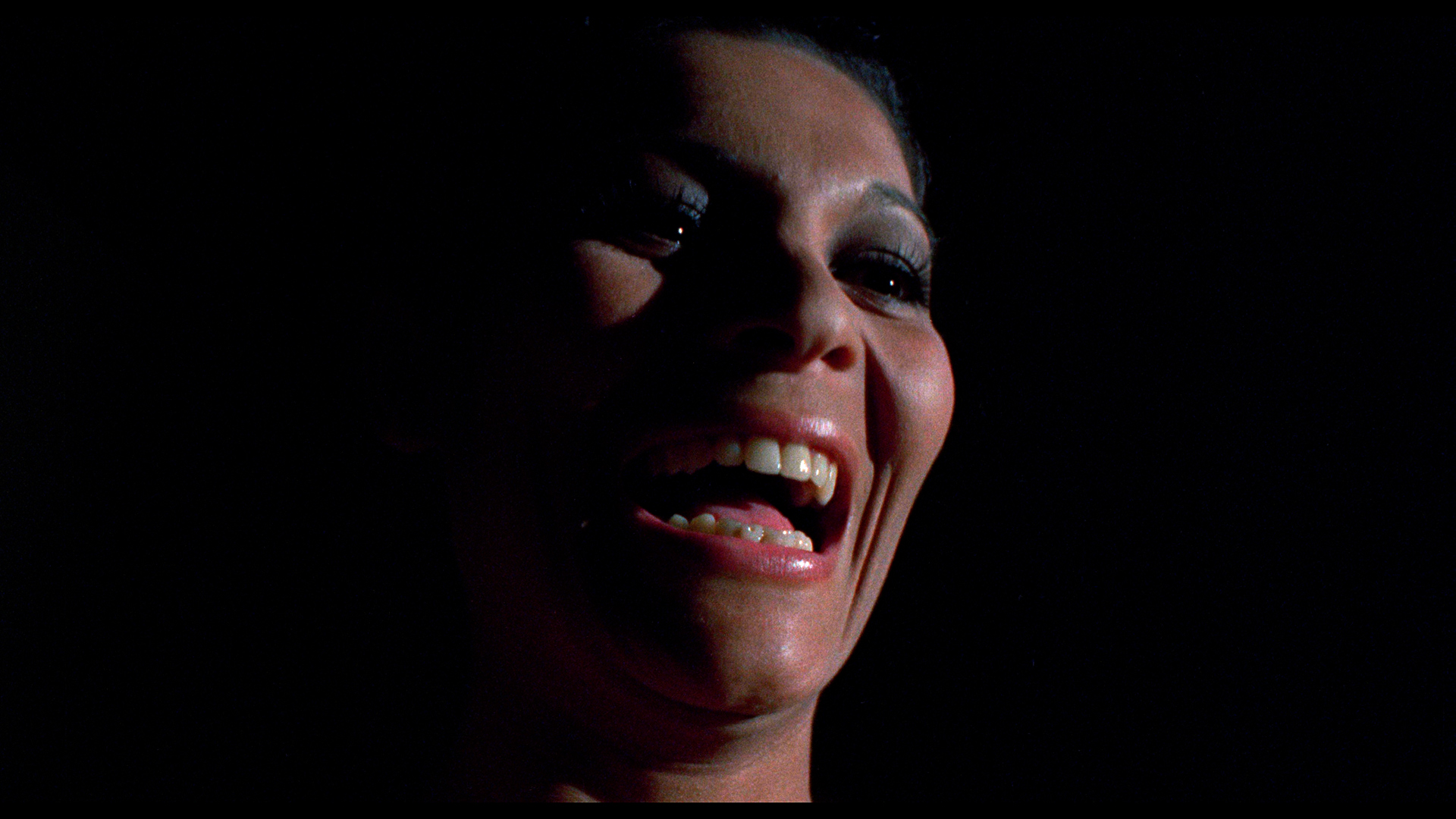
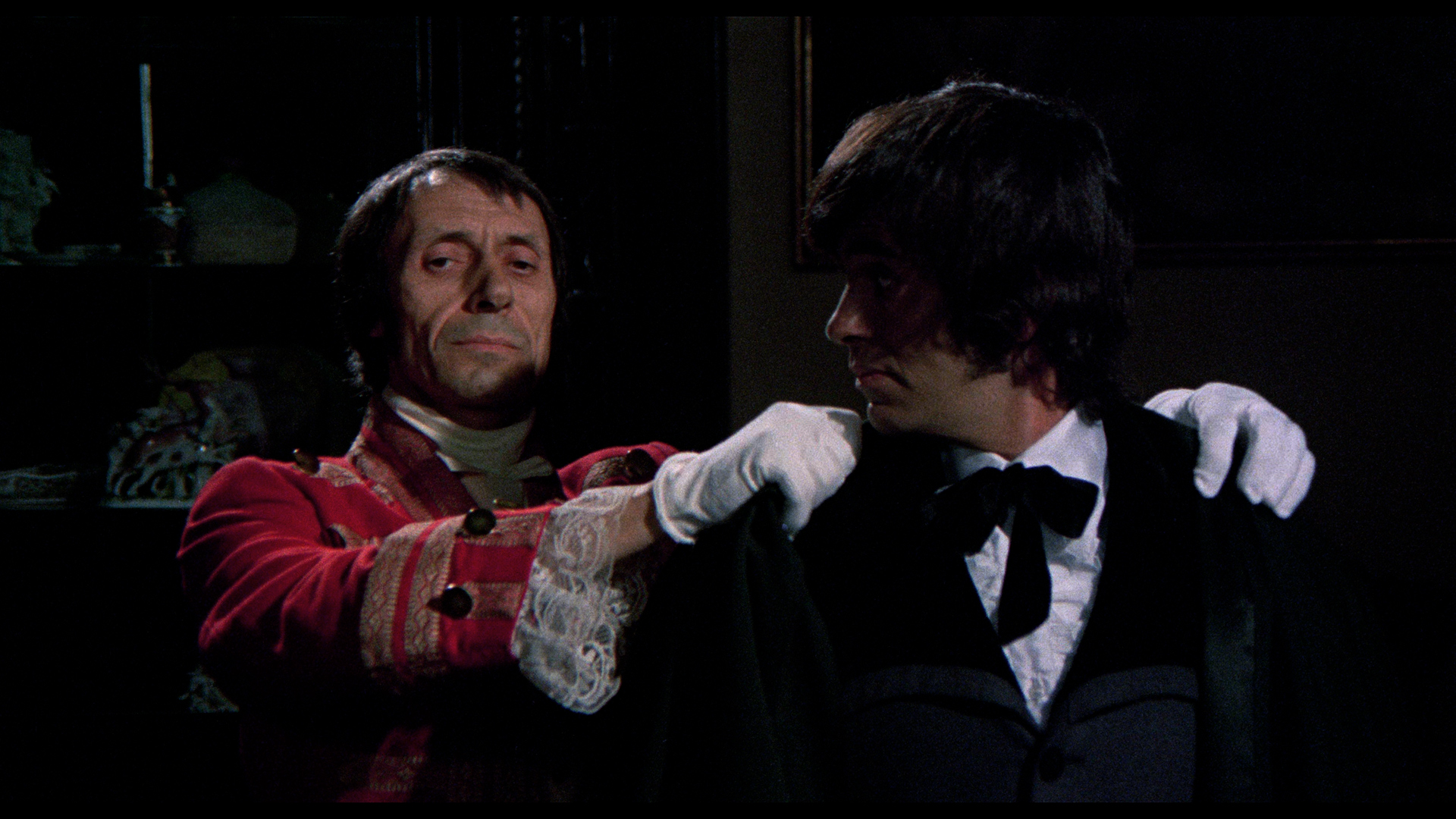
THE DEVIL'S WEDDING NIGHT: Code Red (Blu-ray)
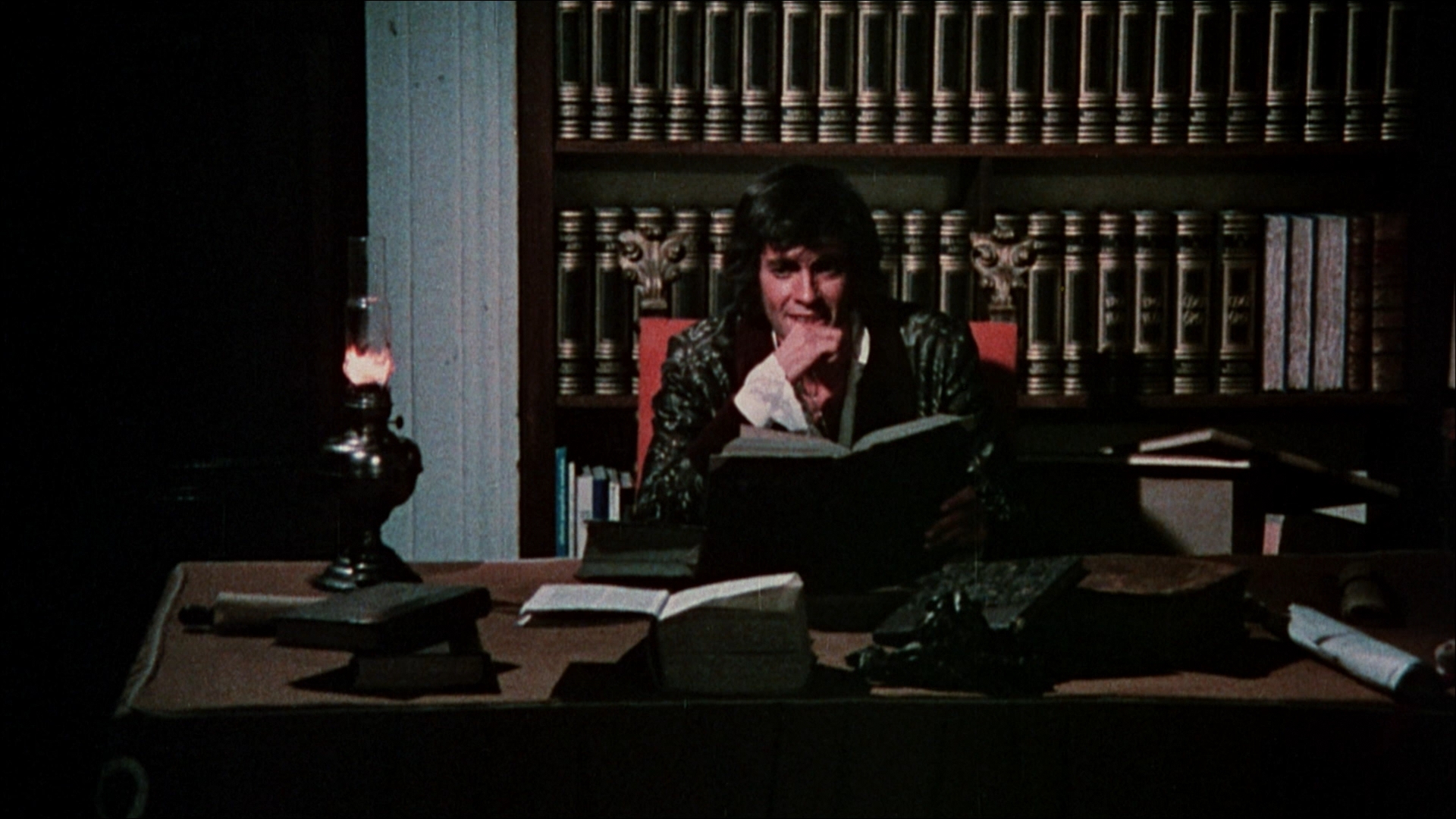
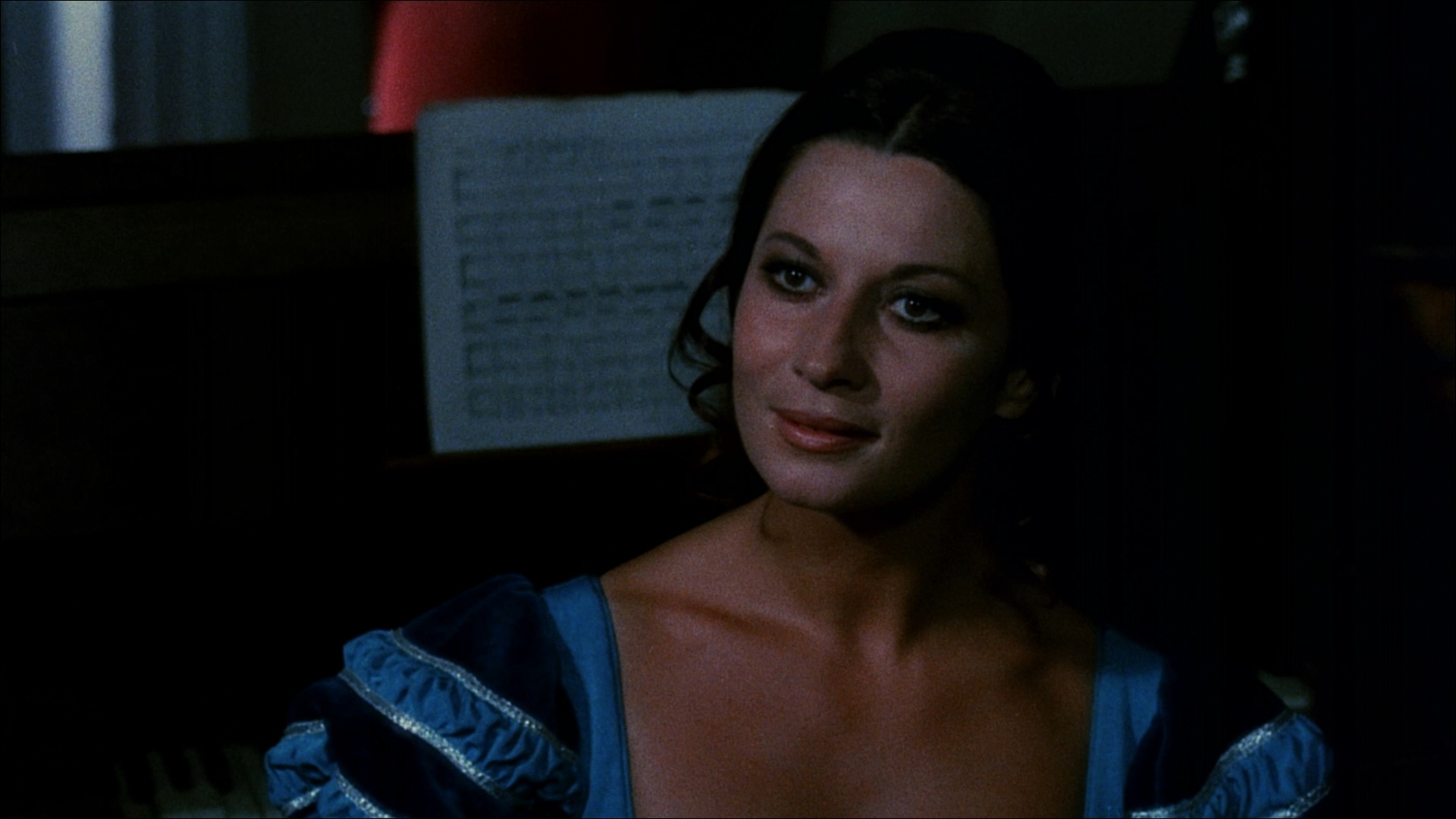
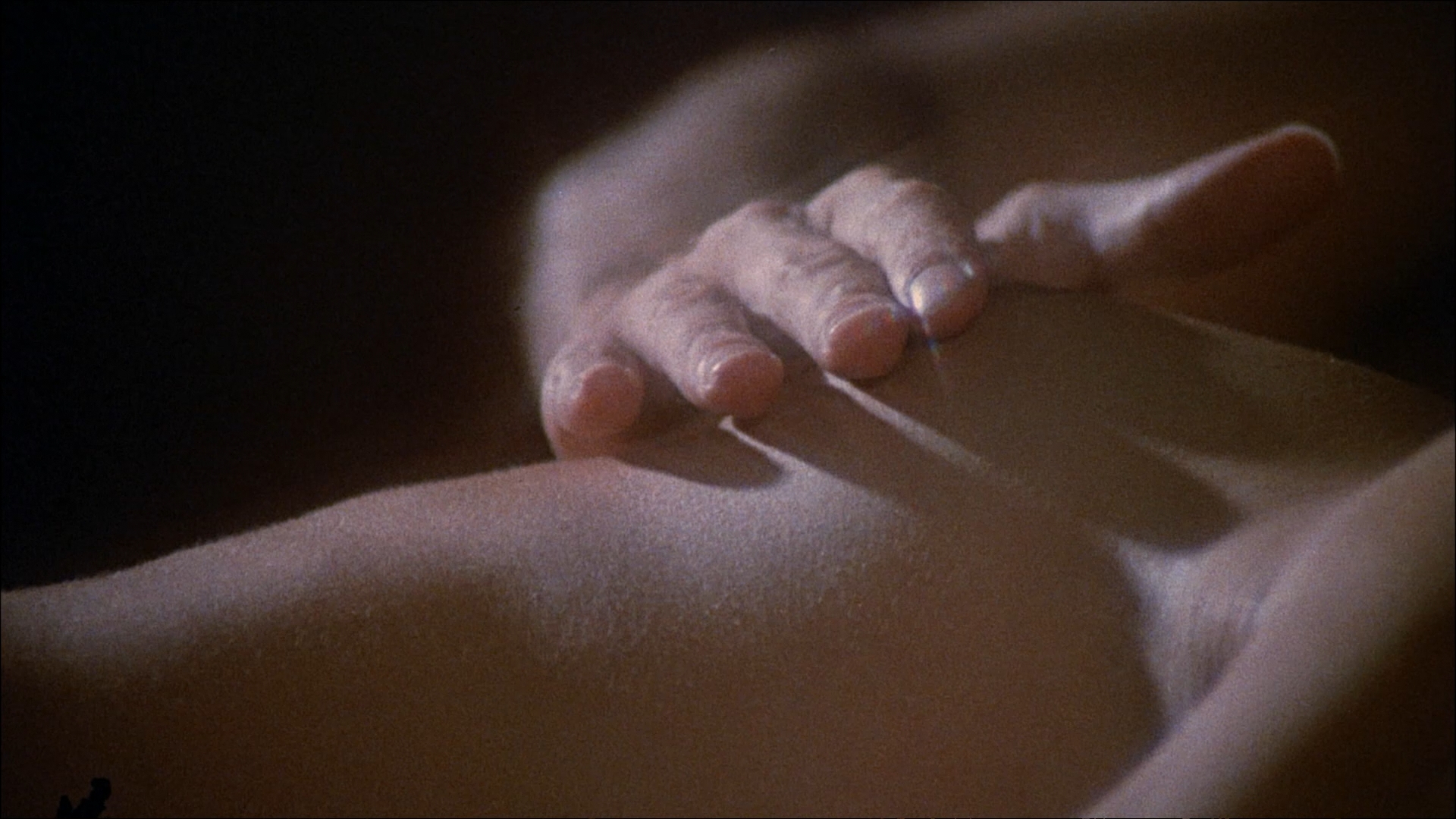
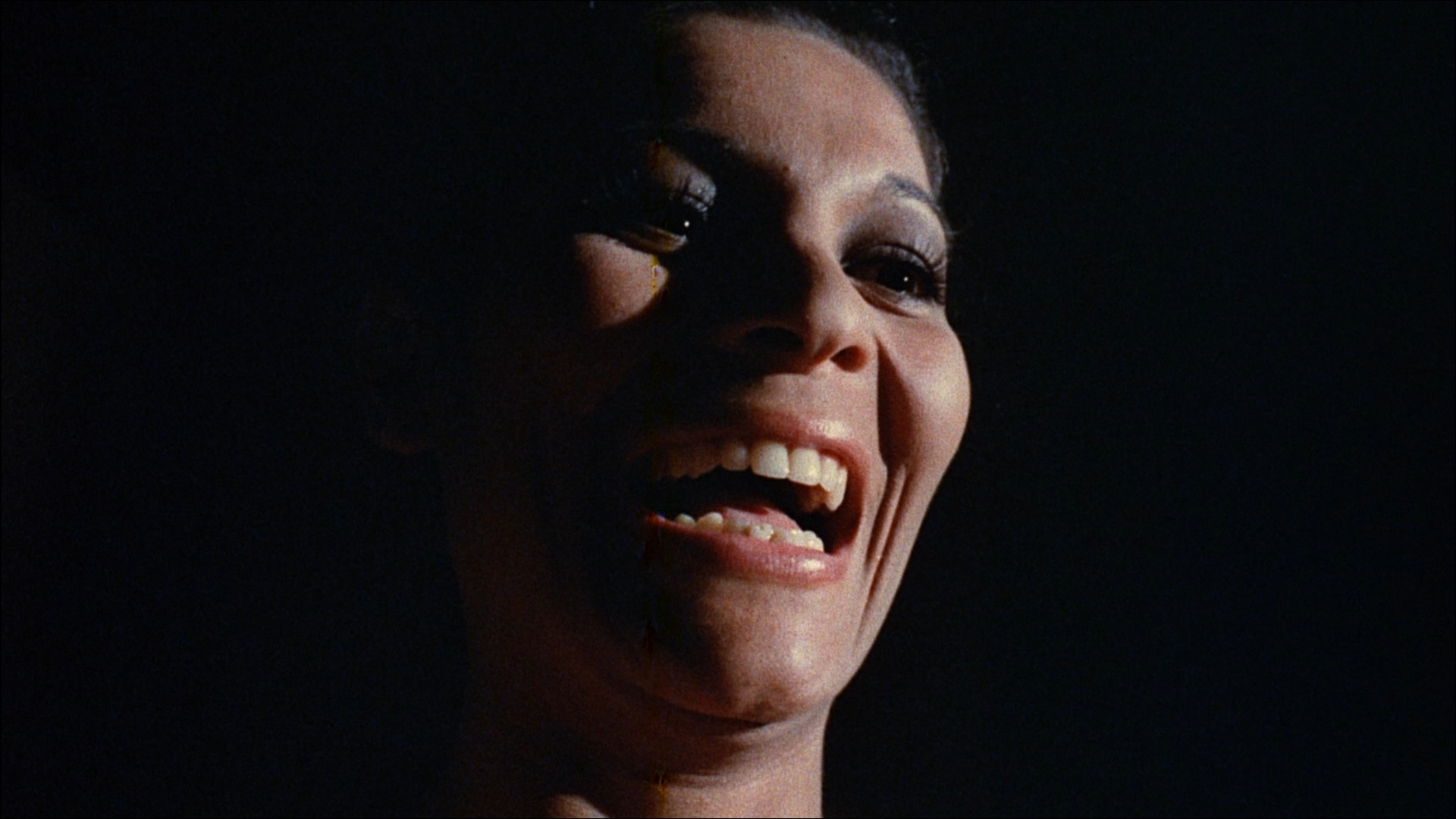
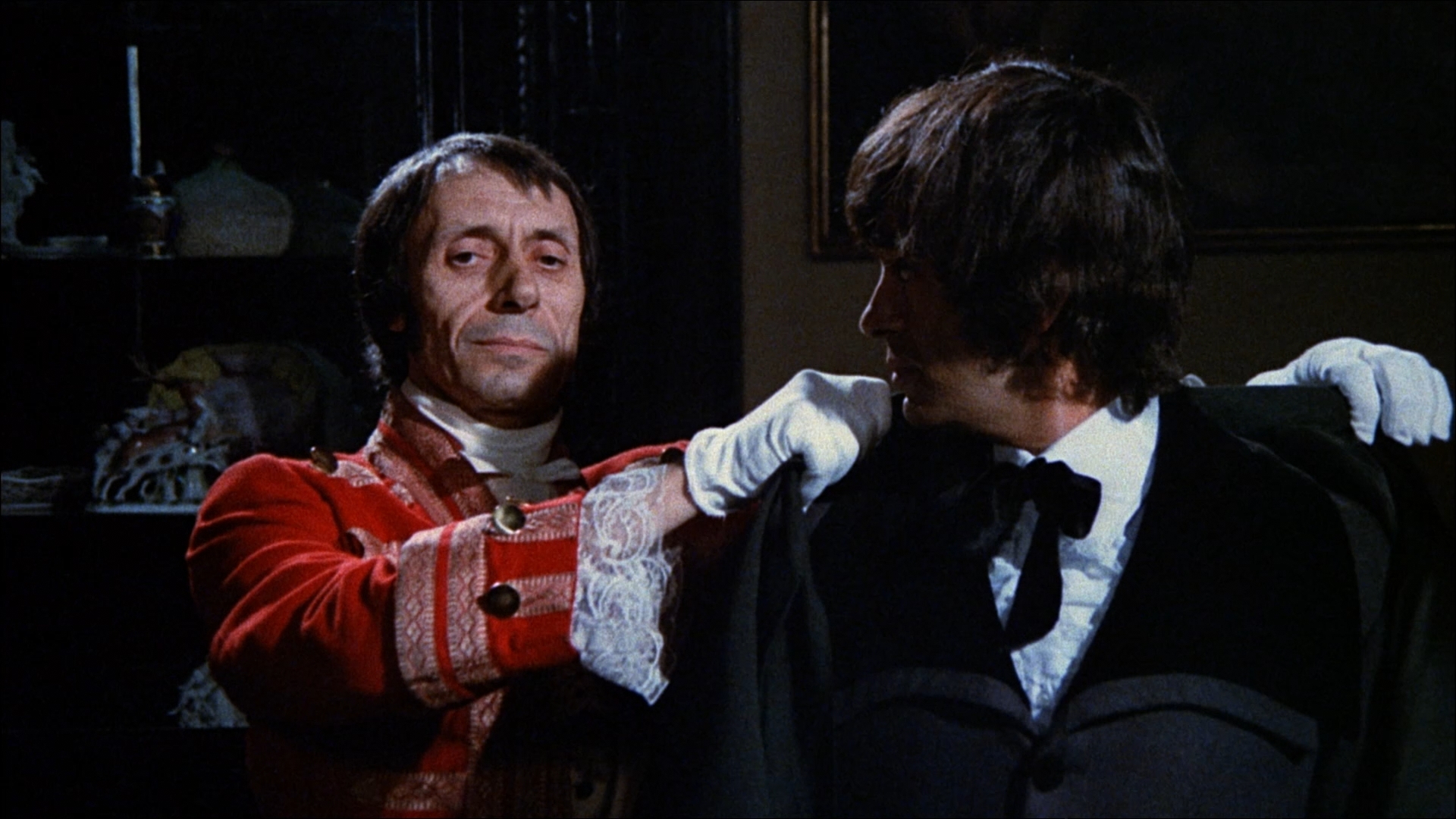
THE DEVIL'S WEDDING NIGHT: Artus (DVD)
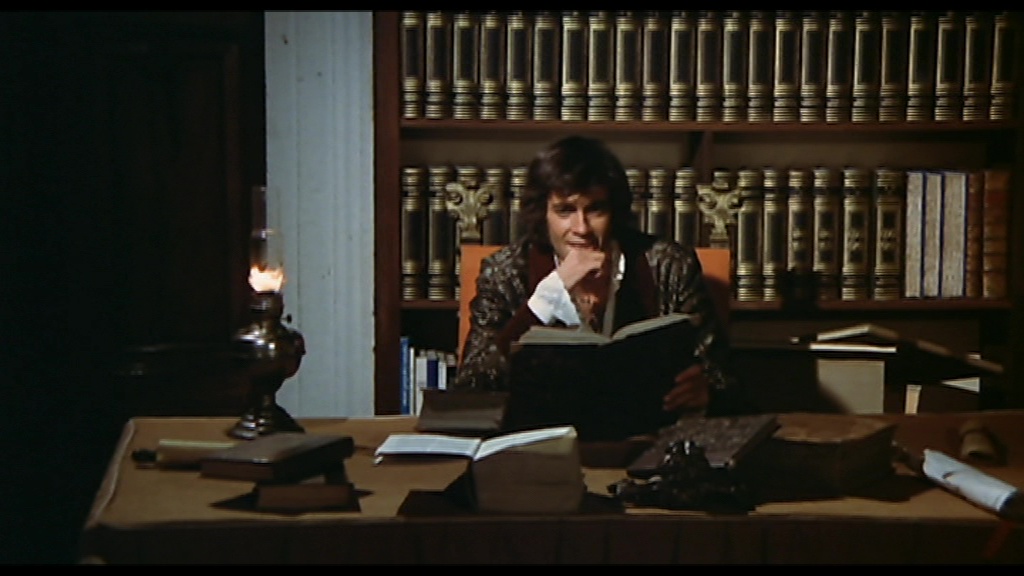
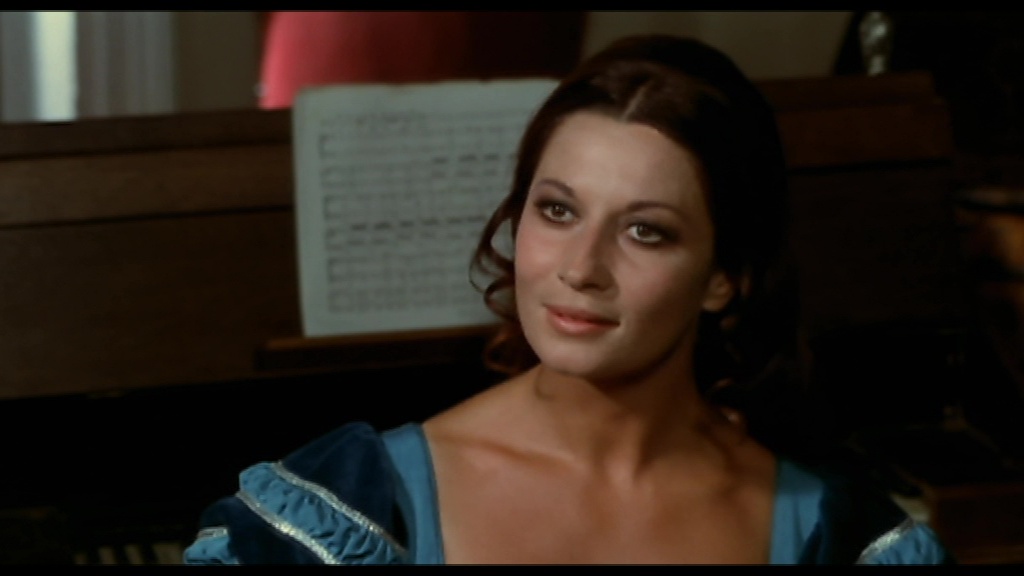
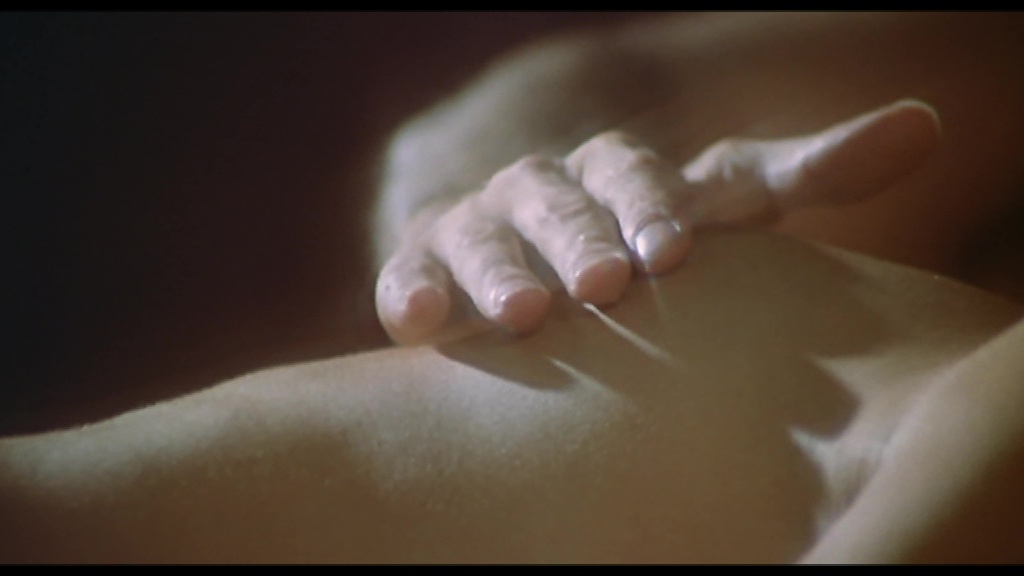
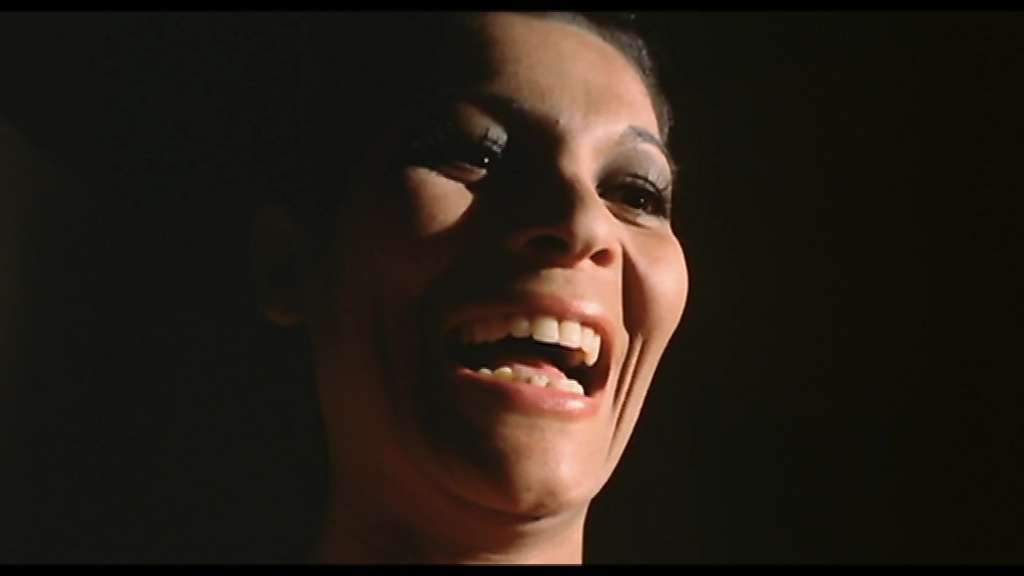
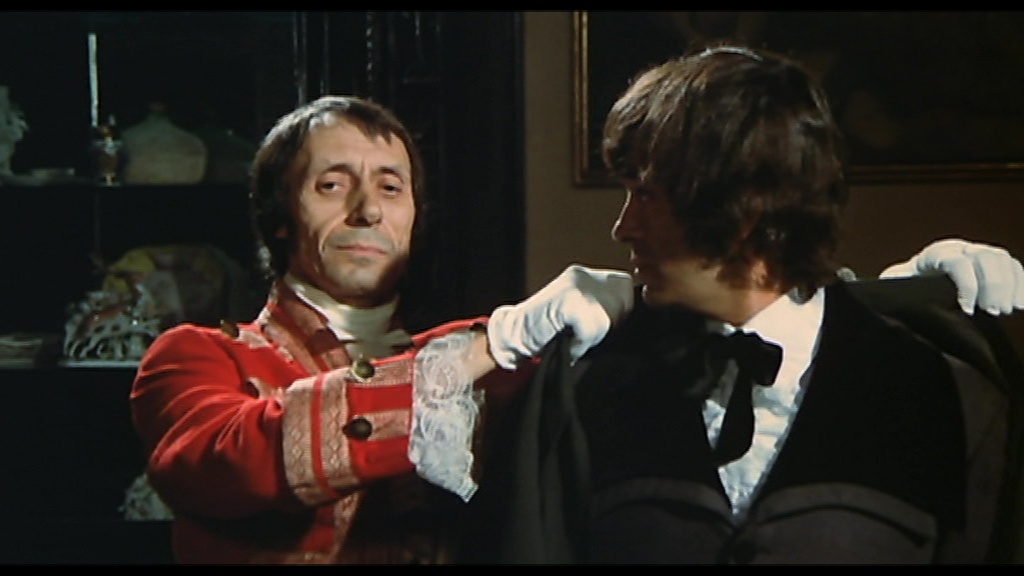
BABA YAGA: Severin (UHD)
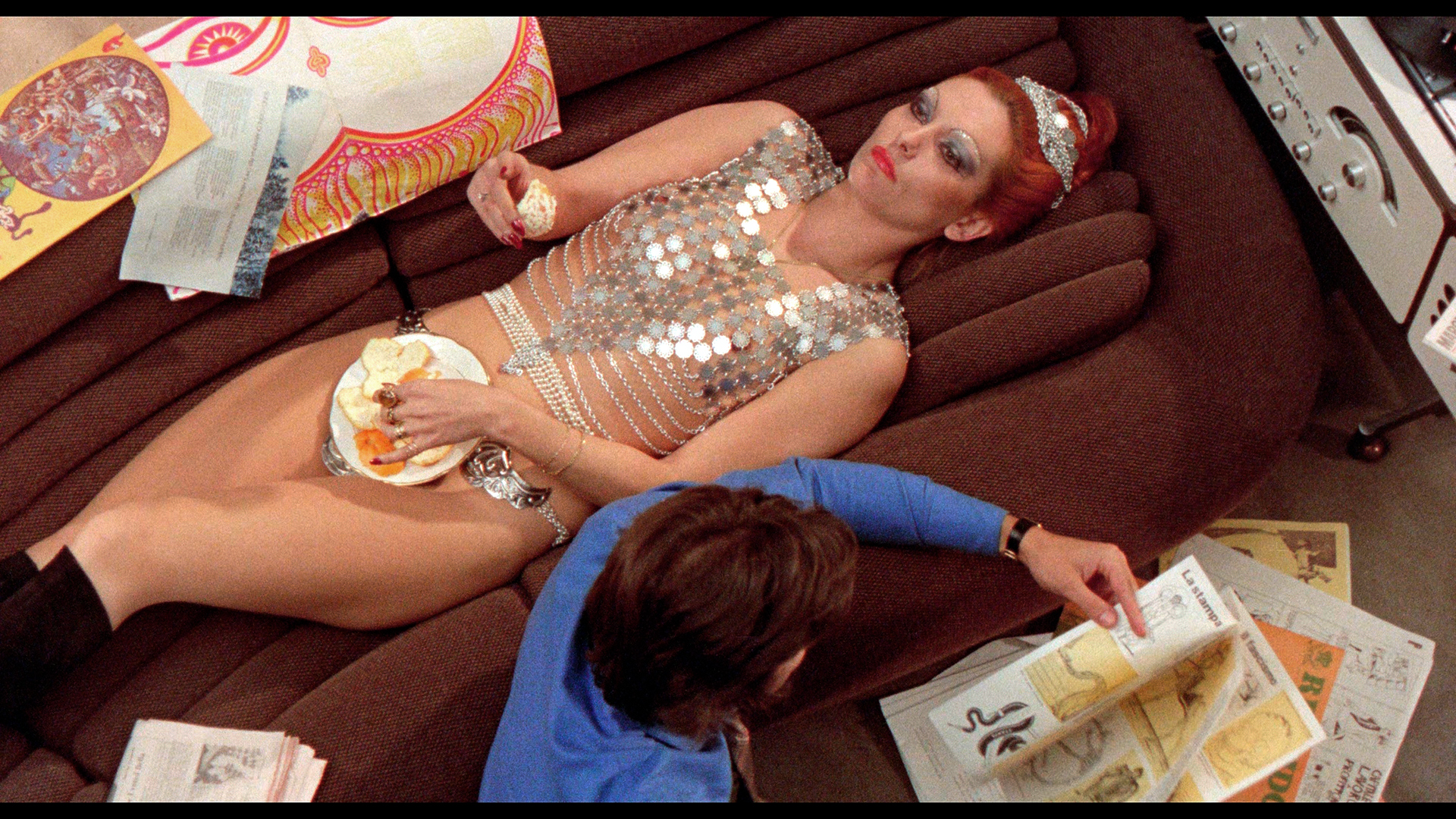
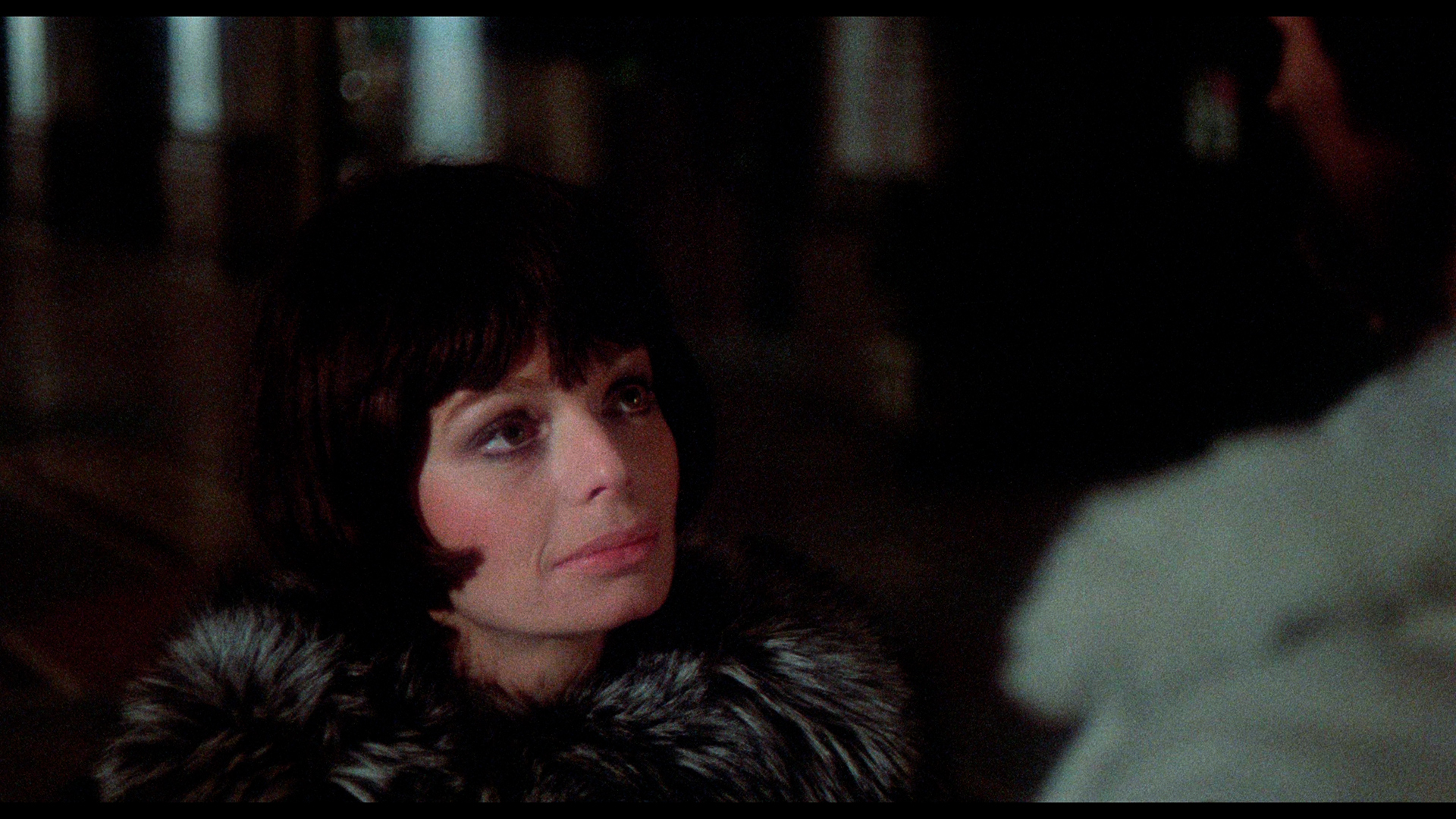
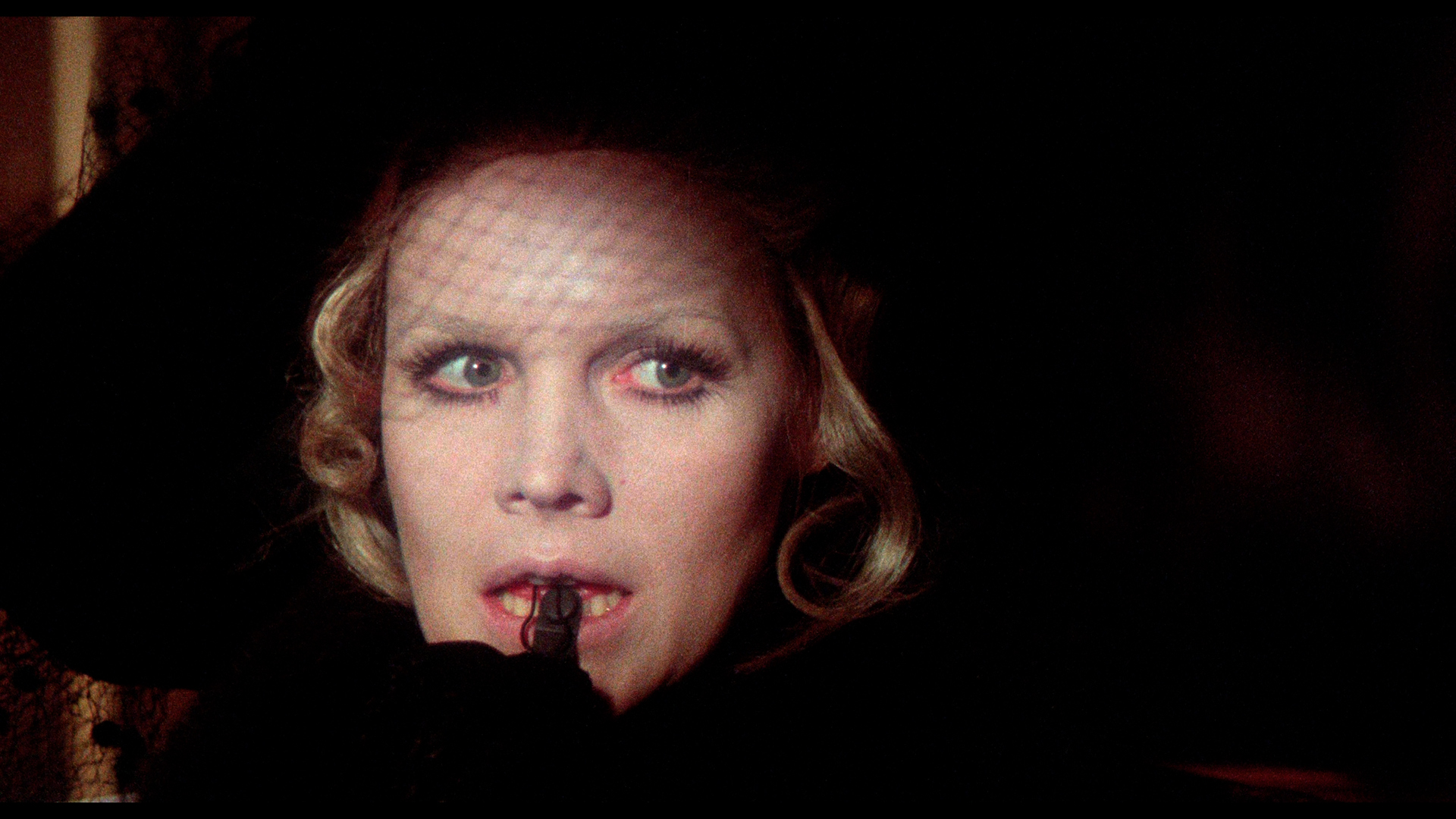
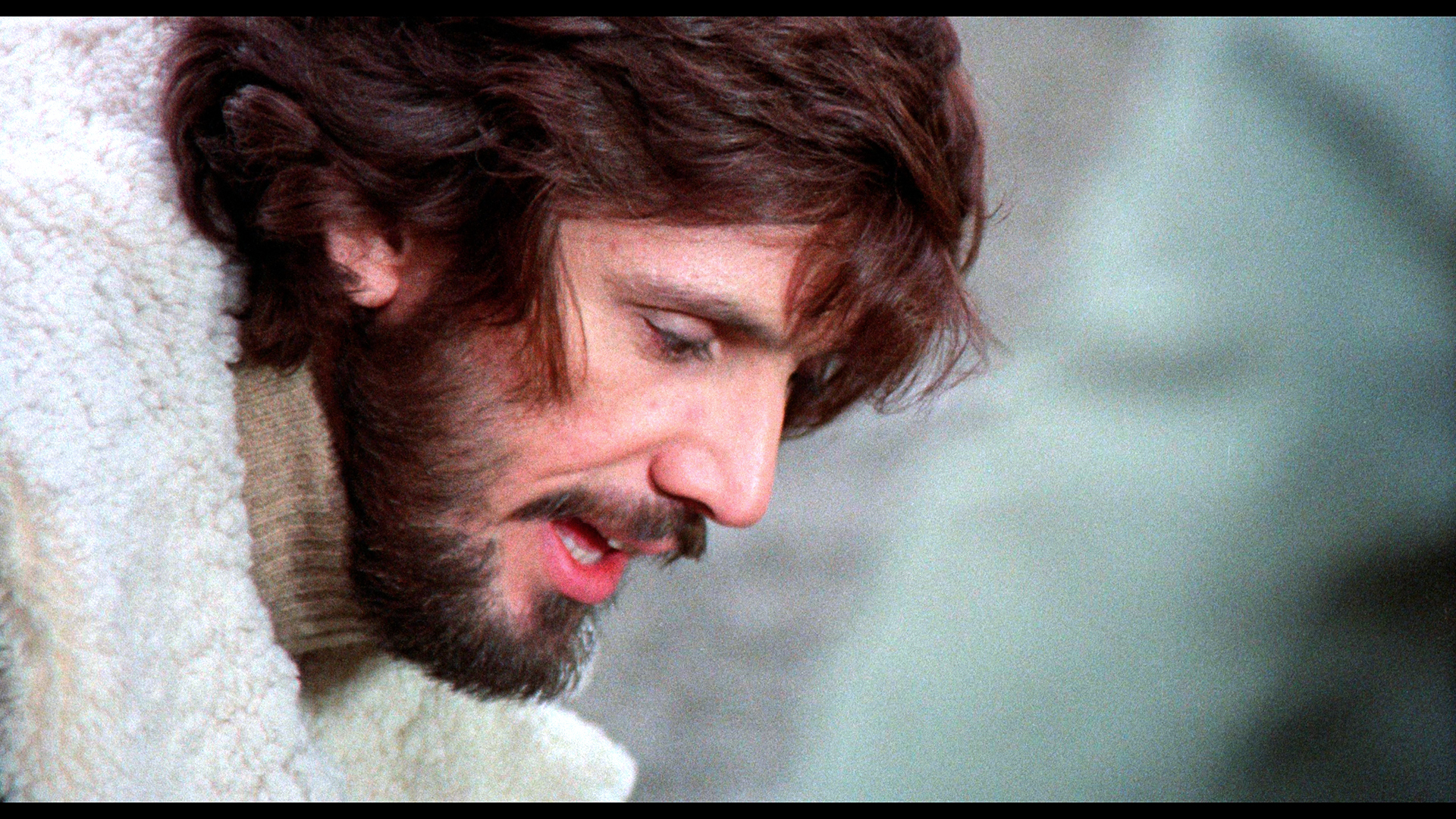
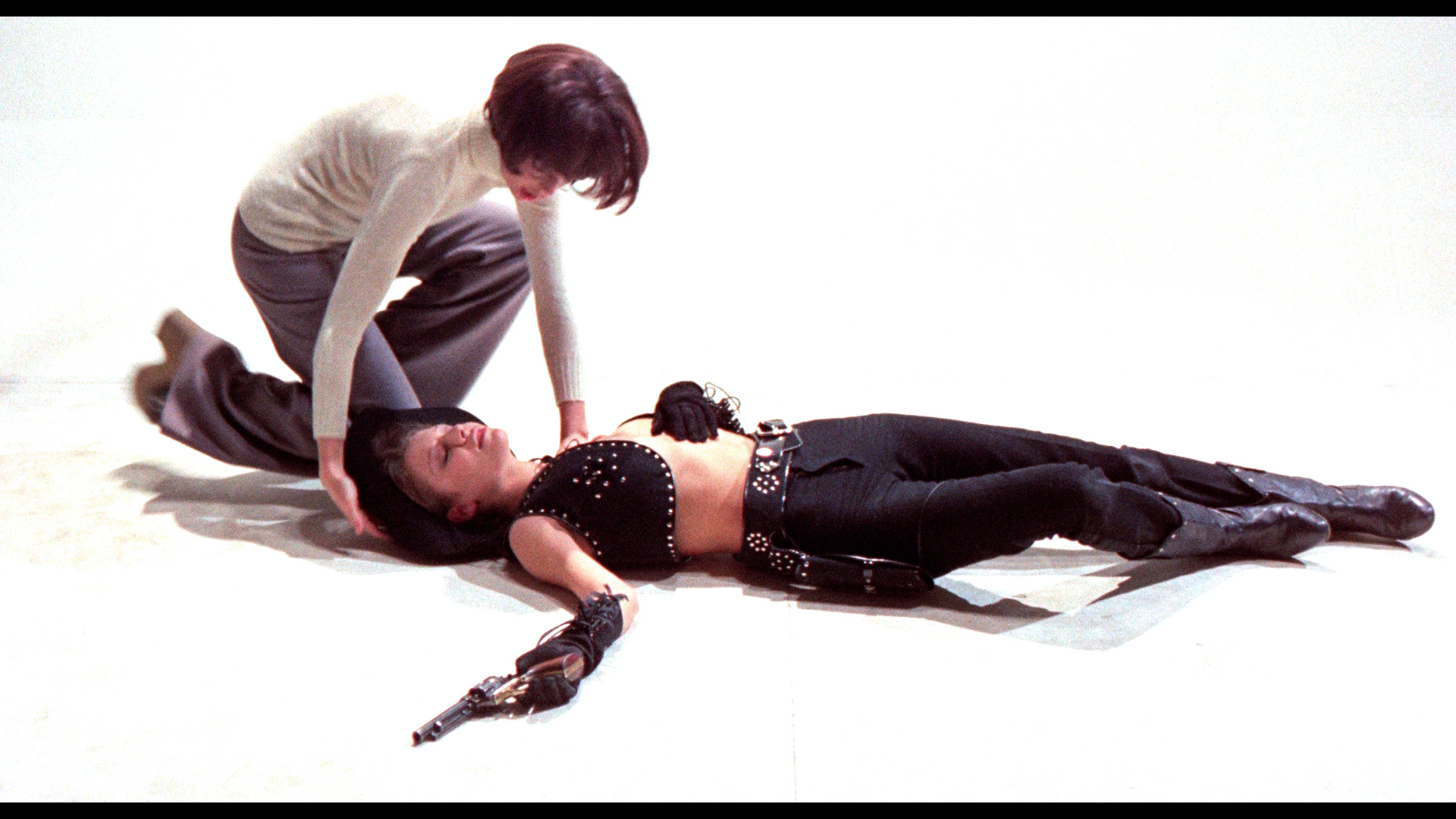
BABA YAGA: Blue Underground (Blu-ray)
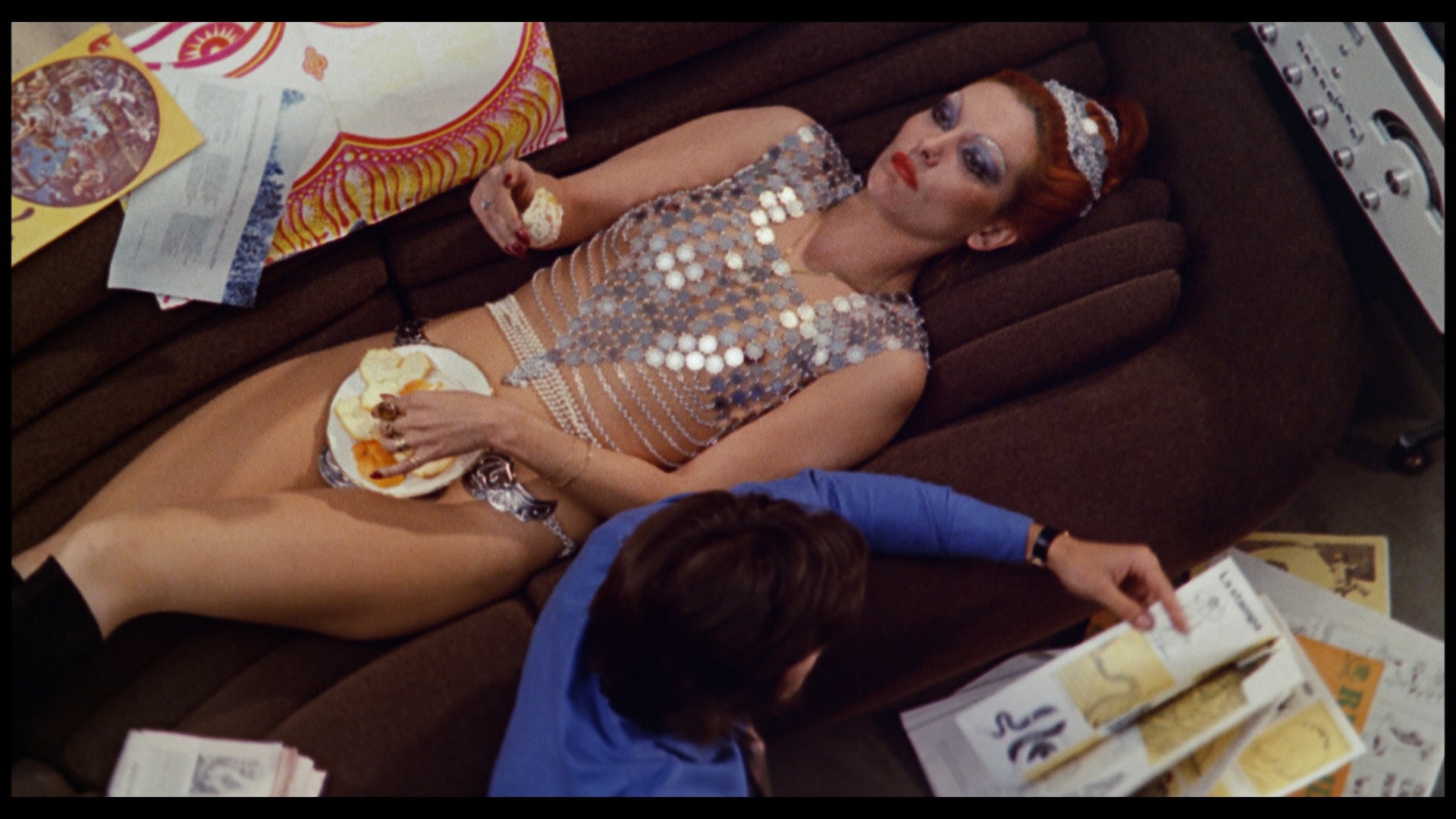
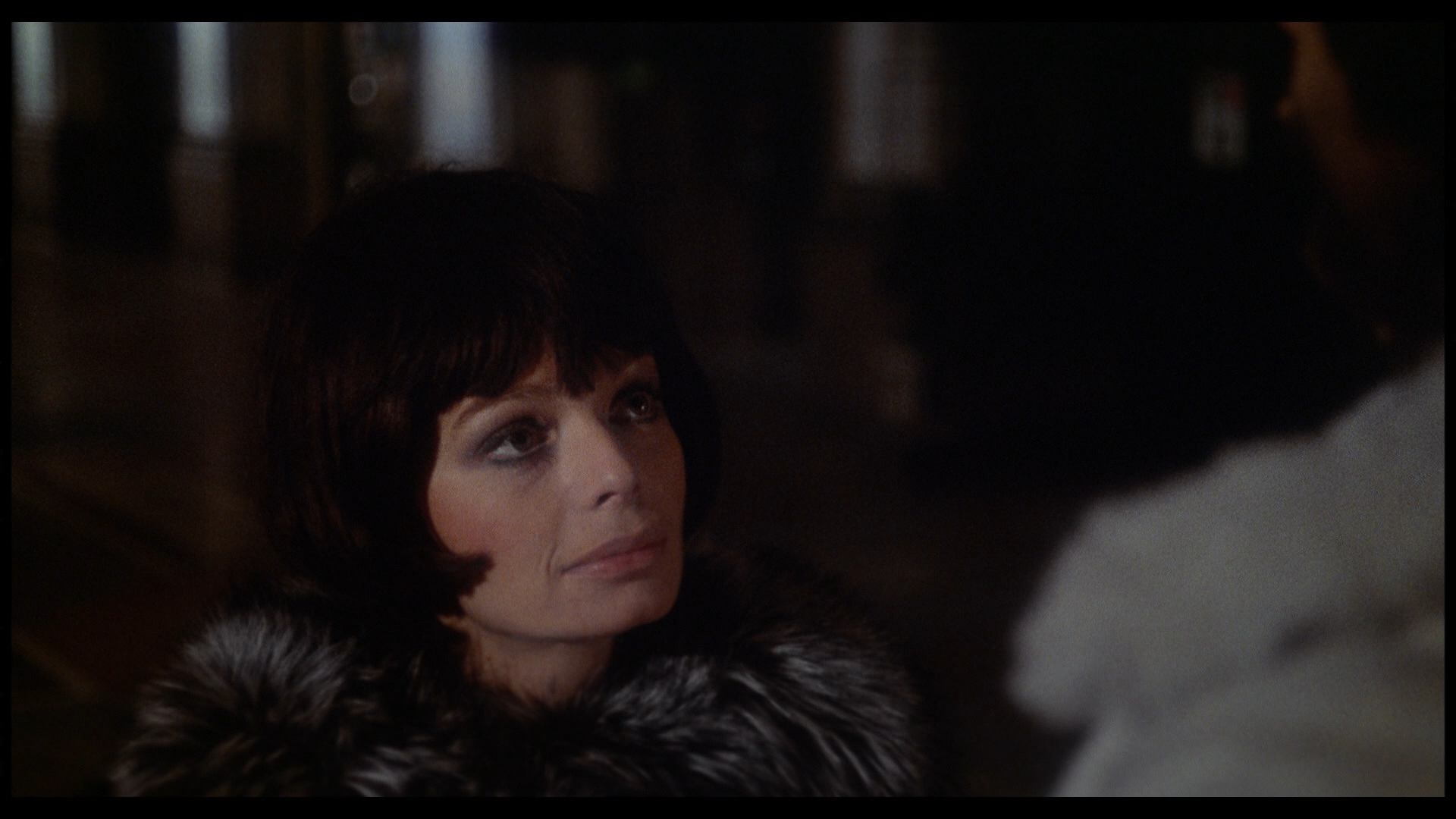
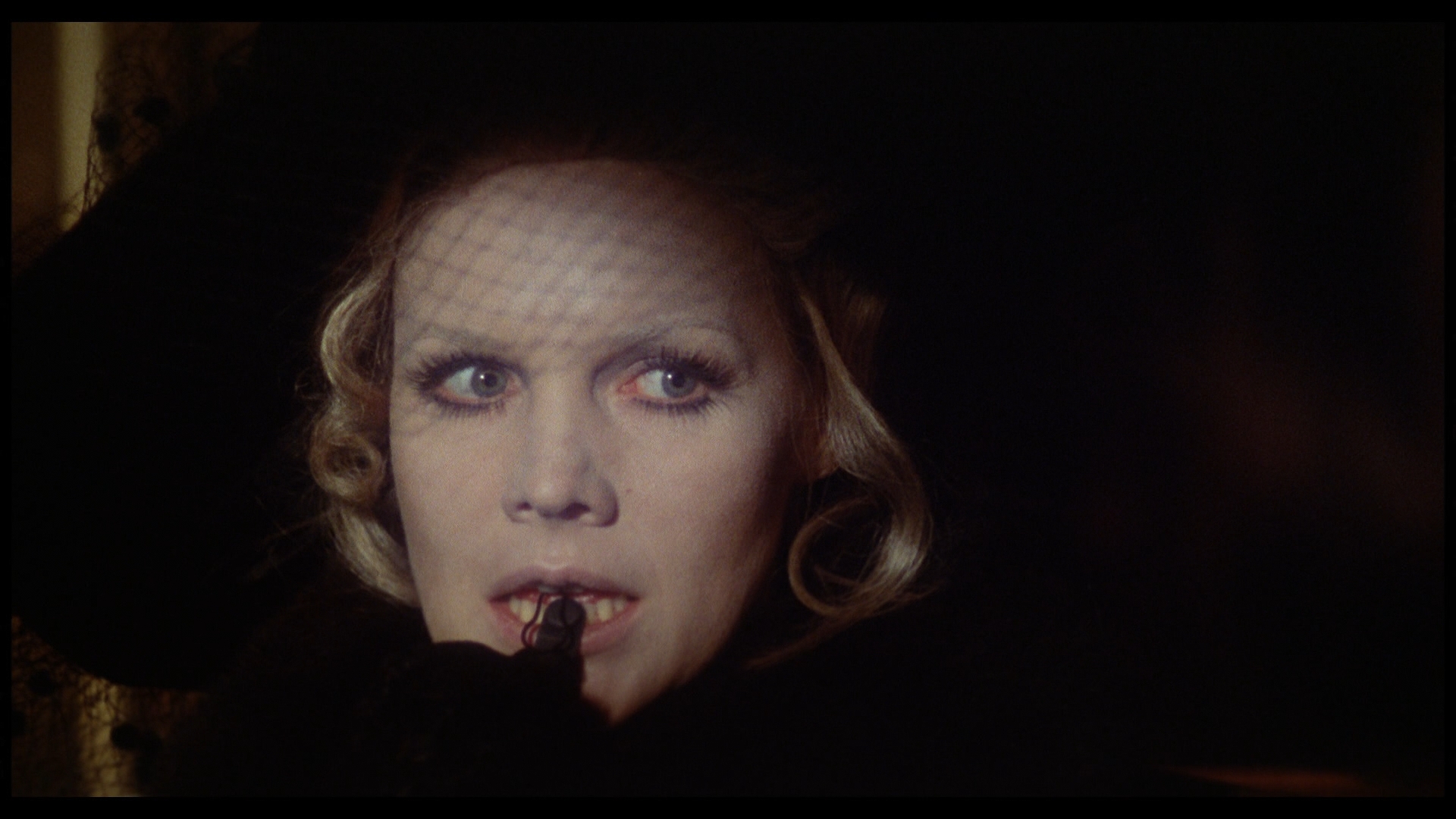
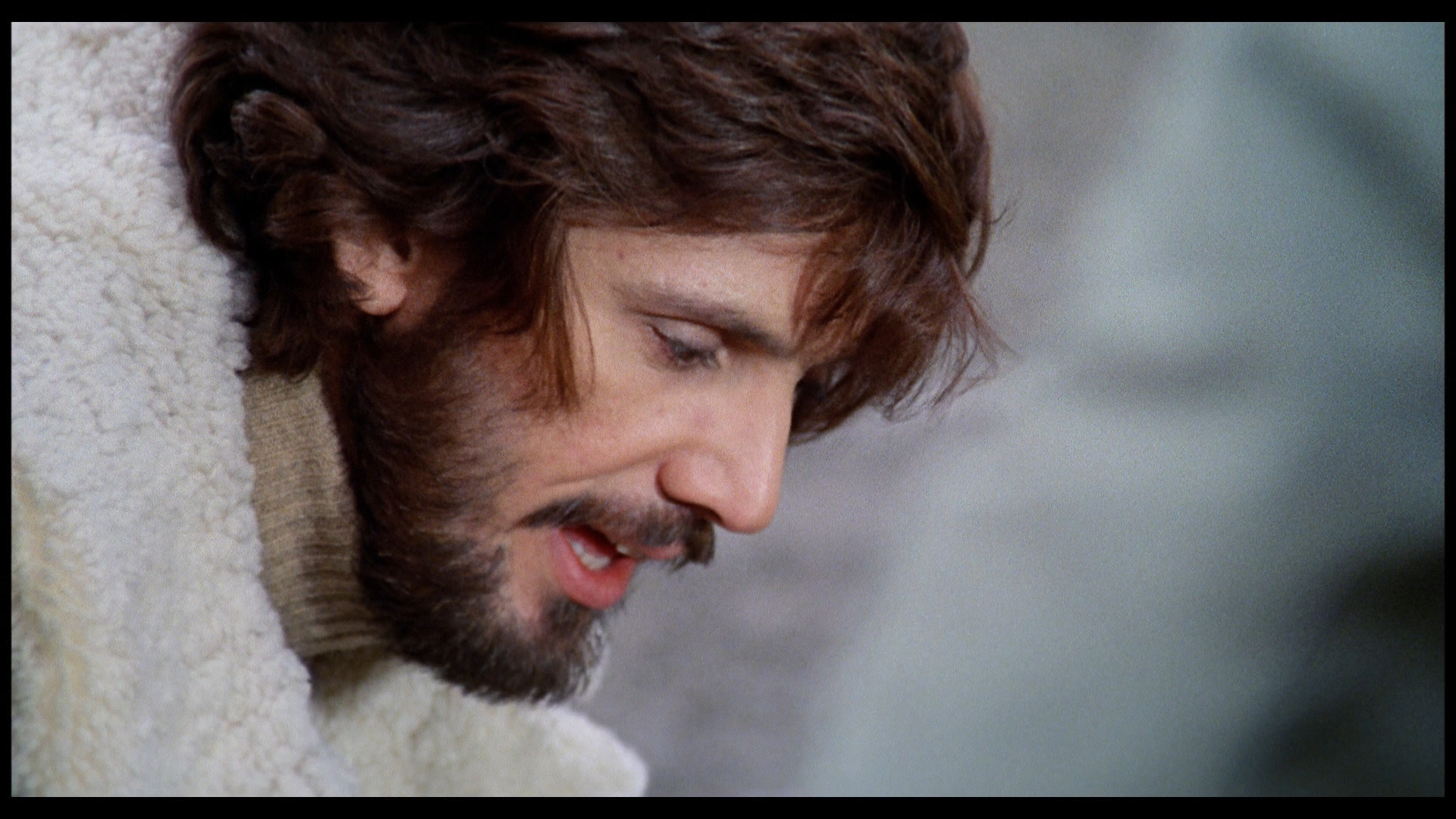
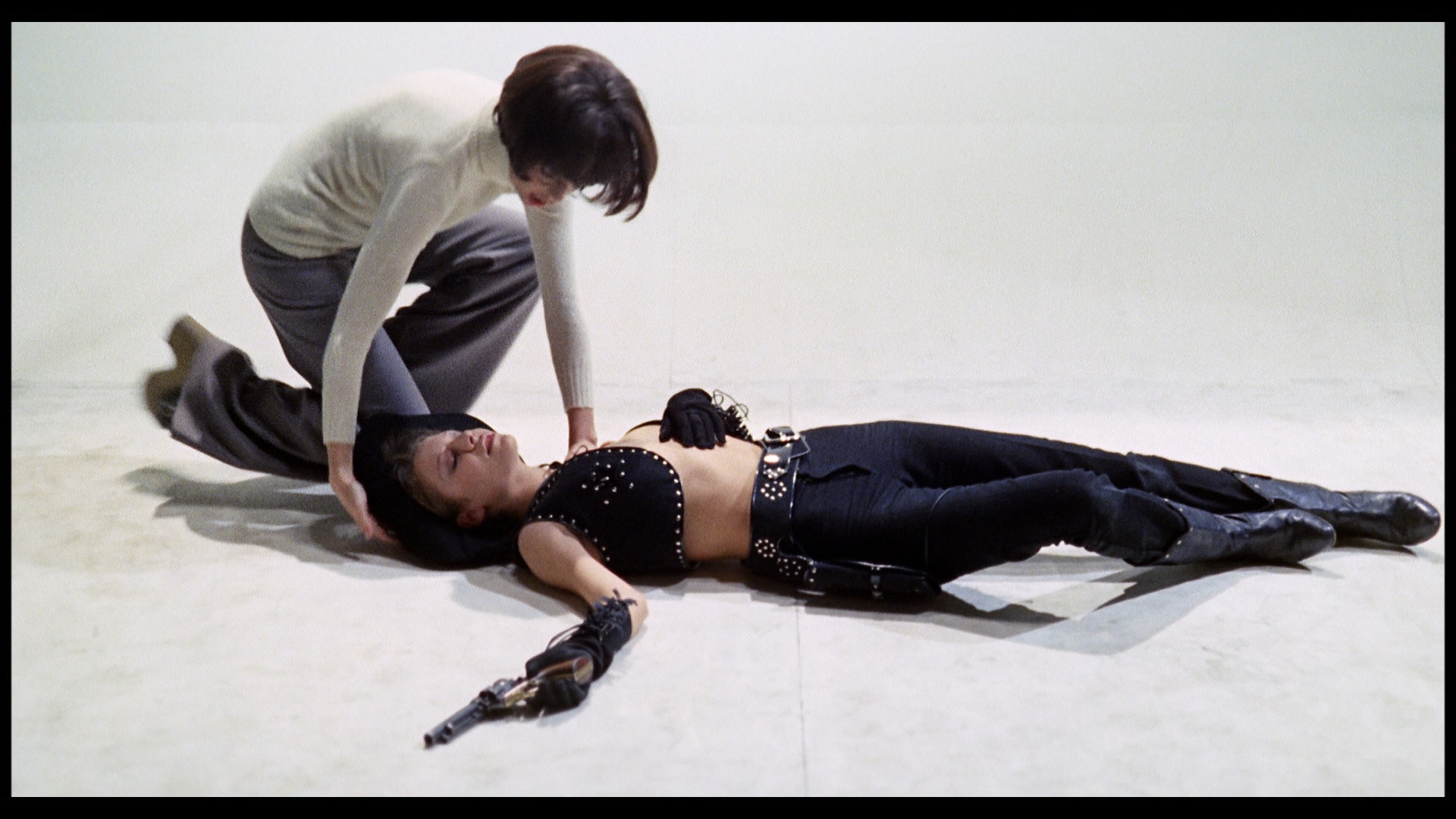
BABA YAGA: Shameless (DVD)
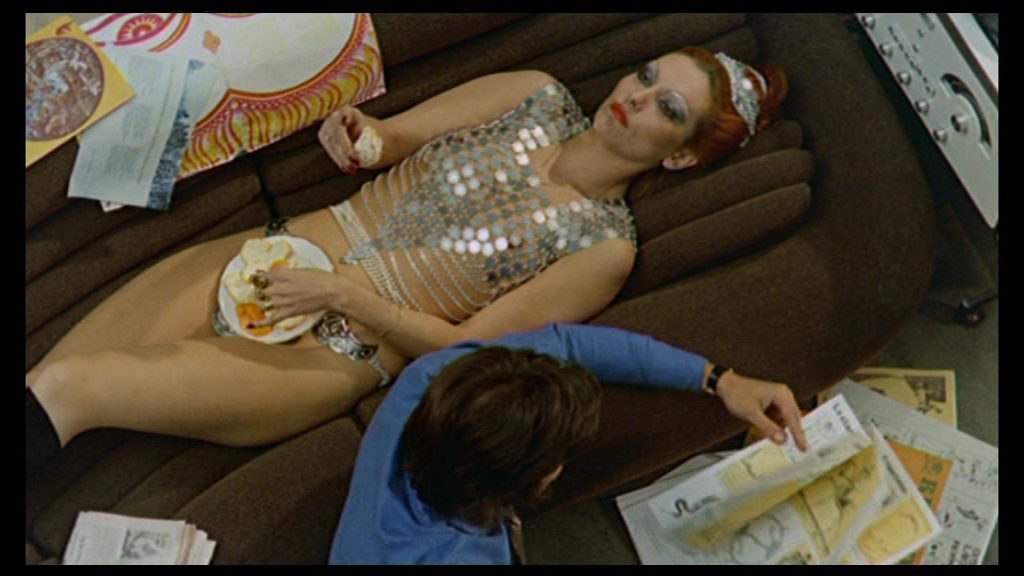
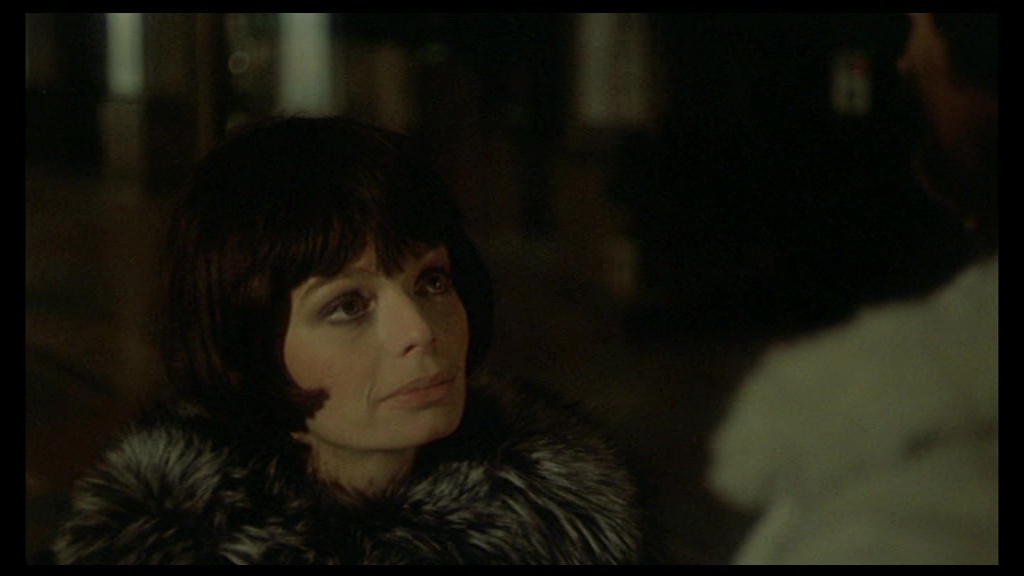
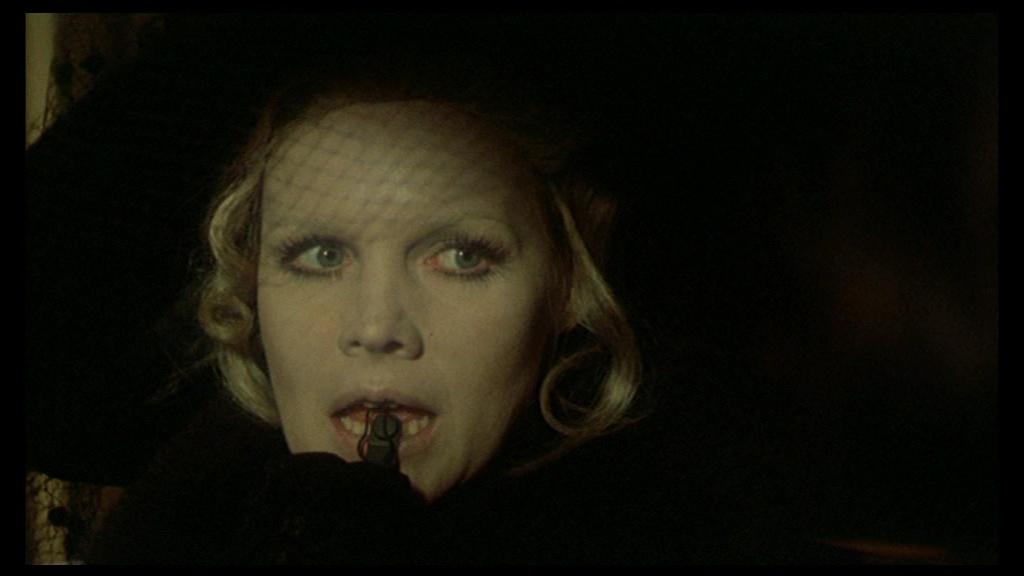
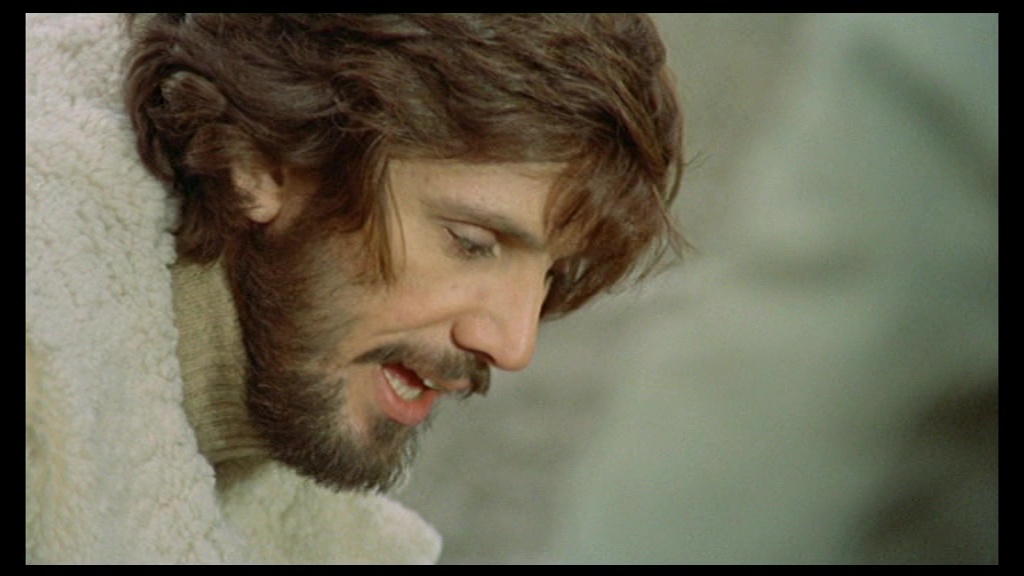
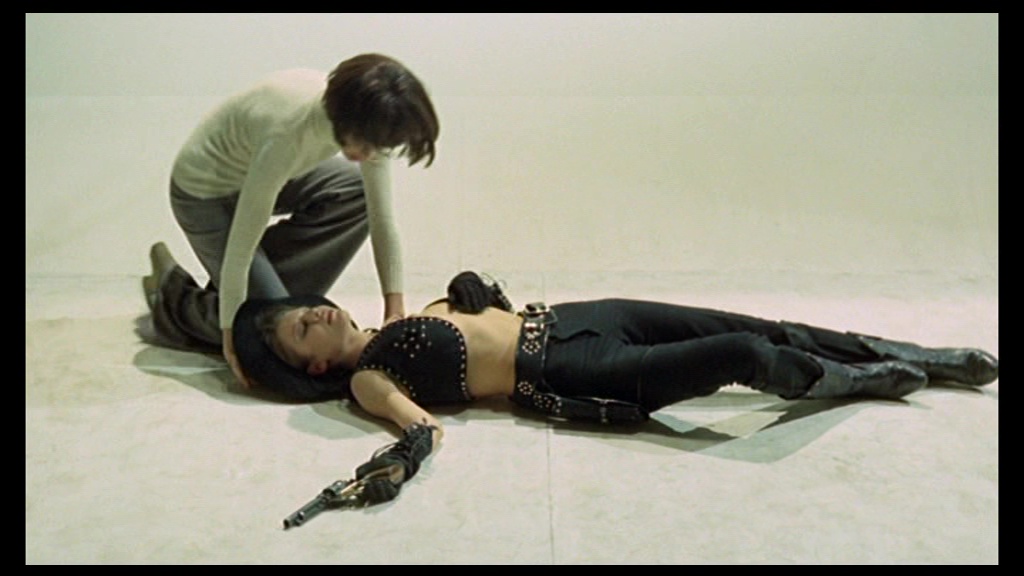
Reviewed on September 28, 2025



 Spain for its third entry, Severin Films' essential Danza Macabra series of Euro-Gothic tastiness
Spain for its third entry, Severin Films' essential Danza Macabra series of Euro-Gothic tastiness  returns to Italy with the fourth volume featuring three familiar but significantly upgraded titles and one rarity finally salvaged from gray market purgatory The set also serves as a nice tour of where Italian horror style evolved from the mid-'60s into the more debauched '70s, with the switch to color resulting in flamboyant spectacles whose reputations continue to escalate.
returns to Italy with the fourth volume featuring three familiar but significantly upgraded titles and one rarity finally salvaged from gray market purgatory The set also serves as a nice tour of where Italian horror style evolved from the mid-'60s into the more debauched '70s, with the switch to color resulting in flamboyant spectacles whose reputations continue to escalate.  up to newly arrived attorney
up to newly arrived attorney  Albert (The Vampire and the Ballerina's Brandi) to sort through all the perplexing clues and fatalities.
Albert (The Vampire and the Ballerina's Brandi) to sort through all the perplexing clues and fatalities. was said to be in the works for a U.S. release by Severin, which finally came to pass in 2025 as part of this four-film set either
was said to be in the works for a U.S. release by Severin, which finally came to pass in 2025 as part of this four-film set either  as a UHD and Blu-ray option or just Blu-ray. The UHD for Terror-Creatures and the first Blu-ray are devoted both cuts of the film in 4K scans from the negative, boasting far more detail and richer contrast than anything out there before. The Italian version can be played either completely in Italian with translated English subtitles or in English with subtitles appearing for the footage that exists only in Italian; that includes the opening couple of minutes, so don't be surprised. For some reason the UHD menu had issues loading up on an Oppo player for this review but no other similar reports seem to be out there, so it may be a one-off glitch. The Italian cut also comes with a new audio commentary with Rod Barnett and Adrian Smith who do a strong job of covering all the essentials of the film including Steele and the director, the skills of dubbing artist and actor Carolyn De Fonseca, connected Italian Gothics of the period, and more. The video extras are all on the second Blu-ray starting with "Grave Secrets" (26m15s) featuring actor Riccardo Garrone (who's hilariously candid and disparaging about the film) and film historian Fabio Melelli, plus audio interview extracts with Pupillo, which cover the production, the whole "Zucker" story, and takes on the film that can induce whiplash in their dramatic differences. Then you get a selected scene commentary with Steele and Russ Lanier (26m23s); as usual she opens up by saying she remembers very little about the film but chats in general about her time in Italy and France around that time. She does have tidbits about a few of the personnel though, naming a few favorites and chatting about the locale and Pupillo as a director. In "Grave Influence" (14m38s), The Vatican Versus Horror Movies author Matt Rogerson examines the links between this and other plague narratives like The Masque of the Red Death, the use of classic thriller elements like the dead but controlling patriarch, and other literary and cinematic antecedents. Finally in "The Original Boutique Video Label" (9m28s), Alan Jones looks back at the early pre-cert U.K. video label who brought numerous U.K. and Italian genre films to the public including this one and films by Peter Walker, Mario Bava,
as a UHD and Blu-ray option or just Blu-ray. The UHD for Terror-Creatures and the first Blu-ray are devoted both cuts of the film in 4K scans from the negative, boasting far more detail and richer contrast than anything out there before. The Italian version can be played either completely in Italian with translated English subtitles or in English with subtitles appearing for the footage that exists only in Italian; that includes the opening couple of minutes, so don't be surprised. For some reason the UHD menu had issues loading up on an Oppo player for this review but no other similar reports seem to be out there, so it may be a one-off glitch. The Italian cut also comes with a new audio commentary with Rod Barnett and Adrian Smith who do a strong job of covering all the essentials of the film including Steele and the director, the skills of dubbing artist and actor Carolyn De Fonseca, connected Italian Gothics of the period, and more. The video extras are all on the second Blu-ray starting with "Grave Secrets" (26m15s) featuring actor Riccardo Garrone (who's hilariously candid and disparaging about the film) and film historian Fabio Melelli, plus audio interview extracts with Pupillo, which cover the production, the whole "Zucker" story, and takes on the film that can induce whiplash in their dramatic differences. Then you get a selected scene commentary with Steele and Russ Lanier (26m23s); as usual she opens up by saying she remembers very little about the film but chats in general about her time in Italy and France around that time. She does have tidbits about a few of the personnel though, naming a few favorites and chatting about the locale and Pupillo as a director. In "Grave Influence" (14m38s), The Vatican Versus Horror Movies author Matt Rogerson examines the links between this and other plague narratives like The Masque of the Red Death, the use of classic thriller elements like the dead but controlling patriarch, and other literary and cinematic antecedents. Finally in "The Original Boutique Video Label" (9m28s), Alan Jones looks back at the early pre-cert U.K. video label who brought numerous U.K. and Italian genre films to the public including this one and films by Peter Walker, Mario Bava,  Lucio Fulci, Dario Argento, and
Lucio Fulci, Dario Argento, and  more. The U.S. and European trailers are also included in nice HD scans, the latter as Tombs of Horror and both trying their best to pass this off as an Edgar Allan Poe adaptation.
more. The U.S. and European trailers are also included in nice HD scans, the latter as Tombs of Horror and both trying their best to pass this off as an Edgar Allan Poe adaptation. mostly all-female coupling causing censorship issues at home when it was finished. The bootleg versions of this film came in just shy of 90 minutes, but the restored version here from the original negative is considerably longer and more explicit with
mostly all-female coupling causing censorship issues at home when it was finished. The bootleg versions of this film came in just shy of 90 minutes, but the restored version here from the original negative is considerably longer and more explicit with  several moments that push the definition of softcore very far for a '71 film. Incredibly, this release (the film's first legit commercial appearance, it would seem, not counting a sketchy Italian VHS) also throws in an even more graphic 14m18s reel of silent orgy outtakes... strictly for historical value, of course. It's very weird seeing a mainstream European star like Brice wandering around dark corridors and sleuthing in libraries while all this is going on, but that's also part of the fun.
several moments that push the definition of softcore very far for a '71 film. Incredibly, this release (the film's first legit commercial appearance, it would seem, not counting a sketchy Italian VHS) also throws in an even more graphic 14m18s reel of silent orgy outtakes... strictly for historical value, of course. It's very weird seeing a mainstream European star like Brice wandering around dark corridors and sleuthing in libraries while all this is going on, but that's also part of the fun. and sound good; the film was dubbed either way with the Italian version sounding more natural and classy. (Whether that's a selling point is up to your personal taste). Barnett and Troy Guinn do the commentary honors here, covering the film's low-budget creation, the evolution of its title and marginal release, the Eurocult credentials of the small cast and crew, and genre
and sound good; the film was dubbed either way with the Italian version sounding more natural and classy. (Whether that's a selling point is up to your personal taste). Barnett and Troy Guinn do the commentary honors here, covering the film's low-budget creation, the evolution of its title and marginal release, the Eurocult credentials of the small cast and crew, and genre  milestones that likely inspired it. "In the Castle of Saint Lambert (16m54s) features Fabio Melelli chatting about the film's creation at the height of the giallo craze, the background of the screenwriters, director Filippo Ratti, the nods to earlier literature, and intellectual credentials here that might surprise you and explain the role of Beaudelaire in the plot. In "The Desired and the Damned" (18m40s), Rogerson returns to examine the role of the witch in Italian genre films (Suspiria, Black Sunday, etc.) and this film's place in that distinctive lineage. An English-language trailer is also included.
milestones that likely inspired it. "In the Castle of Saint Lambert (16m54s) features Fabio Melelli chatting about the film's creation at the height of the giallo craze, the background of the screenwriters, director Filippo Ratti, the nods to earlier literature, and intellectual credentials here that might surprise you and explain the role of Beaudelaire in the plot. In "The Desired and the Damned" (18m40s), Rogerson returns to examine the role of the witch in Italian genre films (Suspiria, Black Sunday, etc.) and this film's place in that distinctive lineage. An English-language trailer is also included.  over to Italy to star in Black Sabbath and a slew of spaghetti westerns, is paired up with stunning giallo queen Rosalba Neri (billed here as "Sara Bay"). Familiar from such outings as Amuck, Slaughter Hotel,
over to Italy to star in Black Sabbath and a slew of spaghetti westerns, is paired up with stunning giallo queen Rosalba Neri (billed here as "Sara Bay"). Familiar from such outings as Amuck, Slaughter Hotel,  and Lady Frankenstein, she's a force to be reckoned with here as a sort of Elizabeth Bathory figure who holds unholy ceremonies every five decades on the Night of the Virgin Moon (the source of the film's Italian title, Il plenilunio delle vergini), when a quintet of local, undefiled maidens convene for a demonic ritual.
and Lady Frankenstein, she's a force to be reckoned with here as a sort of Elizabeth Bathory figure who holds unholy ceremonies every five decades on the Night of the Virgin Moon (the source of the film's Italian title, Il plenilunio delle vergini), when a quintet of local, undefiled maidens convene for a demonic ritual.  poured all over her. Damon doesn't get to show
poured all over her. Damon doesn't get to show  much range in either role, but it hardly matters as the film ladles on the exploitation like gravy complete with an aggressive music score by Vasili Kojucharov (Byleth), workmanlike but sometimes moody cinematography by the one and only Joe D'Amato, and a bizarre turn by Frankenstein's Castle of Freaks' Xiro Papas as a sort of vampire zombie monstery thingy.
much range in either role, but it hardly matters as the film ladles on the exploitation like gravy complete with an aggressive music score by Vasili Kojucharov (Byleth), workmanlike but sometimes moody cinematography by the one and only Joe D'Amato, and a bizarre turn by Frankenstein's Castle of Freaks' Xiro Papas as a sort of vampire zombie monstery thingy. nice overall with a '70s grittiness to the textures, while black levels are nice and deep as they should be with those eye-popping
nice overall with a '70s grittiness to the textures, while black levels are nice and deep as they should be with those eye-popping  shades of ruby red looking particularly nice. Two reels display a thin line of orange-colored damage popping in and out a few times, most egregiously around the 36-minute mark. The English track, which works pretty well since that's what almost everyone spoke even if they were looped later, is presented in DTS-HD MA 2.0 mono and sounds okay as well. The film can be played in a "Katarina's Bucket List" mode with hostess Katarina Leigh Waters as both herself and her twin (of course), trying to find directions through the woods and taking possession of a really big ring before supplying the usual rundown of the major players in front of and behind the camera. She also has to deal with diabolical foodstuff, and that errant Japanese footage turns up tucked away at the end as well.
shades of ruby red looking particularly nice. Two reels display a thin line of orange-colored damage popping in and out a few times, most egregiously around the 36-minute mark. The English track, which works pretty well since that's what almost everyone spoke even if they were looped later, is presented in DTS-HD MA 2.0 mono and sounds okay as well. The film can be played in a "Katarina's Bucket List" mode with hostess Katarina Leigh Waters as both herself and her twin (of course), trying to find directions through the woods and taking possession of a really big ring before supplying the usual rundown of the major players in front of and behind the camera. She also has to deal with diabolical foodstuff, and that errant Japanese footage turns up tucked away at the end as well.
 dedication Damon brought to his performance(s), Neri's busy career at the time, the odd vampire elements here indebted to Stoker onward, and of course, the Italian horror milestones that paved the way for this, and more. In "Countess Rosalba" (12m58s), Neri briefly covers her path to acting including her school and TV commercial work before talking about being a sailor around the time she made this film (and for which she would ultimately turn to instead of acting), the ideas she brought on the set like illuminating her magic ring with a light, and memories of her collaborators including her multiple productions with D'Amato (a.k.a. Aristide Massachessi). In fact, that's who pops up next in "The Wedding Guest" (4m7s) to talk about his early work as a cinematographer, his move into directing with portions of The Arena (also with Neri), his collaboration with Batzella (credited as "Paolo Solvay"), and his assessment of Neri as a "poor man's Barbara Steele," which is... highly debatable! Then producer Franco Gaudenzi appears in "The Wedding Tale" (12m53s) to cover this film in context with the more daunting The Arena, Damon's heavy involvement in getting this film off the ground ("basically a Dracula movie"), and being insistent on keeping D'Amato on board to shoot it. Alexandra Heller-Nicholas delivers "An Open Letter to Rosalba Neri's Tits" (11m15s), followed by the English-language European and U.S. trailers.
dedication Damon brought to his performance(s), Neri's busy career at the time, the odd vampire elements here indebted to Stoker onward, and of course, the Italian horror milestones that paved the way for this, and more. In "Countess Rosalba" (12m58s), Neri briefly covers her path to acting including her school and TV commercial work before talking about being a sailor around the time she made this film (and for which she would ultimately turn to instead of acting), the ideas she brought on the set like illuminating her magic ring with a light, and memories of her collaborators including her multiple productions with D'Amato (a.k.a. Aristide Massachessi). In fact, that's who pops up next in "The Wedding Guest" (4m7s) to talk about his early work as a cinematographer, his move into directing with portions of The Arena (also with Neri), his collaboration with Batzella (credited as "Paolo Solvay"), and his assessment of Neri as a "poor man's Barbara Steele," which is... highly debatable! Then producer Franco Gaudenzi appears in "The Wedding Tale" (12m53s) to cover this film in context with the more daunting The Arena, Damon's heavy involvement in getting this film off the ground ("basically a Dracula movie"), and being insistent on keeping D'Amato on board to shoot it. Alexandra Heller-Nicholas delivers "An Open Letter to Rosalba Neri's Tits" (11m15s), followed by the English-language European and U.S. trailers.  fashion photographer Valentina (de Funès, niece of French comedy film legend Louis de Funès) indulges in a swinging lifestyle of excess and delight with her latest colleague and sex
fashion photographer Valentina (de Funès, niece of French comedy film legend Louis de Funès) indulges in a swinging lifestyle of excess and delight with her latest colleague and sex  partner, Arno (Eastman, the Anthropophagus monster himself). One night she happens upon a wounded dog in the street and is approached by the chic and mysterious Baba Yaga (Baker), a blonde society woman in a limo. Later Baba shows up at Valentina's apartment during an erotic photo shoot and puts a strange curse on her camera. Faster than you can say Eyes of Laura Mars, Valentina is plagued by strange visions involving a leather-strapped doll that turns into a dominatrix succubus (Five Dolls for an August Moon's Galleani) and finds herself drawn to the house of this bewitching woman, who harbors more than a few kinky supernatural secrets of her own.
partner, Arno (Eastman, the Anthropophagus monster himself). One night she happens upon a wounded dog in the street and is approached by the chic and mysterious Baba Yaga (Baker), a blonde society woman in a limo. Later Baba shows up at Valentina's apartment during an erotic photo shoot and puts a strange curse on her camera. Faster than you can say Eyes of Laura Mars, Valentina is plagued by strange visions involving a leather-strapped doll that turns into a dominatrix succubus (Five Dolls for an August Moon's Galleani) and finds herself drawn to the house of this bewitching woman, who harbors more than a few kinky supernatural secrets of her own.  Guido Crepax. That said, Baker - sometimes made up to look older
Guido Crepax. That said, Baker - sometimes made up to look older  than she really was at the time in a role originally intended for Anne Heywood, who bailed three days before filming - is a compelling presence as always and even dubs in her own voice.
than she really was at the time in a role originally intended for Anne Heywood, who bailed three days before filming - is a compelling presence as always and even dubs in her own voice. Ferreri would've been proud) and some surprising deleted frontal nudity from both of the leading ladies. You also get a
Ferreri would've been proud) and some surprising deleted frontal nudity from both of the leading ladies. You also get a  12-minute short film about Crepax called "Freud in Color," the European trailer, a poster and still gallery, and a DVD-Rom comic-to-film comparison.
12-minute short film about Crepax called "Freud in Color," the European trailer, a poster and still gallery, and a DVD-Rom comic-to-film comparison.
 some of those scenes in Baba Yaga's lair have always been on the murky side), but it's nice to see it bumped up a few notches in quality. For the most part film grain looks fine throughout (and way more natural than the DVD), though a handful of shots look a little slicked down, like when Valentina first crouches down over the dog in the road. It's definitely on the better side of Italian-sourced HD transfers of late though and marks a substantial upgrade across the board. Interestingly, there's also a sliver more information on the left side of the frame and an equally minuscule amount missing on the right, for whatever reason. The audio options are also substantially beefed up here, with both the English and (for the first time in America) the Italian track provided in DTS-HD mono. Two optional English subtitles are provided, one for the English track and another, very different one translating the Italian dialogue; try
some of those scenes in Baba Yaga's lair have always been on the murky side), but it's nice to see it bumped up a few notches in quality. For the most part film grain looks fine throughout (and way more natural than the DVD), though a handful of shots look a little slicked down, like when Valentina first crouches down over the dog in the road. It's definitely on the better side of Italian-sourced HD transfers of late though and marks a substantial upgrade across the board. Interestingly, there's also a sliver more information on the left side of the frame and an equally minuscule amount missing on the right, for whatever reason. The audio options are also substantially beefed up here, with both the English and (for the first time in America) the Italian track provided in DTS-HD mono. Two optional English subtitles are provided, one for the English track and another, very different one translating the Italian dialogue; try  flipping back and forth between the two for some interesting comparisons. Again, it's really a draw which one you listen to first, as they both have their merits. Additional subtitles are also provided in French and Spanish. Extras are identical to the prior DVD (and standard def), except the comic-to-film comparison is now its own step-through feature instead of a DVD-Rom bonus.
flipping back and forth between the two for some interesting comparisons. Again, it's really a draw which one you listen to first, as they both have their merits. Additional subtitles are also provided in French and Spanish. Extras are identical to the prior DVD (and standard def), except the comic-to-film comparison is now its own step-through feature instead of a DVD-Rom bonus.![]()